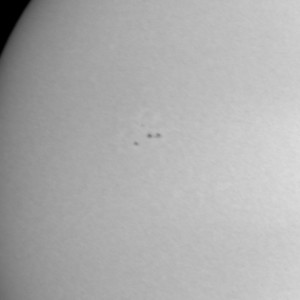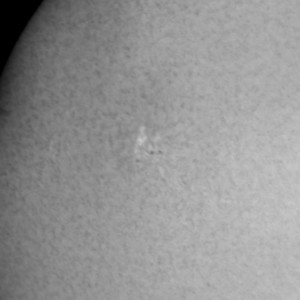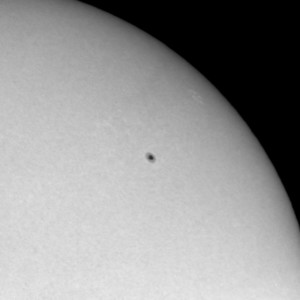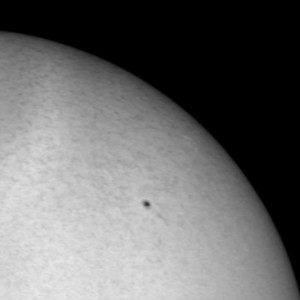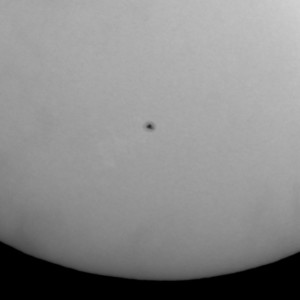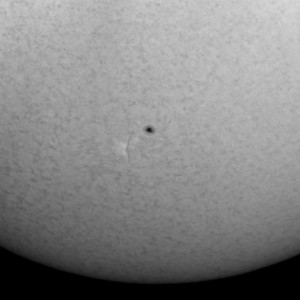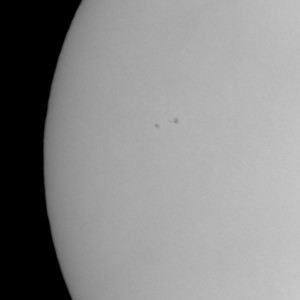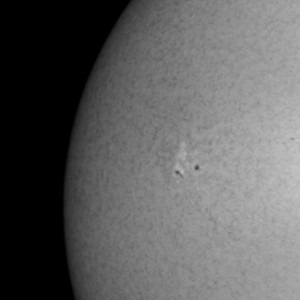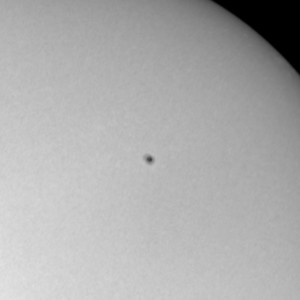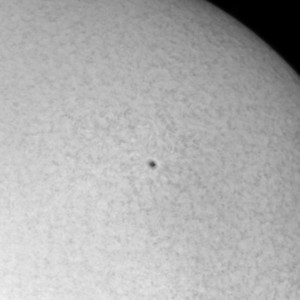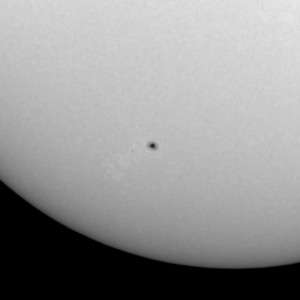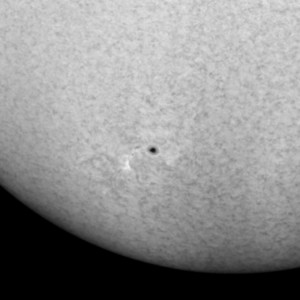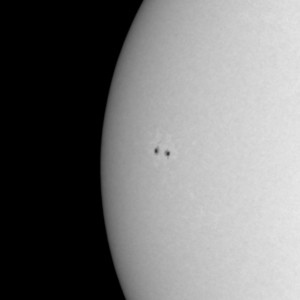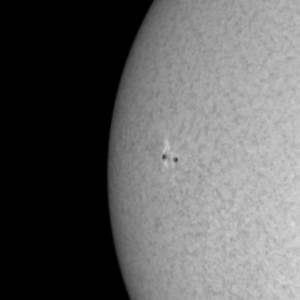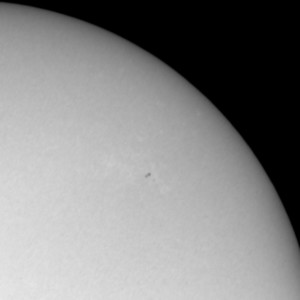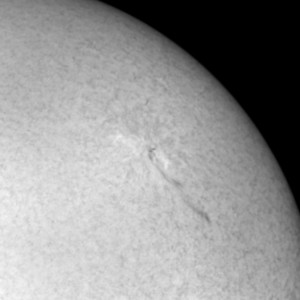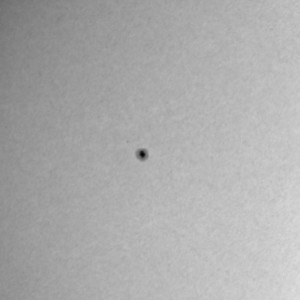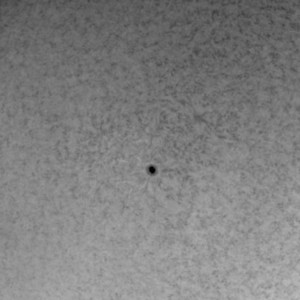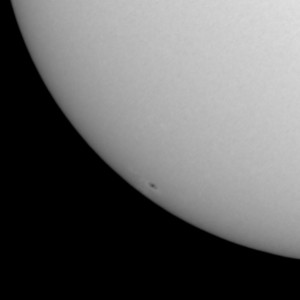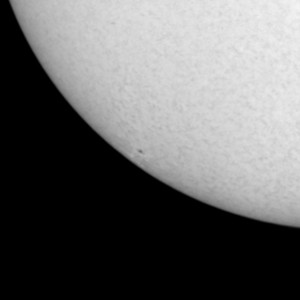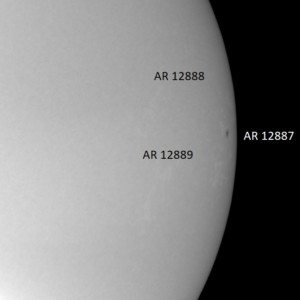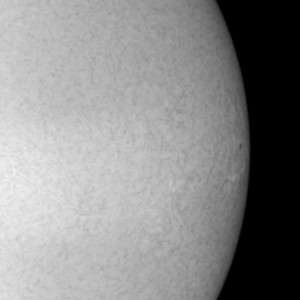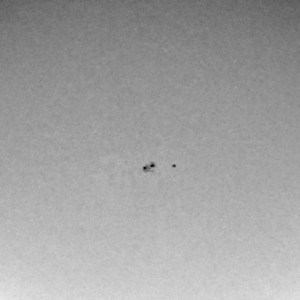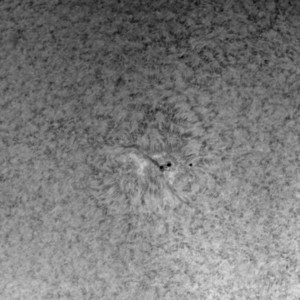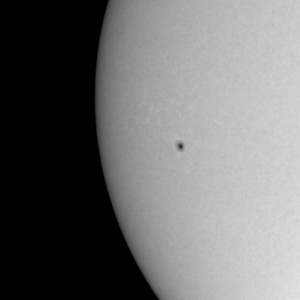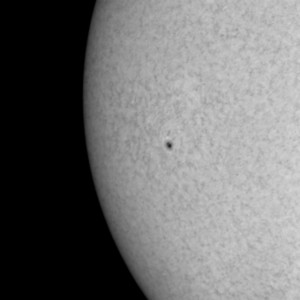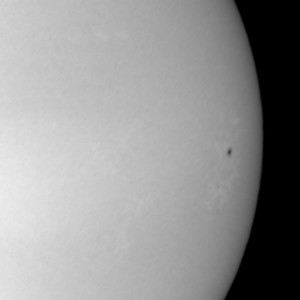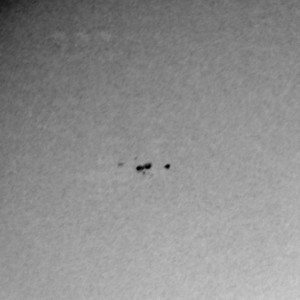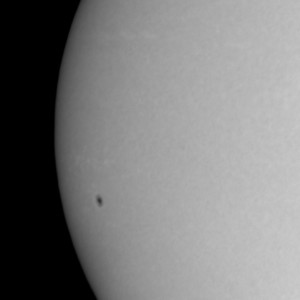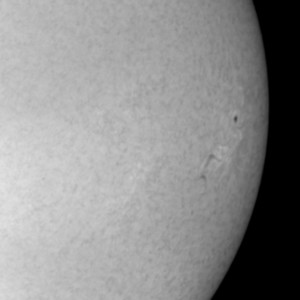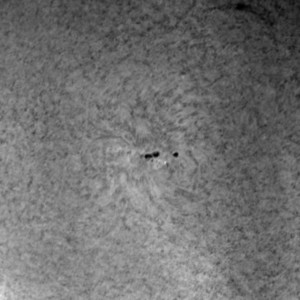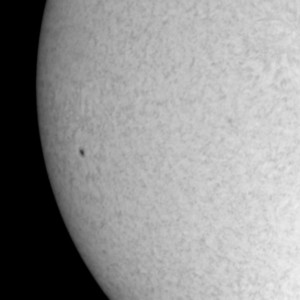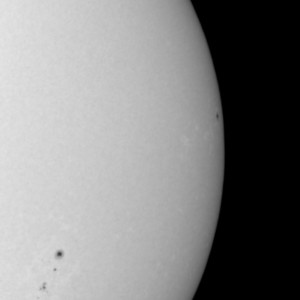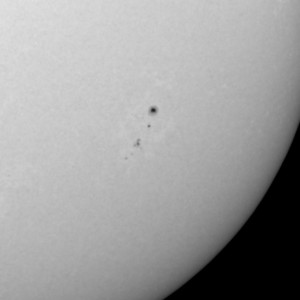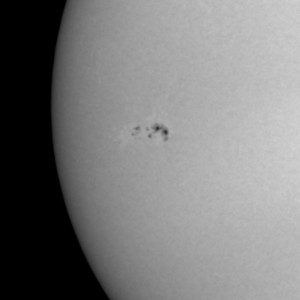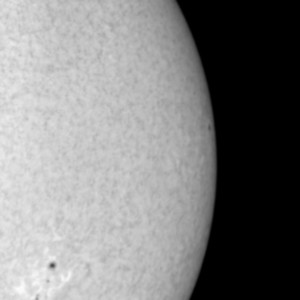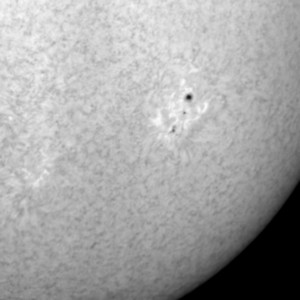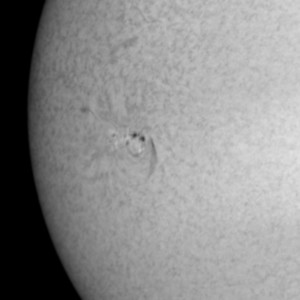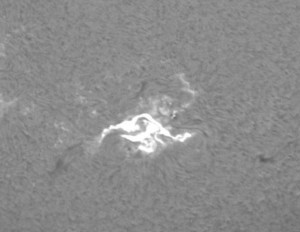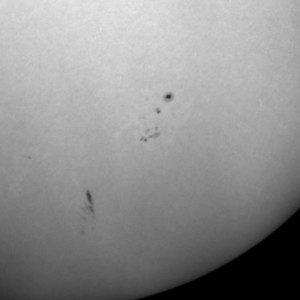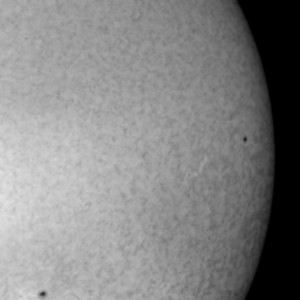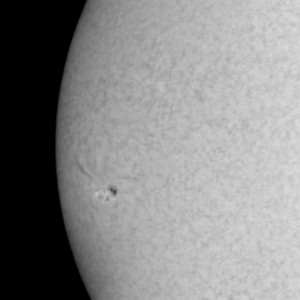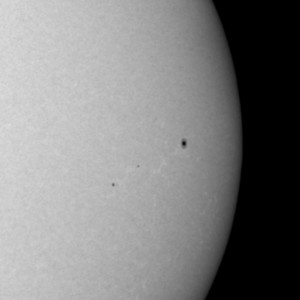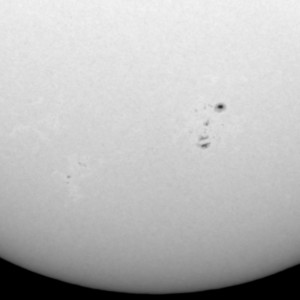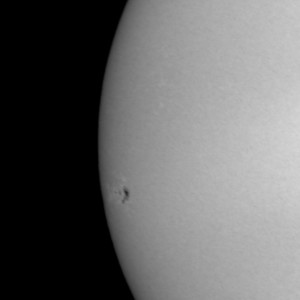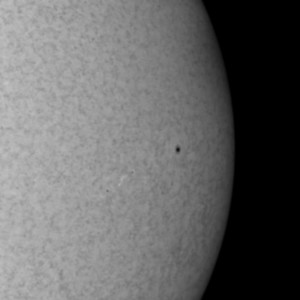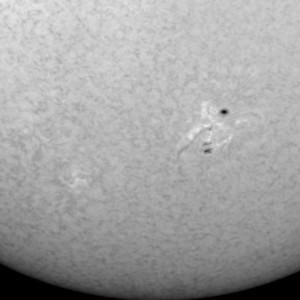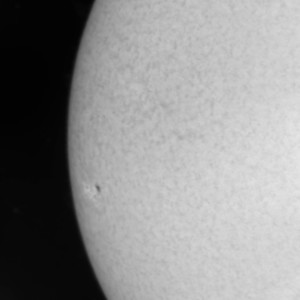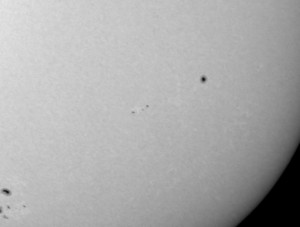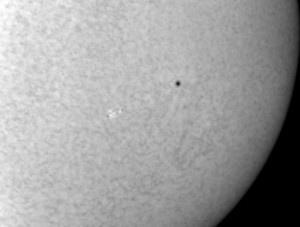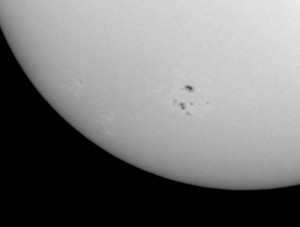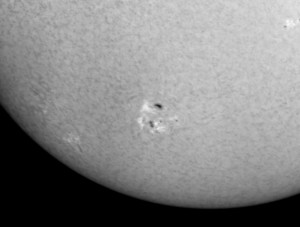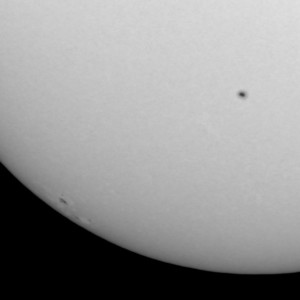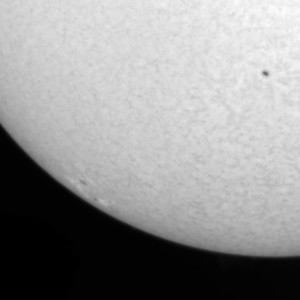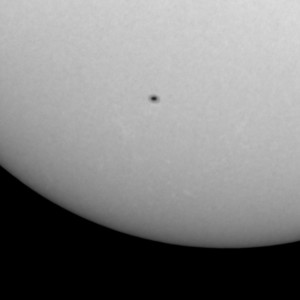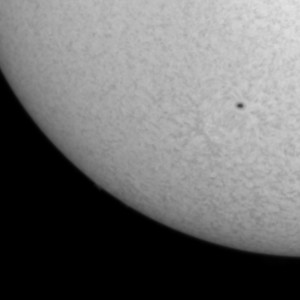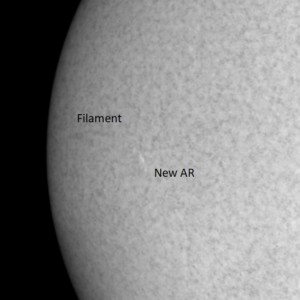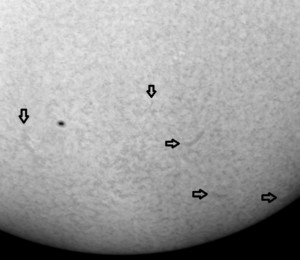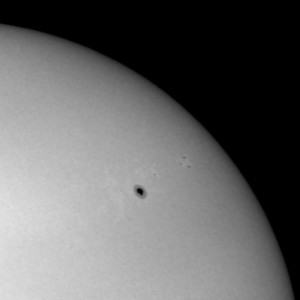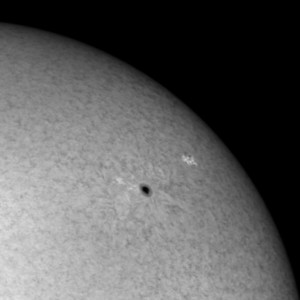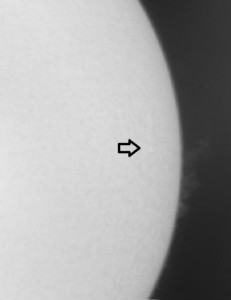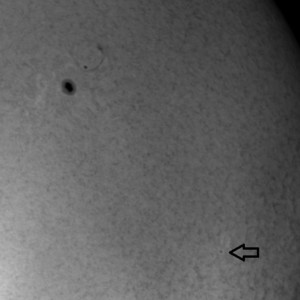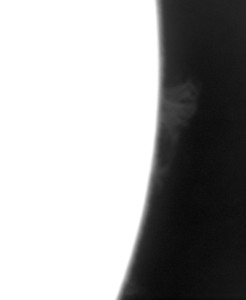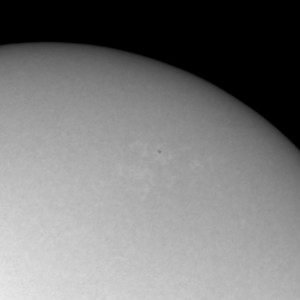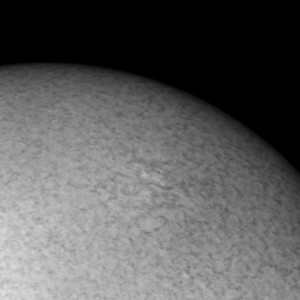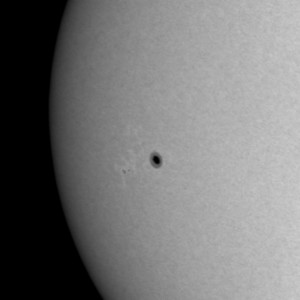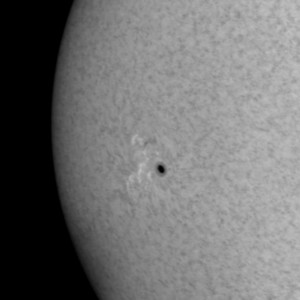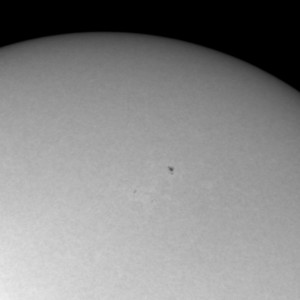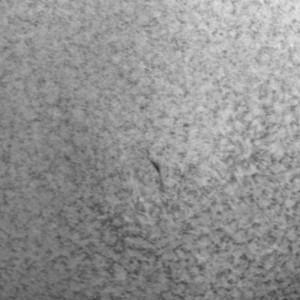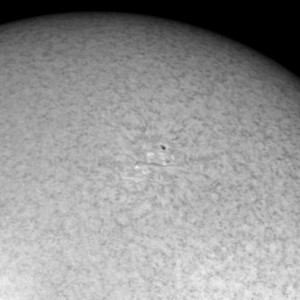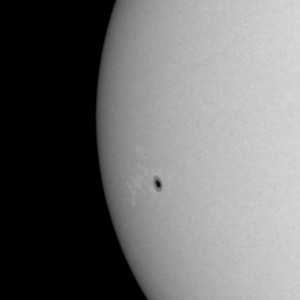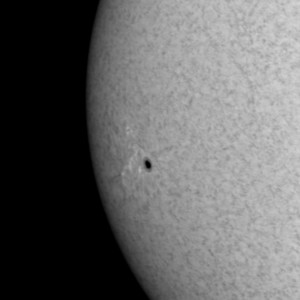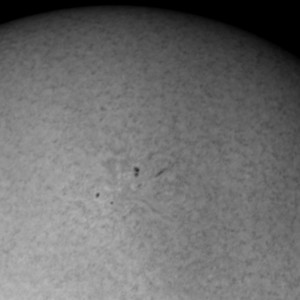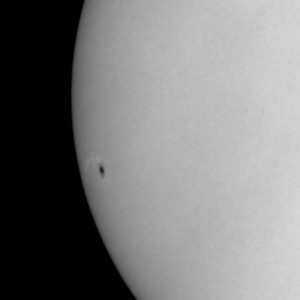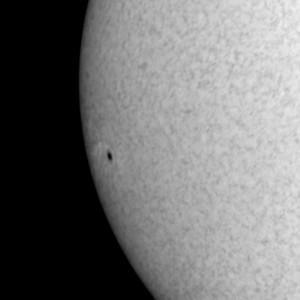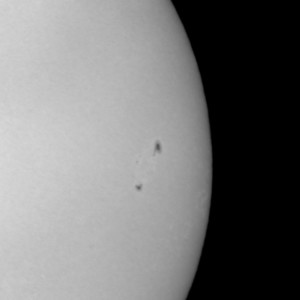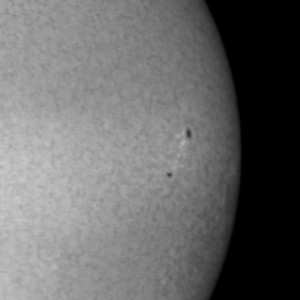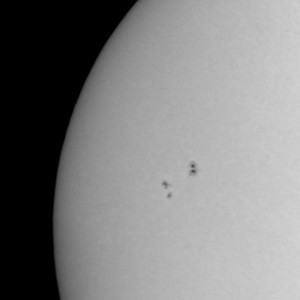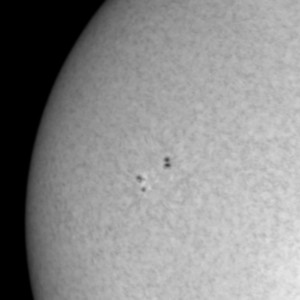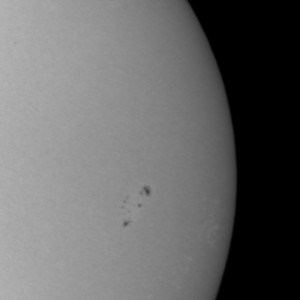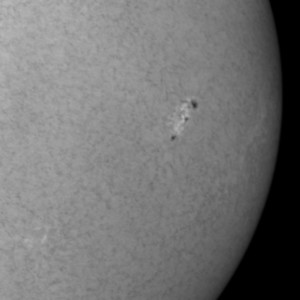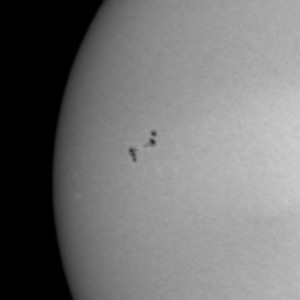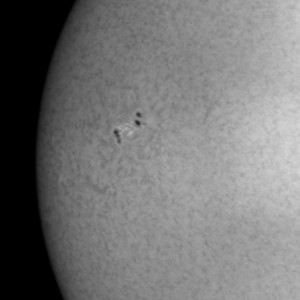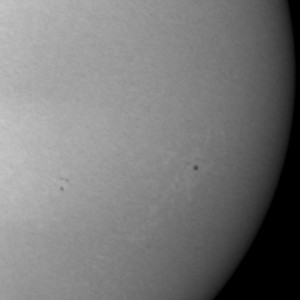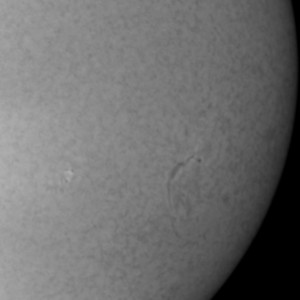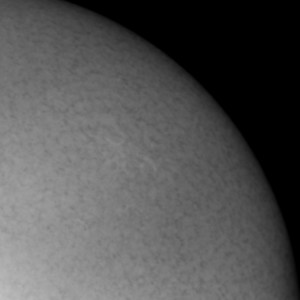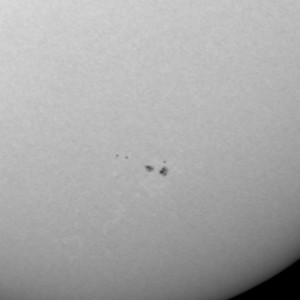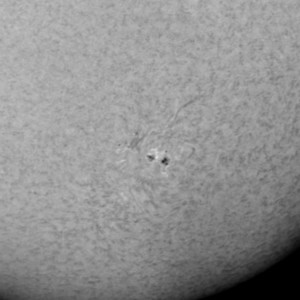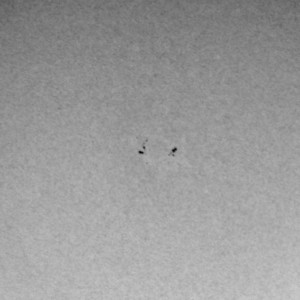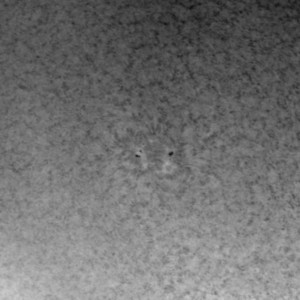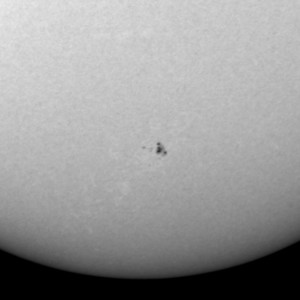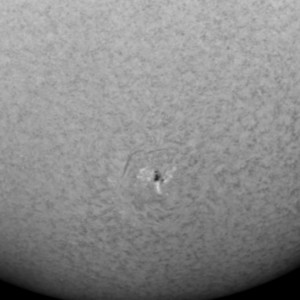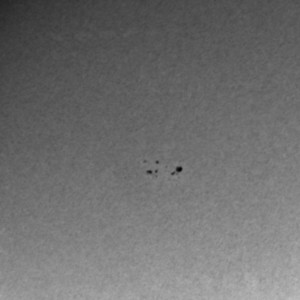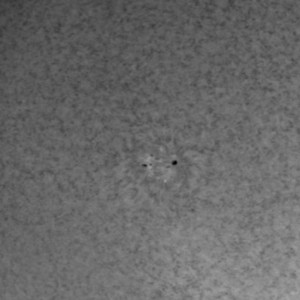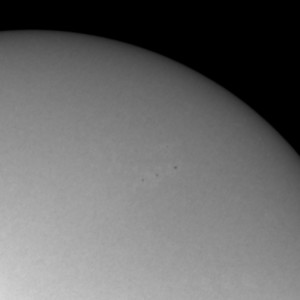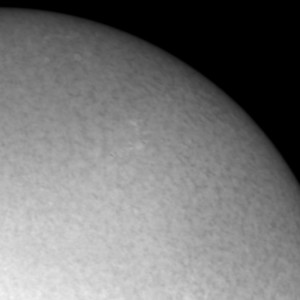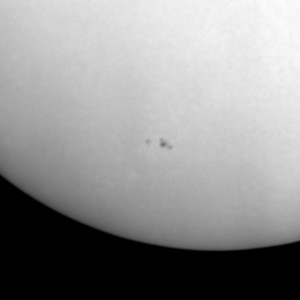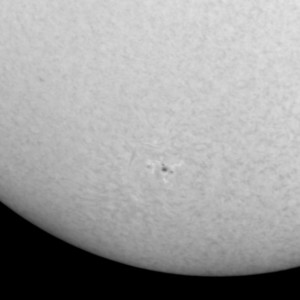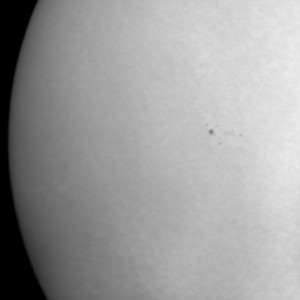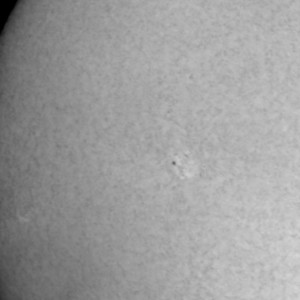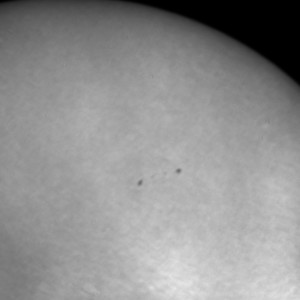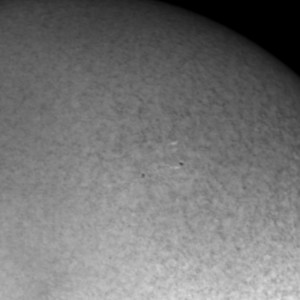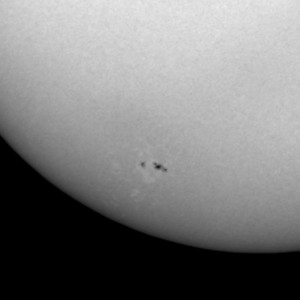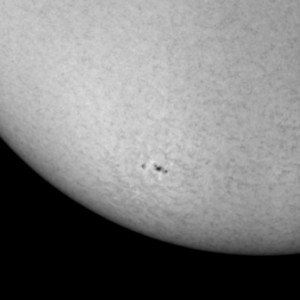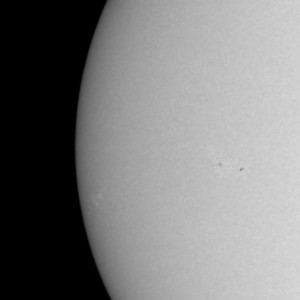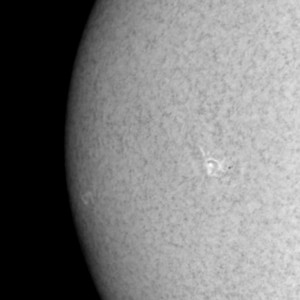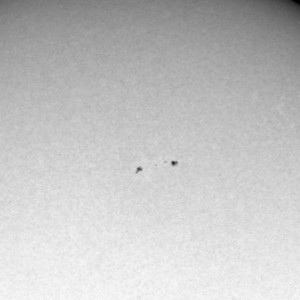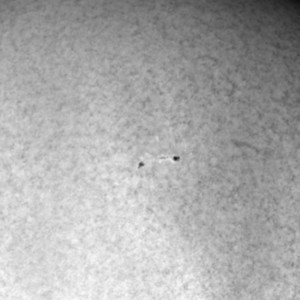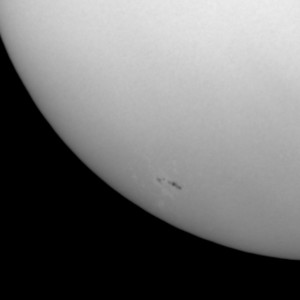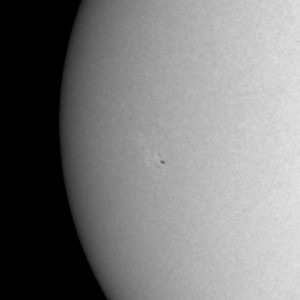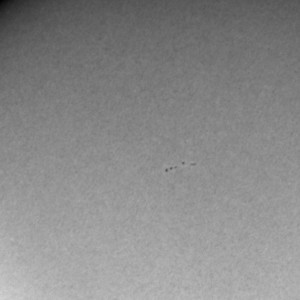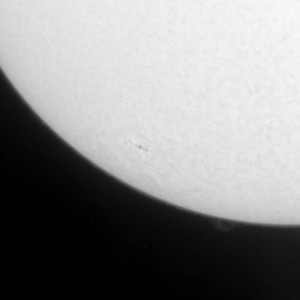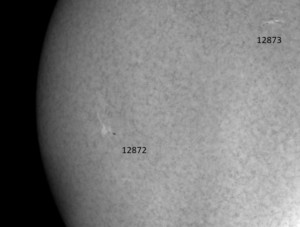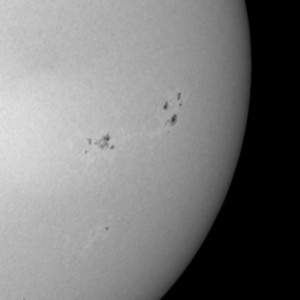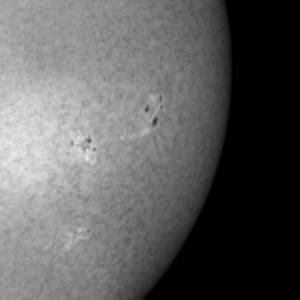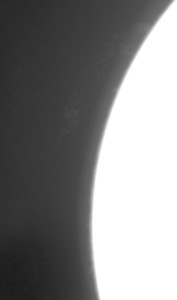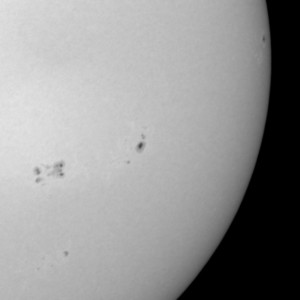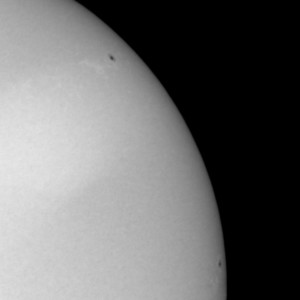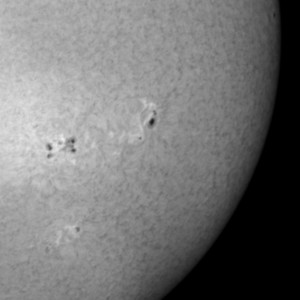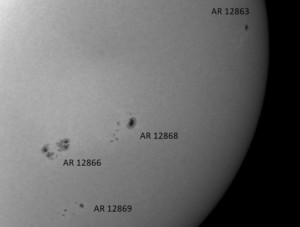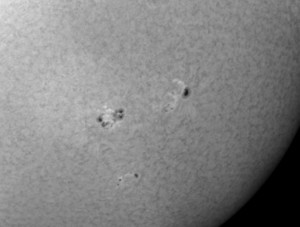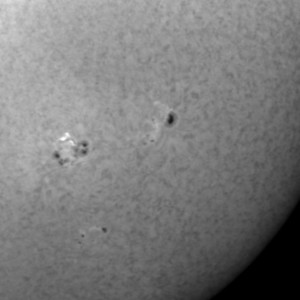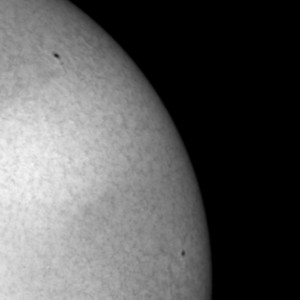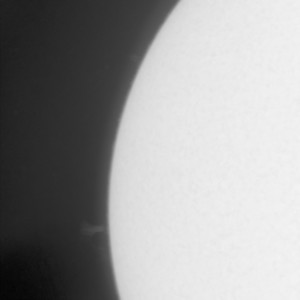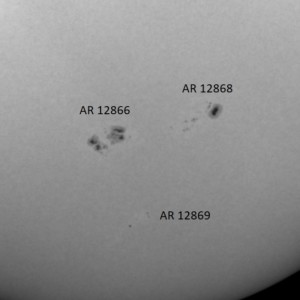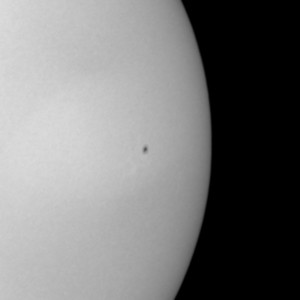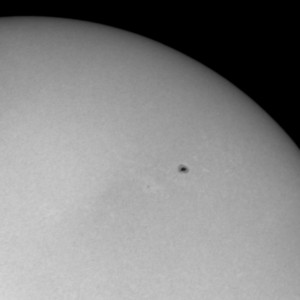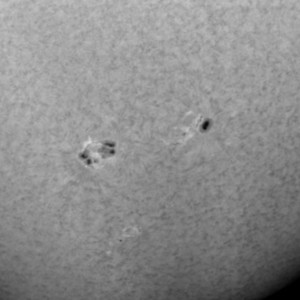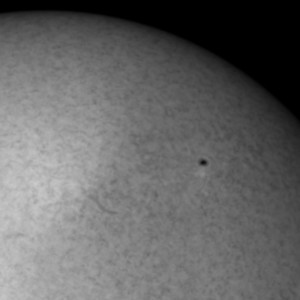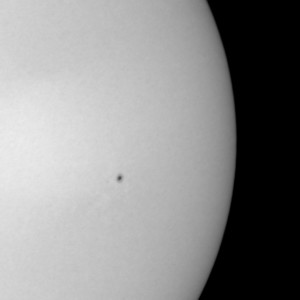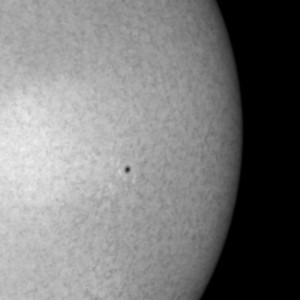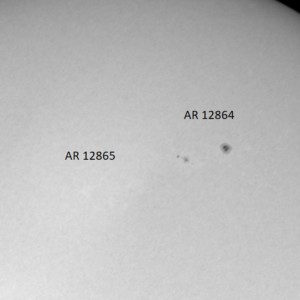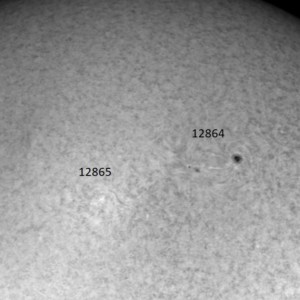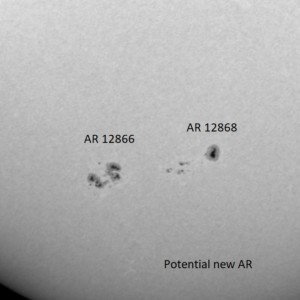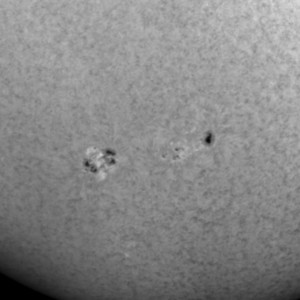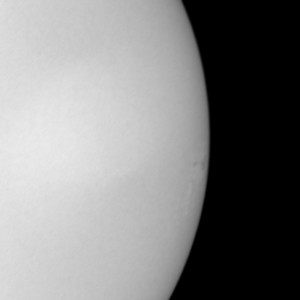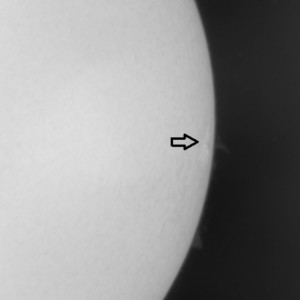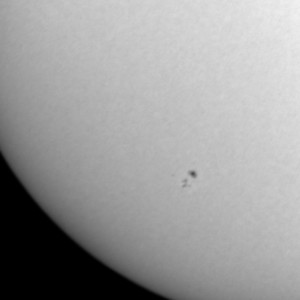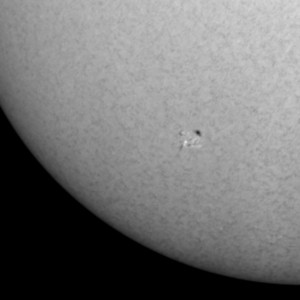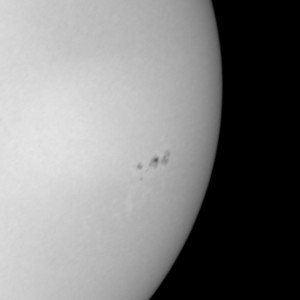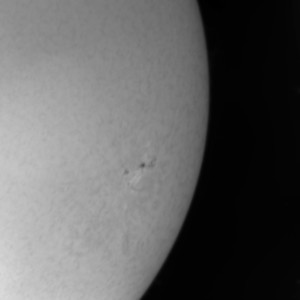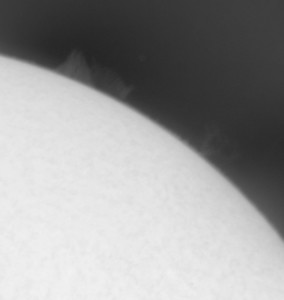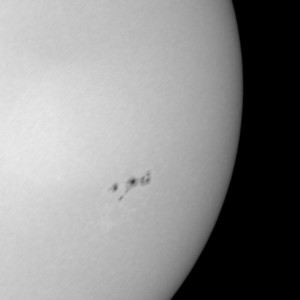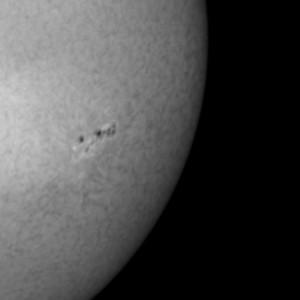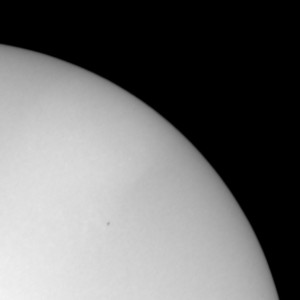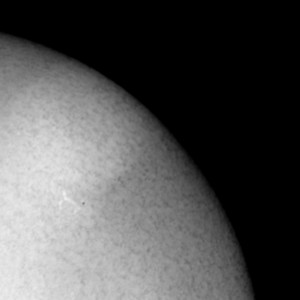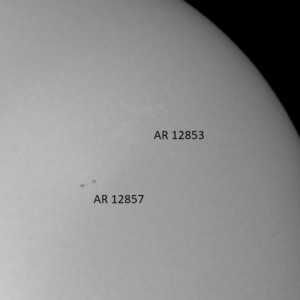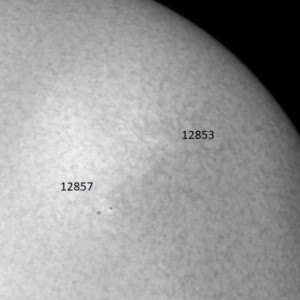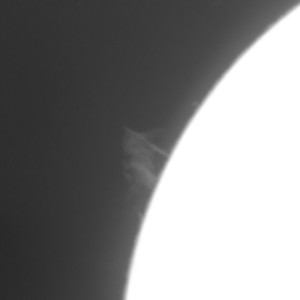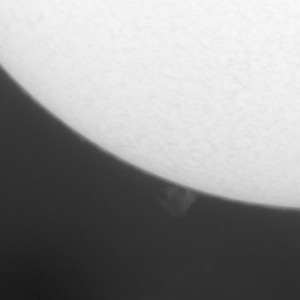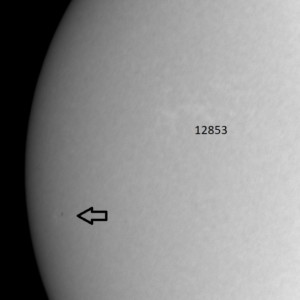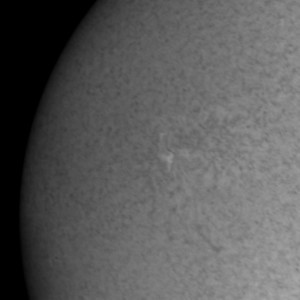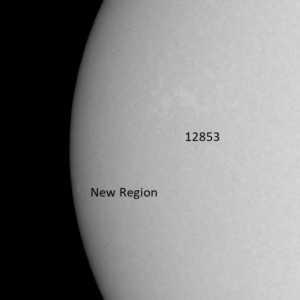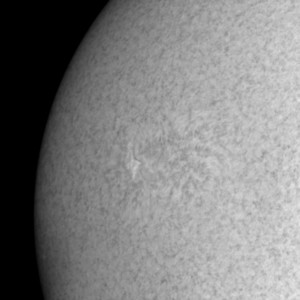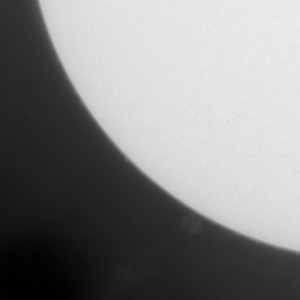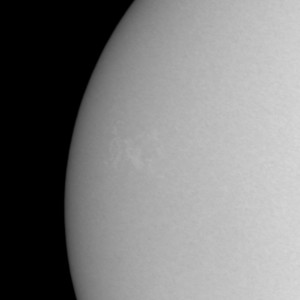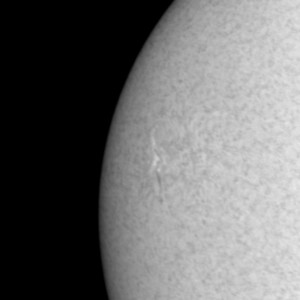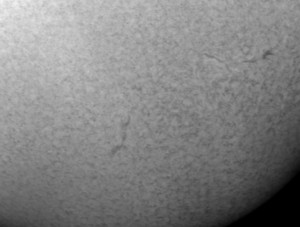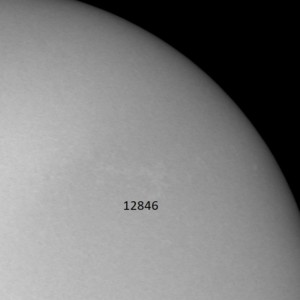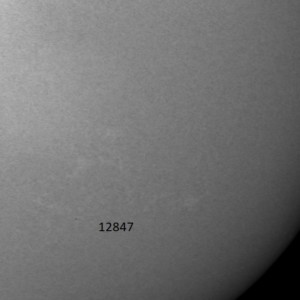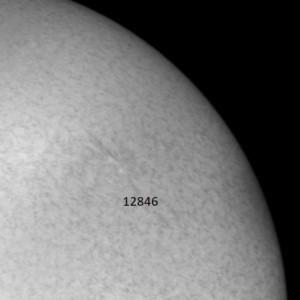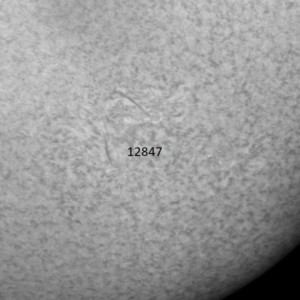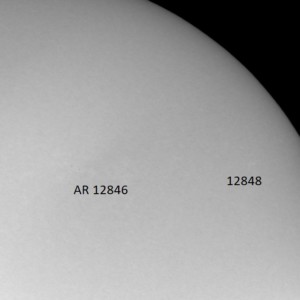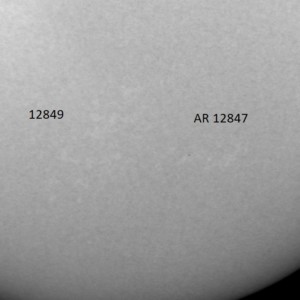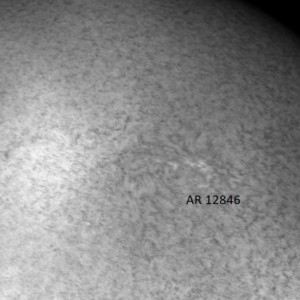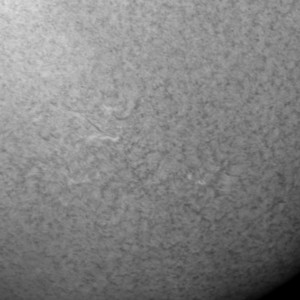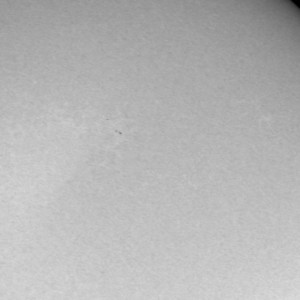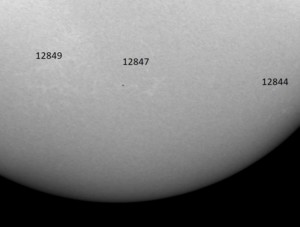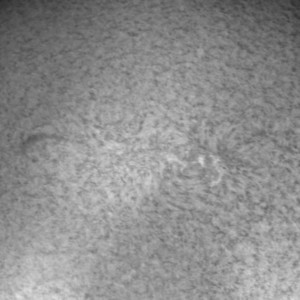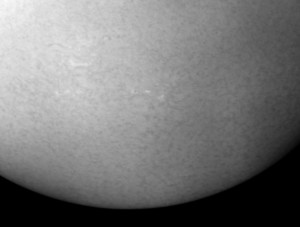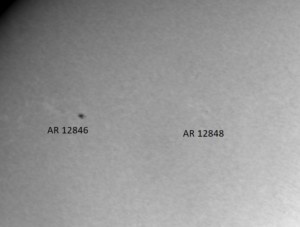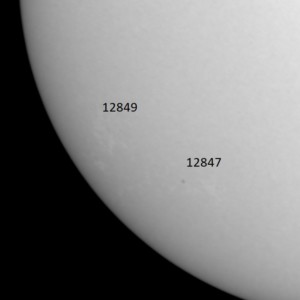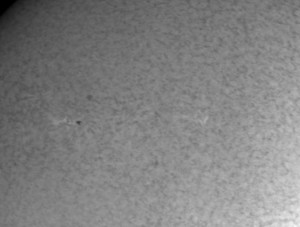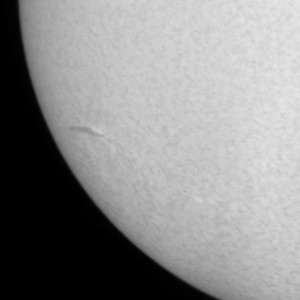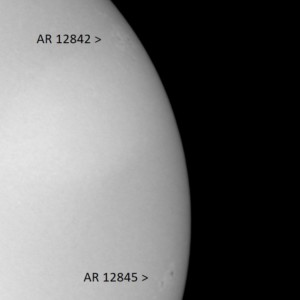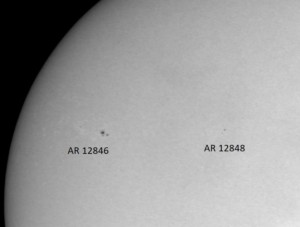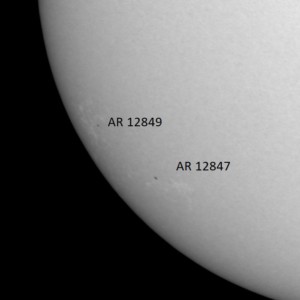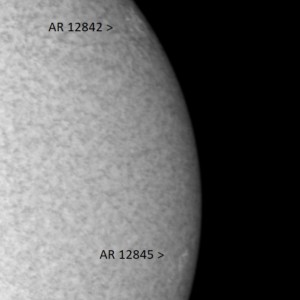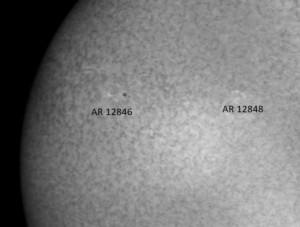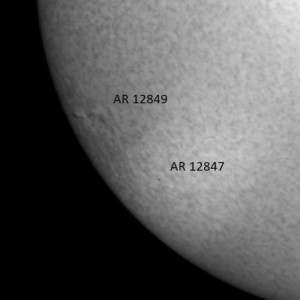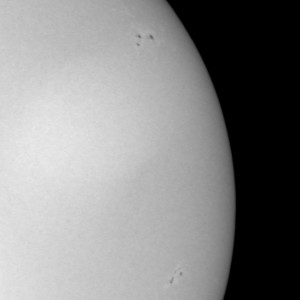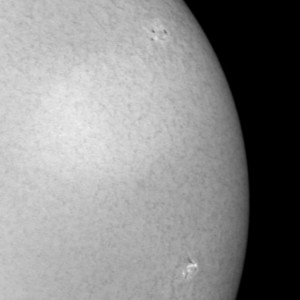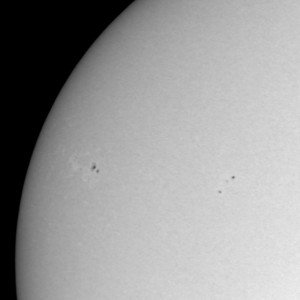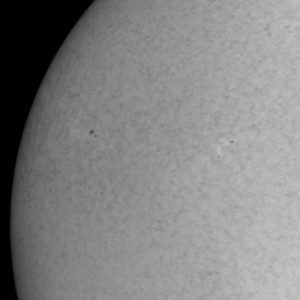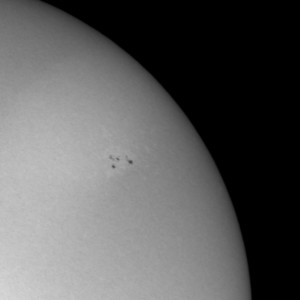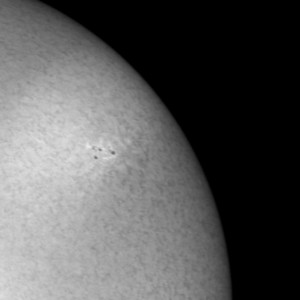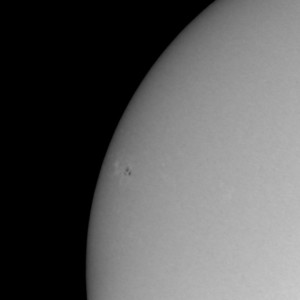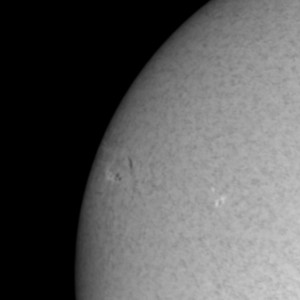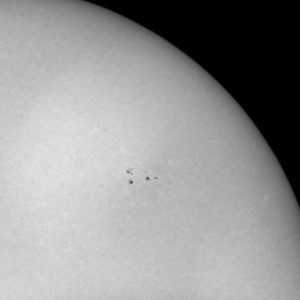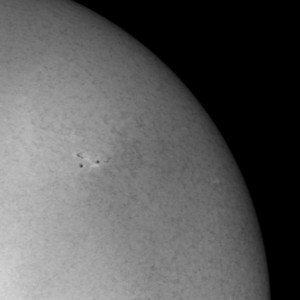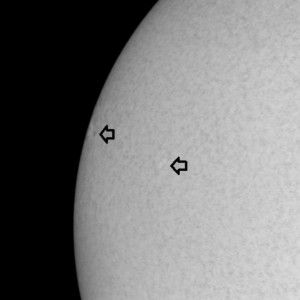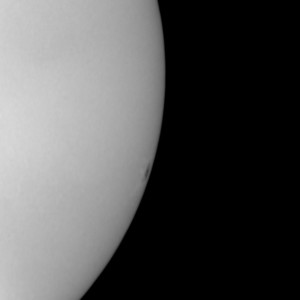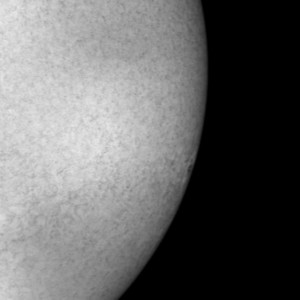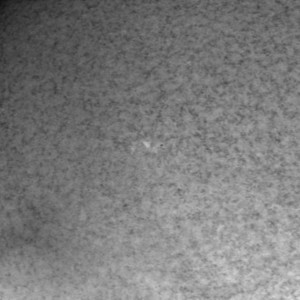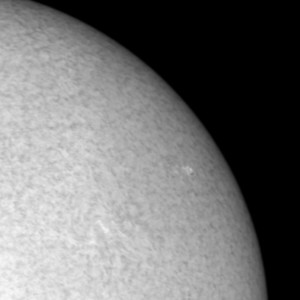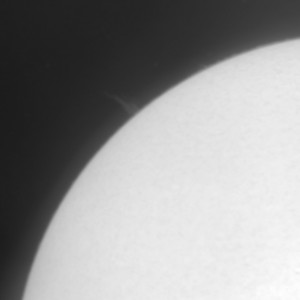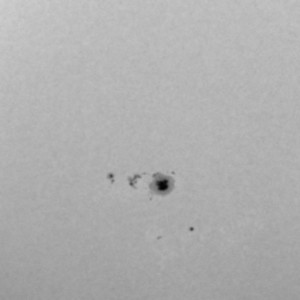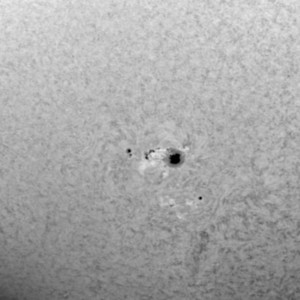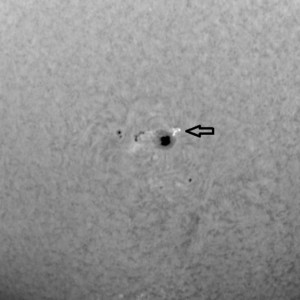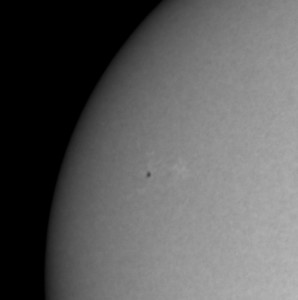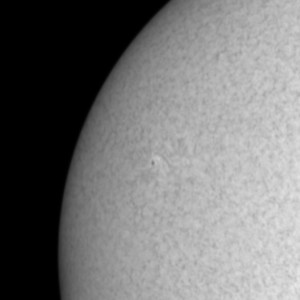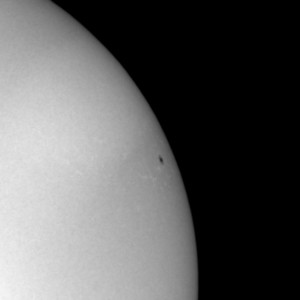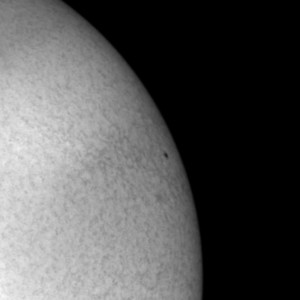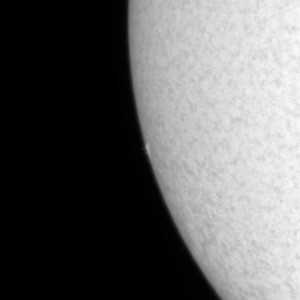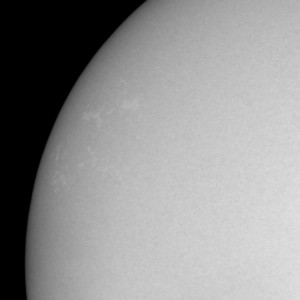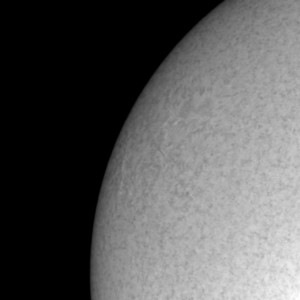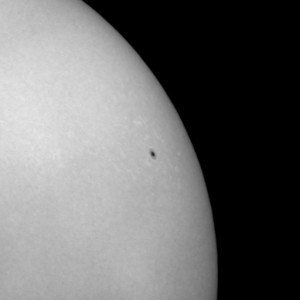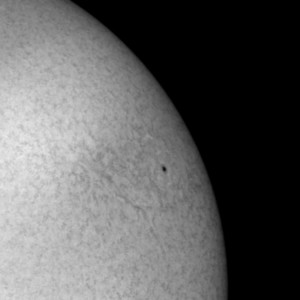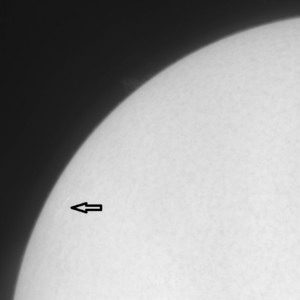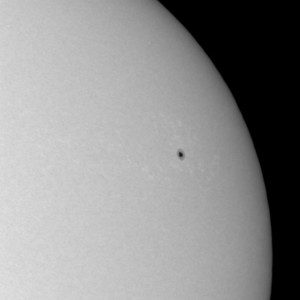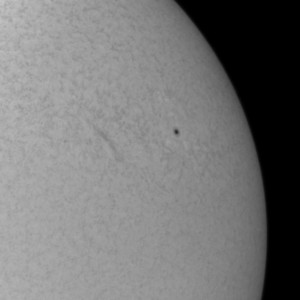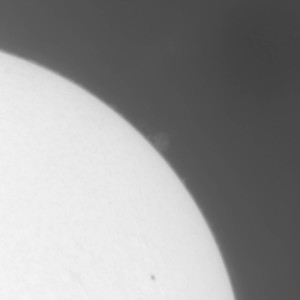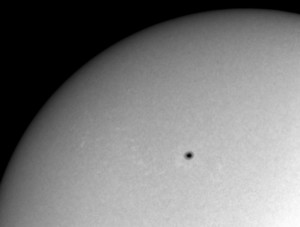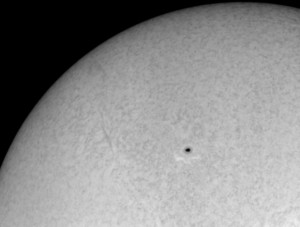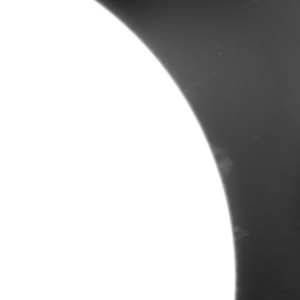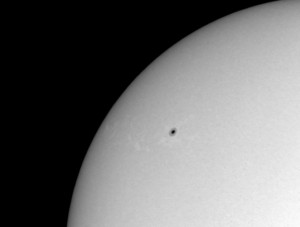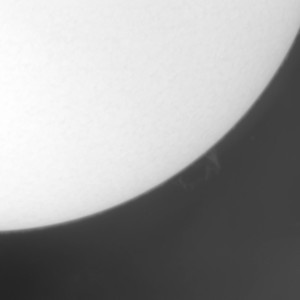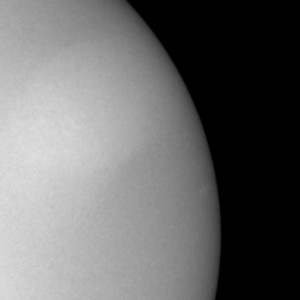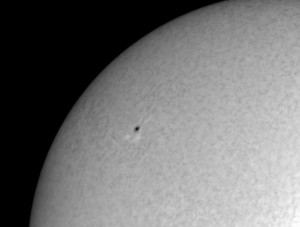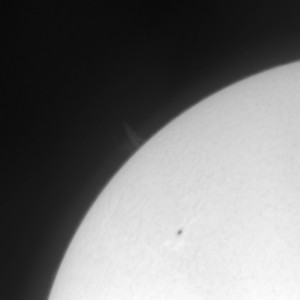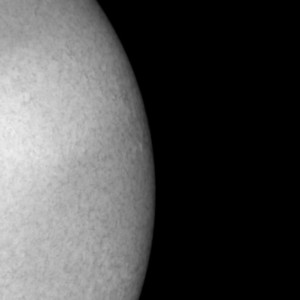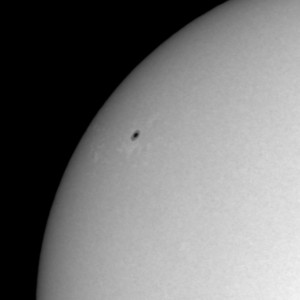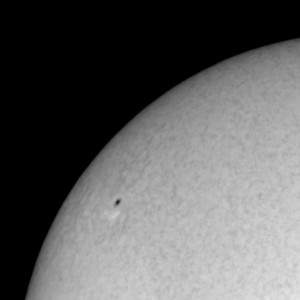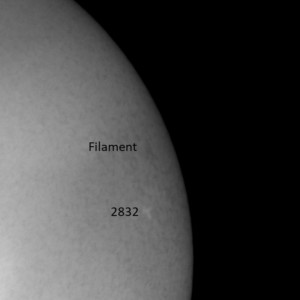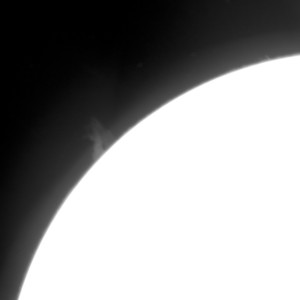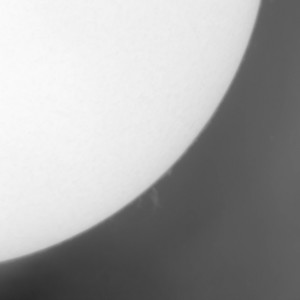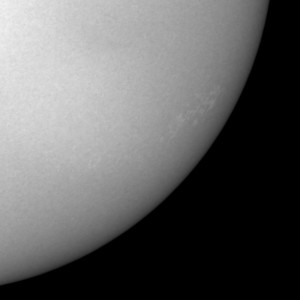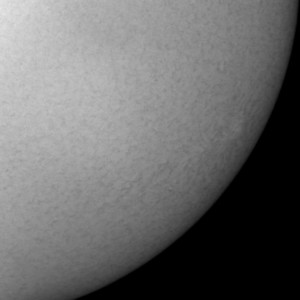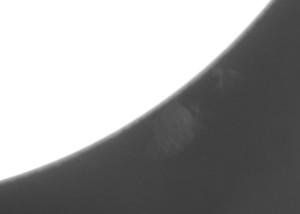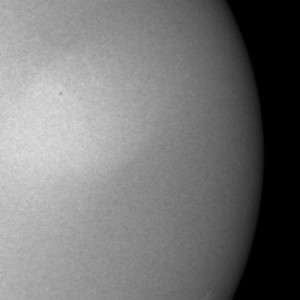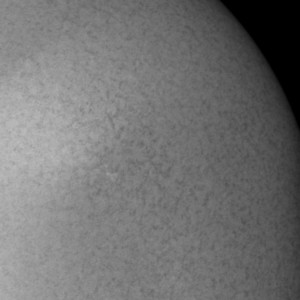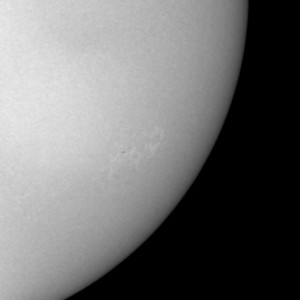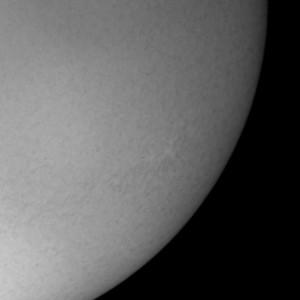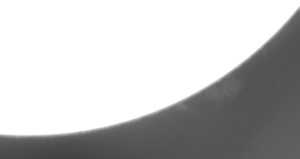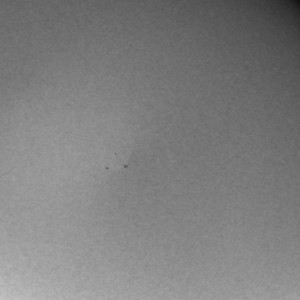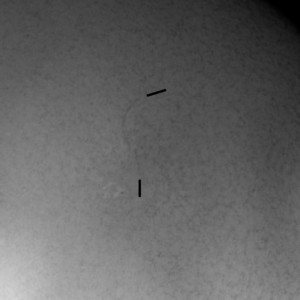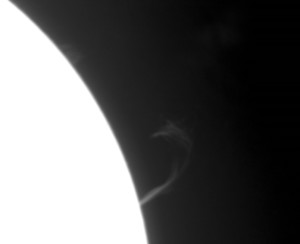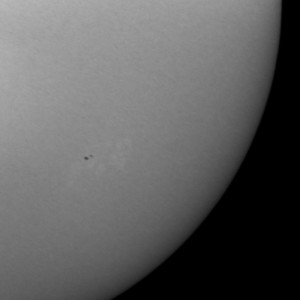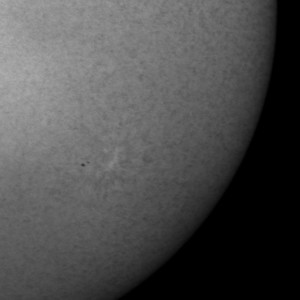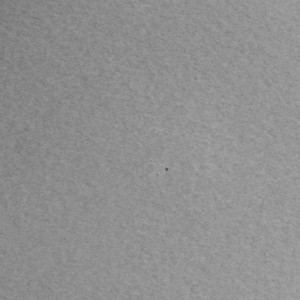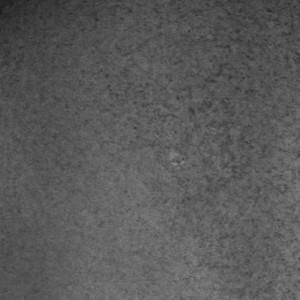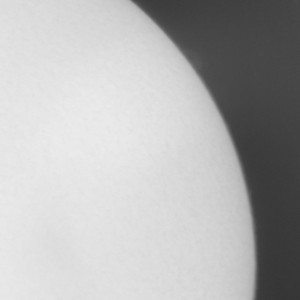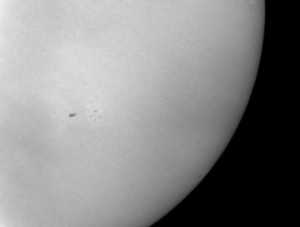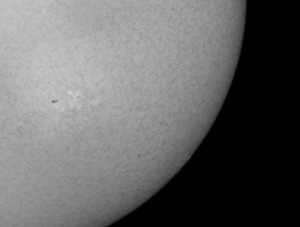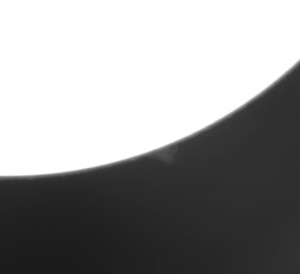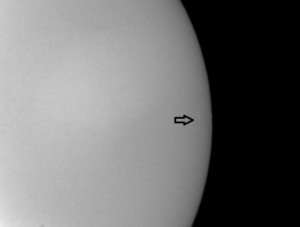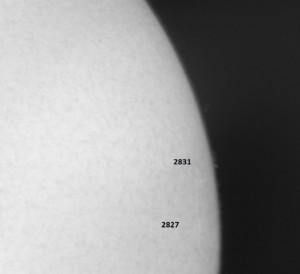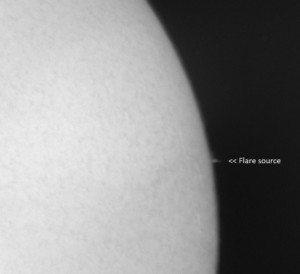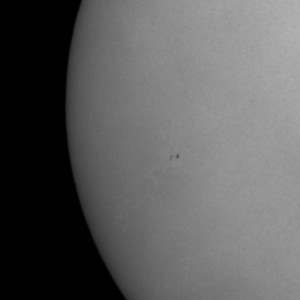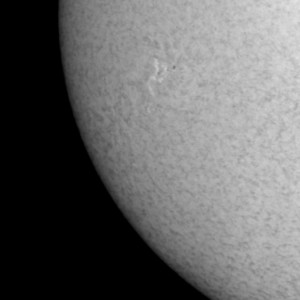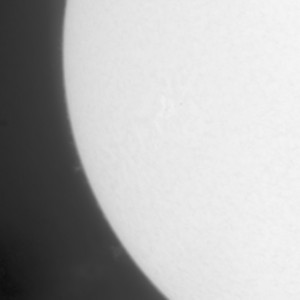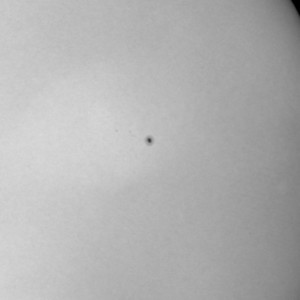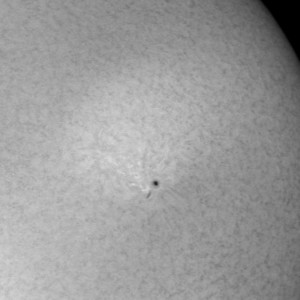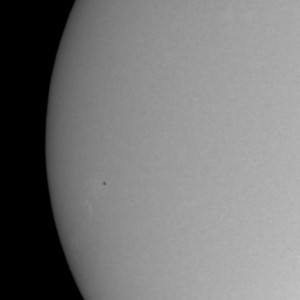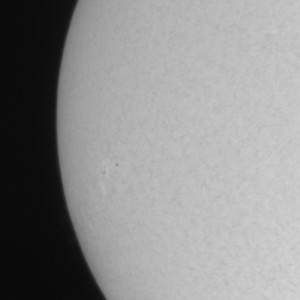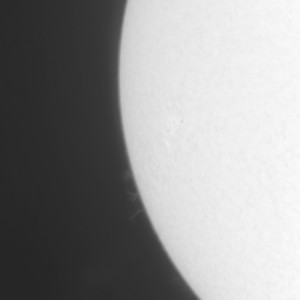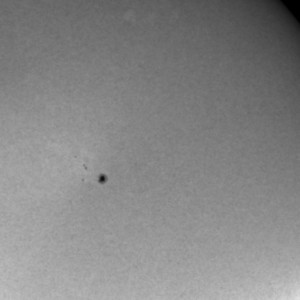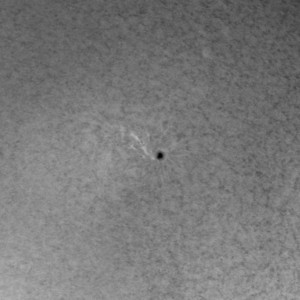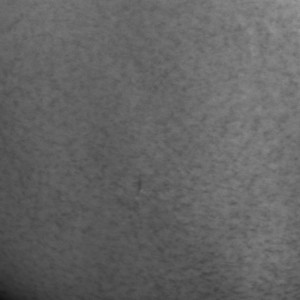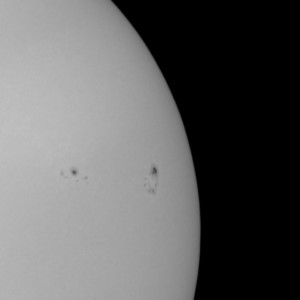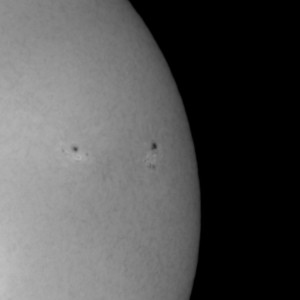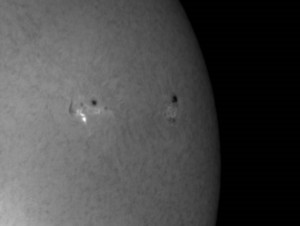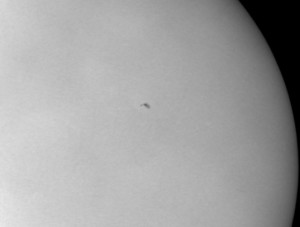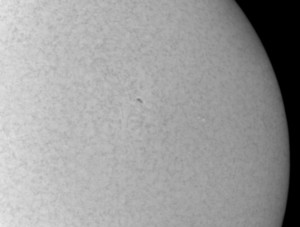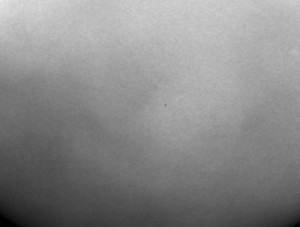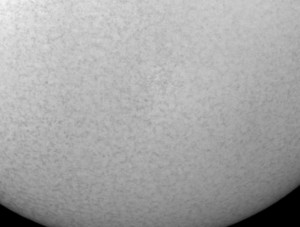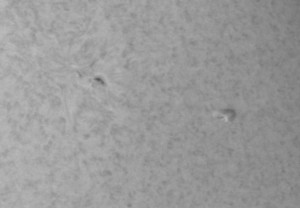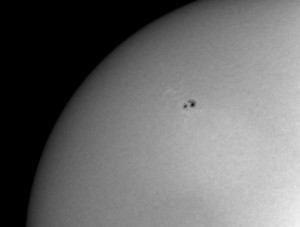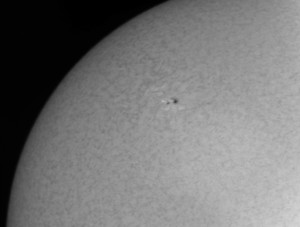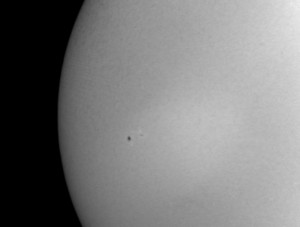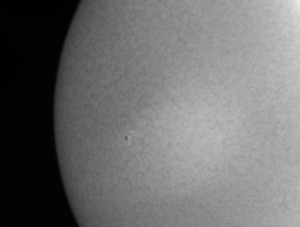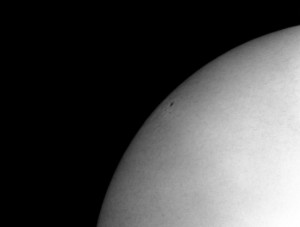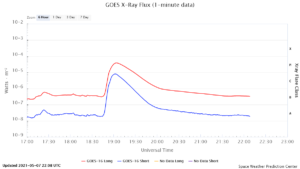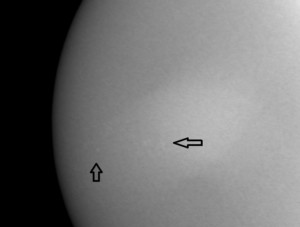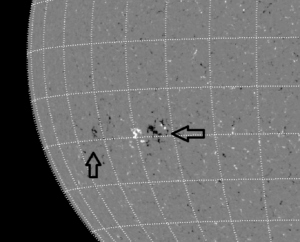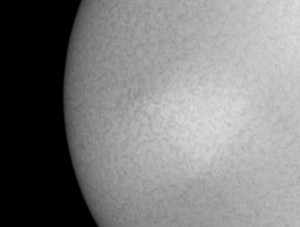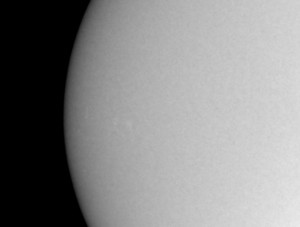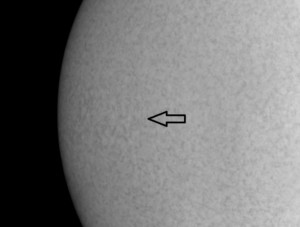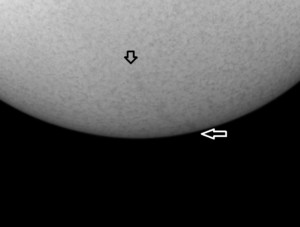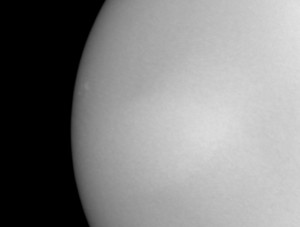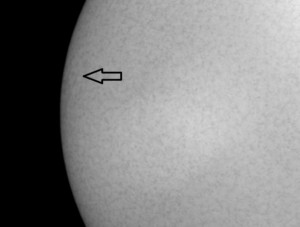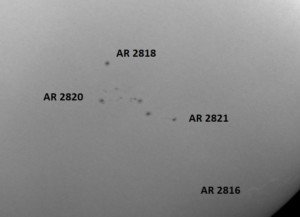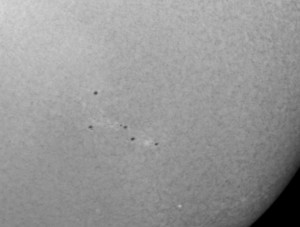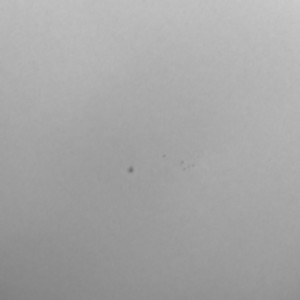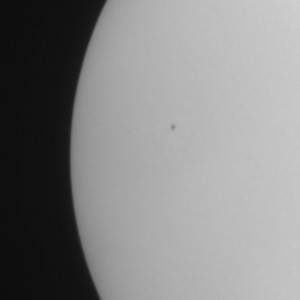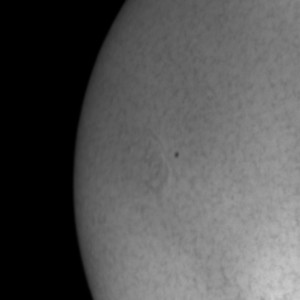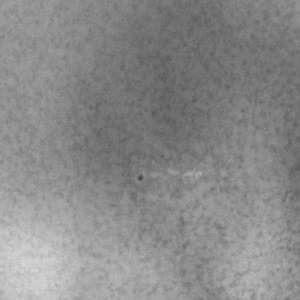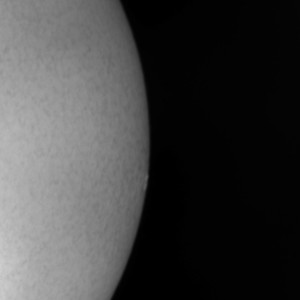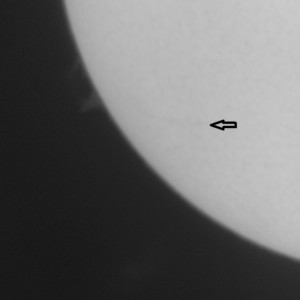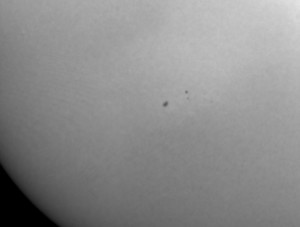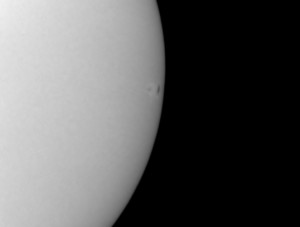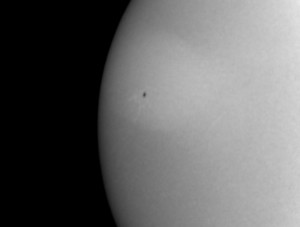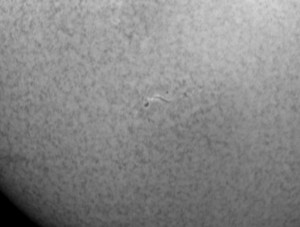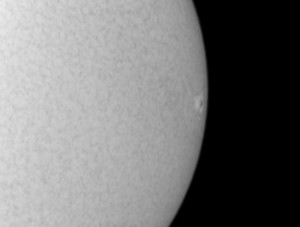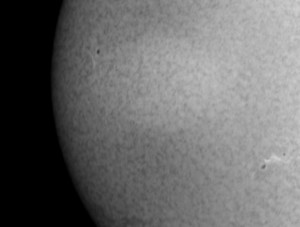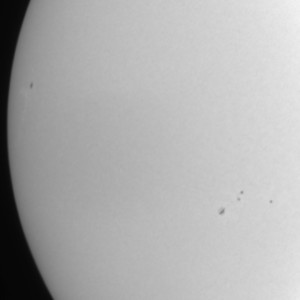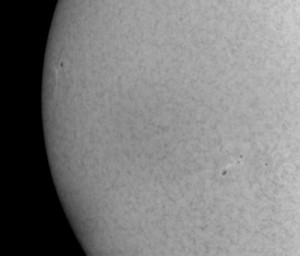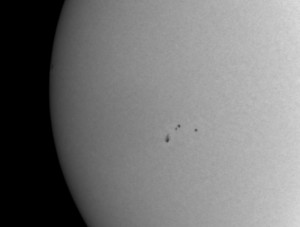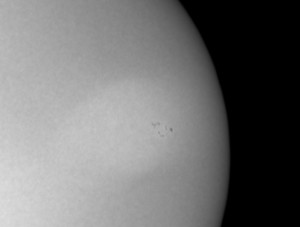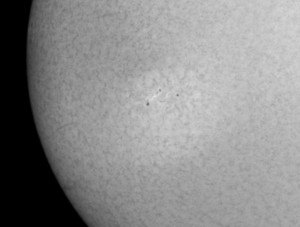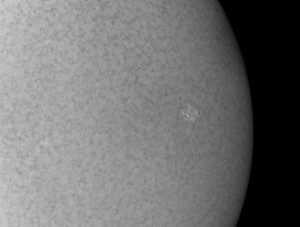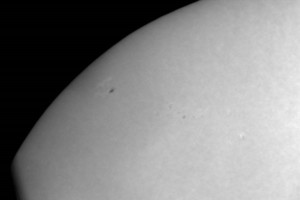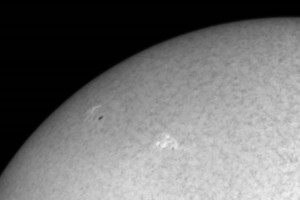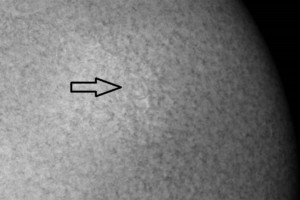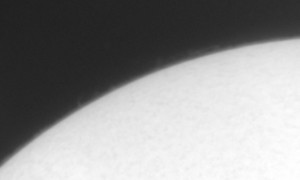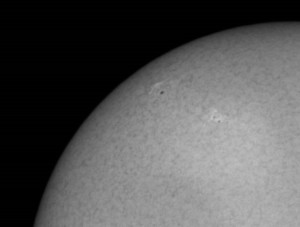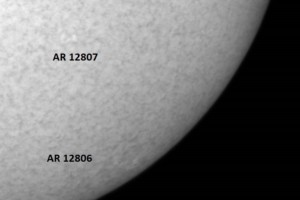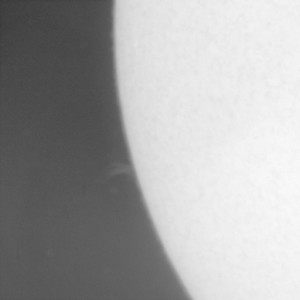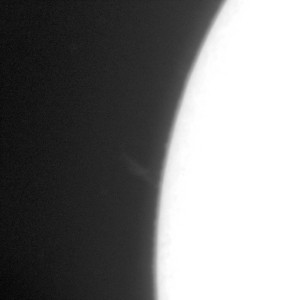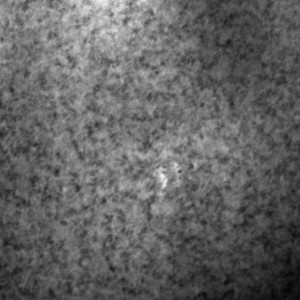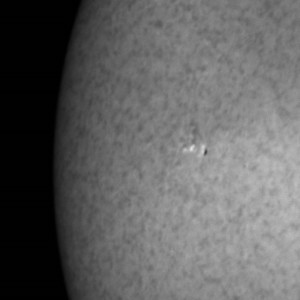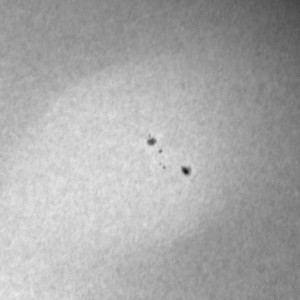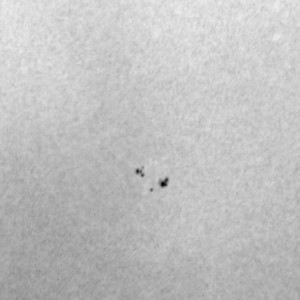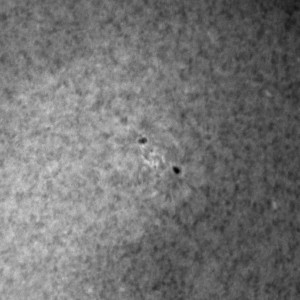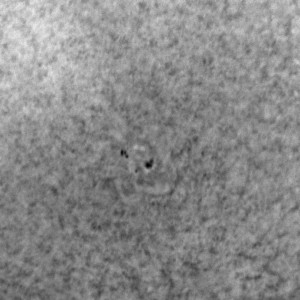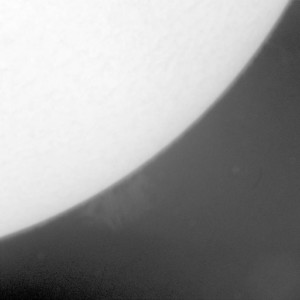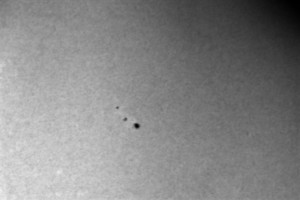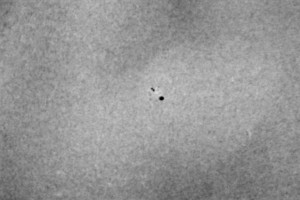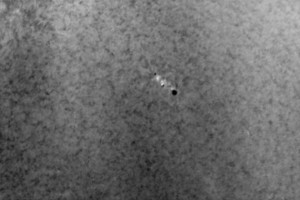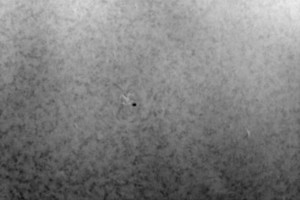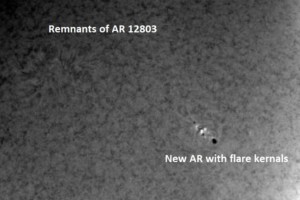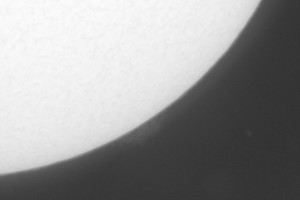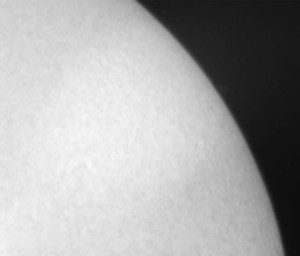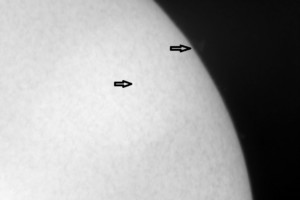Solar Images from 2021
Note: All images on this website © 2018-2022 by Brian Cudnik and Prairie View A&M Physics. All rights reserved.
Observations are happening daily, except for Saturday, Sunday, and holiday periods; and are governed by duty schedule, weather, and solar activity. When the Sun has very low activity (spotless), observations will be limited or non-existent. Whenever the Sun becomes active again, the observing program will become active as well, weather permitting.
One can monitor the Sun via several websites that provide real-time images of the Sun. The website, https://www.solarmonitor.org/, has such images in six different channels. The numbers are the NOAA designations for active regions (with the “1” at the start of the designation removed for convenience). Another website with up-t0-date information on solar activity and other goings-on in the skies is www.spaceweather.com. Additional information about the Sun’s current activity can be obtained from https://www.swpc.noaa.gov/, and real-time full-disk H-alpha images from observatories around the world can be viewed at http://halpha.nso.edu/.
A typical observing run may last from one to four hours, depending on seeing considerations, weather, and other work responsibilities, but will include active region monitoring of available active regions and the collection of frames for high-resolution solar mosaics in H-alpha. Each session includes at least one mosaic, which is a series of images made of all parts of the Sun’s disk that can later be stitched together to form a whole-disk image. At the very least, this ensures that all visible features such as prominences, filaments, and active regions (sunspot groups) are all captured in image form at least once per session. Usually observations are carried out in the late morning hours, but an additional session may occur in the mid-afternoon hours and it will include its own mosaic. If a sunspot group is expected to be active, then it becomes a main focus for observation for extended periods of time.
The solar images are recorded through a Meade 16-inch f/8 Cassegrain telescope equipped with a 0.3 Å Hydrogen-alpha filter and an SBIG STT-8300 CCD camera. The aperture of the scope is stopped to 4-7/8 inch by an energy-rejection filter, which renders the system an f/26. A neutral density filter is added to bring the sunlight intensity down by 90%. Each image is automatically dark-subtracted as it is saved and each exposure is 0.1 second long. Flat field images are taken at periodic intervals throughout the observing session and are obtained by training the telescope to focus near the center of the Sun’s disk. Five images are then taken while dithering the frame 1′ to 5′ N,S,E, and W. The idea is to try to get images that are slightly blurred (either due to seeing or scope motion) and off set from each other. A set of 30 bias images (0-second exposures with the dome closed and scope parked) are taken at the end of each observing session.
Select images are processed for further study and display. A program called MaxIM DL is used to do basic calibration (bias-subtraction and flat field correction), and the levels are adjusted for optimum display contrast. Choice images are then selected for online display. All of the images are archived in their raw FITS format, sorted by date, and backed up twice. At a later time we can mass process these and make them available for scientific use. Inquiries can be made of Brian Cudnik, at bmcudnik@pvamu.edu, or Premkumar Saganti, at pbsaganti@pvamu.edu.]
Check out my recent travel to Antarctica in this summary at this website.
December 22, 2021
There are 10 spotted regions currently visible on the Sun, along with two plage regions. Another two plage regions are rotating out of view. AR 12907 and 12908 remain active producing C-class flares. AR 12908 produced an M1.3/1N flare at 7:06 UT on 22 December.
Throughout the day today, these active regions continued to produce C-class flares. Unlike yesterday, today’s events were not imaged during the morning observing session.
Solar activity is expected to remain at low levels, with a slight chance for an M-class flare, through at least 24 December.
December 21, 2021
The Sun has many active regions again today. There are ten spotted active regions, one plage region, and one additional, spotted region (AR 12916) rotating into view. This region was responsible for two M-class flares early today: an M1/SF at 7:50 UT and an M1.4 at 11:44 UT. Besides this, AR’s 12907 and 12908 were active, the source of numerous C-class flares. Today, AR 12908 produced a C4.9 flare (peaking 17:50 UT) that was observed nearly in its entirety. An hour and a half later, AR 12909 produced a C4.9 flare (peaking 19:23UT), a fairly long duration event, that was not observed (we are in between sessions, will likely catch the tail end of this event in the next session this afternoon). Much better weather enabled us to collect many more observations today.
AR 12907 produced a C3.8 flare at 20:48 UT.
Each of these images are portrayed in the full on-sky resolution of 18.0’x13.3′, except for the AR 12910, which is shown 13.3′ squared. Celestial north is up, west is right in each image.
Solar activity is expected to remain at low levels through at least December 23.
December 20, 2021
The Sun has many active regions today, 8 of which are numbered, and two more are visible that have not yet been numbered. The clouds have been slow to clear and have only allowed limited observations this afternoon. Continuum images were obtained with calibration frames, but H-alpha images were difficult to come by before it clouded back up (in the part of the sky the Sun was in). Clearing occurred late but the Sun had gotten too low to image.
AR 12908 produced an M1 flare today at 11:36 UT. Other than this, the X-ray background was elevated to just under C1 level. The Sun had been relatively quiet with no significant flares since, and through 23:00 UT today.
There is a chance of M-class flares for the next few hours or so; otherwise solar activity is expected to remain low for the most part through at least 22 December 2021.
December 16, 2021
New spotted regions continue to appear on the solar disk, but activity had remained low with only some long duration C-class flares. Only continuum images were captured during the morning phase of the observations today; it was not until mid-afternoon that skies cleared enough to allow for H-alpha imaging. At the time of the imaging session, two AR’s appeared to be in the process of low-class-C flare activity: soon to be numbered AR 12911 on the east limb of the Sun, and AR 12907, which had been active since its appearance. Some flare ribbon structure is visible in the H-alpha image of AR’s 12906 (right edge), 12907 (near center, with bright strands visible) and 12908/12909 (left of center). The 18.0’x13.3′ image immediately below was obtained at 20:57:28 UT.
Solar activity is expected to remain at low levels through at least 18 December.
December 15, 2021
Solar activity is ramping up. With improved weather (somewhat), we were able to resume observations. A series of C-class flares were produced in the 30- or so hours leading up to these observations, but the activity had quieted down again by the time the observations began.
Solar activity is expected to remain low through at least December 17.
November 23, 2021
Another quiet day on the Sun. The two small, single-spotted regions continue to march across the solar disk mostly unchanged and totally quiet and inactive. A new active region has appeared in the southeastern quadrant of the sun’s disk and may be the source of some activity if it grows in the coming days.
Solar activity is expected to remain at very low levels through at least 25 November. This will be the last posting of observations while the program takes a two-week break as I travel. Observations should resume by 10 December for a short period before the holiday break.
November 22, 2021
Another quiet day on the Sun. The solar disk displays only two single, stable, inactive spots, along with some filaments.
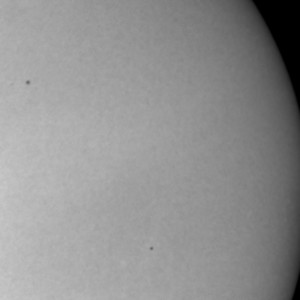
AR 12897 (top) and 12896 (bottom) as observed in red continuum, at 16:19:00 UT. |
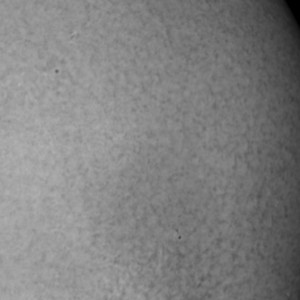
AR 12897 (top left) and 12896 (lower right) as observed in H-alpha at 16:38:07 UT. |
Solar activity is expected to remain at very low levels through at least November 24.
November 19, 2021
Another quiet day on the Sun. Very little activity taking place as the solar disk displays only two single, stable, inactive spots.
Solar activity is expected to remain at very low levels through at least November 21.
November 18, 2021
Another quiet day on the Sun. There are currently two spotted regions on the Sun, each of which appear as a single spot. They remain stable and inactive.
Solar activity is expected to remain at very low levels, with a slight chance of a C-class flare event, through at least 20 November.
November 17, 2021
Another quiet day on the Sun. There are currently three spotted regions on the Sun, one is disappearing over the western limb of the Sun and two remain. Each appear as a single spot and have been quiet and stable.
Solar activity is expected to remain at very low levels, with a slight chance of a C-class flare event, through at least 19 November.
November 16, 2021
Another quiet day on the Sun. The only recorded event was a B1.9 X-ray event at 7:48 UT from AR 12894. Nothing of significance has occurred on the Earth-facing side of the Sun all day.
Referring to yesterday’s continuum image of AR 12894 (below today’s set of images), above 12894 and closer to the Sun’s edge is a fairly prominent, elongated facula patch. This may be another active region/spot group in formation. I had not seen any dark spots in this region before it rotated out of view today. At its location, a surge was observed (the bump that appears on the edge of the Sun, about halfway up from the spotted region 12894 and the top edge of the image.
Solar activity is expected to remain very low with a slight chance of C-class flares, through at least November 18.
November 15, 2021
Another quiet day on the Sun. AR 12895 has decayed to a spotless plage while a new region, AR 12896, had rotated into view over the weekend. AR 12896 is visible as a single, simple spot. AR 12894 had some trailing spots that emerged, and produced a C1 flare over the weekend, but these have dissipated and the region is back to being a single spot with a double umbra. Both the spotted regions were quiet and stable over the last day or so.
Solar Activity is expected to remain very low through at least 17 November.
November 12, 2021
Another quiet day on the Sun. AR 12893 is barely visible on the edge of the Sun and will be gone (from our view) by tomorrow. AR 12895 is decaying and 12894 has added some spots. No flare events were recorded in the last 24 hours or so.
Solar Activity is expected to remain very low through at least 14 November.
November 11, 2021
Another quiet day on the Sun. AR 12895 did produce two X-ray flares: a B3.8 which peaked at 4:24 UT; and a B4.3, which peaked at 18:28 UT. This region continues to decay while the other two regions remain as single spots. AR 12894’s core umbra has broken into three pieces. Images of each of the visible spotted active regions appear below. The continuum/red light images are in the left column and the H-alpha line-center images in the right. The continuum images are each 0.1 second exposure; the H-alpha are each 1.0 seconds exposed. All the 13.3′ squared images are oriented with celestial north up, west right.
Solar activity is expected to be very low through at least 13 November, with a slight chance for C-class flaring.
November 10, 2021
Today was uneventful as far as solar events are concerned. There were no significant events up until this posting (around 22 h UT). The Sun’s disk has a triangular-shaped pattern of three spots/spot groups that continue to slowly march across the face of the Sun.
Images of each of the visible spotted active regions are presented below. The continuum/red light images are in the left column and the H-alpha line-center images in the right. The continuum images are each 0.1 second exposure; the H-alpha are each 1.0 seconds exposed.
Solar activity is expected to be very low through at least 12 November, with a slight chance for C-class flaring.
November 9, 2021
Clouds persisted into mid-afternoon during which the departing AR 12891 (not visible, over the western limb of the Sun) unleased a long duration M2 flare. The event manifested itself in limb activity visible in the GONG patrol images. The region had quieted down by the time we opened for a short session between clouds. Like what it did when it was just behind the east limb, it does so again from behind the west limb: manifest a lot of interesting activity as it remains largely hidden from view. The solar disk continues to display three spots/spot groups and not much activity otherwise.
Images of each of the visible spotted active regions are presented below. The continuum/red light images are in the left column and the H-alpha line-center images in the right. The continuum images are each 0.1 second exposure; the H-alpha are each 1.0 seconds exposed.
Solar activity is expected to be very low through at least 11 November. There is a chance for C-class flaring over the period from AR 12894 and 12895.
November 8, 2021
Solar activity remains low with the occasional C-class flare here and there. There are three spotted regions currently on the Sun’s disk. AR 12893 remans a single, simple spot as it nears the western edge of the Sun. AR 12894 remains simple, with only a few trailing spots. AR 12895 was not visible as a spotted region yesterday. Since then it has grown significantly (click here for the animation, and make sure November 8 2021 is entered in the archive fields to the right).
Images of each of the visible spotted active regions are presented below. The continuum/red light images are in the left column and the H-alpha line-center images in the right. The continuum images are each 0.1 second exposure; the H-alpha are each 1.0 seconds exposed.
Solar activity is expected to be very low through at least 10 November. There is a chance for C-class flaring over the next three days.
November 5, 2021
Since the last observing session, solar activity declined. Only four C-class flare events occurred since the last observing session. AR 12887 has rotated out of view but still shows signs of activity on the edge of the Sun. AR 12891 has decayed and shows a nice filament that bisects it. AR 12893 remans a single, simple spot as it crosses the celestial meridian. And a new spot, AR 12894, has become visible as the Sun carries it into view via rotation. Solar activity has been at low levels due to the aforementioned C-flares.
Images of each of the visible spotted active regions are presented below. The continuum/red light images are in the left column and the H-alpha line-center images in the right. The continuum images are each 0.1 second exposure; the H-alpha are each 1.0 seconds exposed.
Solar activity is expected to be very low through at least 7 November. There is a chance for C-class flaring over the next three days.
November 2, 2021
Solar activity remained at moderate levels today due to an M1/1f long-duration flare that came from AR 12891. This produced a “halo-type” coronal mass ejection (CME) which can be viewed here. AR 12887 is currently exiting from view, carried along by the sun’s rotation. It produced a C1/1f long duration flare yesterday late in the day. The secondary spots in the trailing section of the region have decayed to plage/faculae, leaving a single leader spot. This leaves AR 12891 as the most complex active region currently visible.
We monitored this region in two sessions today, but no activity was seen. The sun had been completely quiet up to this point (21h UT), with the last event of note being a C0.9 X-ray flare at 13:06 UT. Each active region is portrayed in image form below, with the continuum/red light images in the left column and the H-alpha line-center images in the right. The continuum images are each 0.1 second exposure; the H-alpha are each 1.0 seconds exposed.
The Space Weather Prediction Center (swpc.noaa.gov) predicts low solar activity, but with a chance of additional M-class flares (probably from AR 12891) through at least 4 November.
November 1, 2021
Solar activity returned to moderate levels after an M1/1F flare event from AR 12887 early on. Overall each of the regions on the Sun today have either remained stable or decayed. Two new regions appeared over the weekend: AR 12892 which emerged well north of 12887 but has since decayed; and AR 12893, which has rotated into view as a single, simple symmetrical spot.
The top row of images are red continuum images taken with a 0.1 second exposure. The bottom row of images are H-alpha line center, taken with 1.0 second exposure. Each images is cropped to 13.3′ square on the sky and is oriented so that celestial north is up, west is right. The usual calibration steps have been performed on each. These include dark subtraction, bias correction, and flat fielding. The images are then set to the intensity appropriate for display.
Solar activity is expected to remain at low levels through at least November 3, though a chance of an M-class flare remains.
October 29, 2021
Solar activity returned to low levels today after yesterday’s major X1/2N flare event from AR 12887. Overall each of the regions on the Sun today have either remained stable or have decayed. Yesterday’s big flare seems to have stabilized AR 12887. Although it produced an M1.3 at 2:45 UT today, all subsequent flares have been C-class, of decreasing intensity, and shared with AR 12891.
The top row of images are red continuum images taken with a 0.1 second exposure. The bottom row of images are H-alpha line center, taken with 1.0 second exposure. Each images is cropped to 13.3′ square on the sky and is oriented so that celestial north is up, west is right. The usual calibration steps have been performed on each. These include dark subtraction, bias correction, and flat fielding. The images are then set to the intensity appropriate for display.
Solar activity is expected to remain at low levels through at least October 31, though a good chance of an M-class flare remains.
October 28, 2021
Solar activity reached high levels today with the occurrence of two M-class flares and an X1.0 flare. The M-flares happened at 7:40 UT (M1.4) and 10:28 UT (M2.2). Then an X1.0 flare happened as we were opening for observations; this event peaked at 15:35 UT. All three of these events came from AR 12887. The first image of the day was AR 12887, at 15:36:30 UT, a little over a minute after flare maximum. Since it took nearly 10 minutes for the H-alpha filter to come on-band, we were not able to get a line-center image of this event until 15:48 UT, some 13 minutes after flare maximum. The images below depict the evolution of this event. The first is a section of the GONG (Global Oscillation Network Group) H-alpha image taken when the flare was at maximum output and covers a region comparable to our images (about 15′ across). The image next to it was the first image of the day. Very little of the flare is seen in the continuum, but a dark feature was seen in the first 18 images until it disappeared off the edge of the image. It is unclear what this is at the moment.
An optical flare was noted to peak at 16:04 UT and it was noted as a 2N on the flare importance scale (this is a measure of the optical intensity of flares).
The other regions on the Sun remained rather quiet except for AR 12891, which produced a handful of C1/SF events. Each of the images below were taken of the indicated active regions at the time noted. Except for the GONG image excerpt, each image is cropped to 13.3’x13.3′ and oriented so that celestial north is up, east is left. The continuum image below is a 0.1 second exposure; the rest are 0.5 second exposures.
These capture some of the decay process of the X1.0 flare as seen in the optical. An event of this magnitude may take minutes to reach maximum, but hours to fade away. The GOES X-Ray Flux remained above the C1.0 level continuously from 15:24 to 20:46 UT today, over 5 hours 20 minutes.
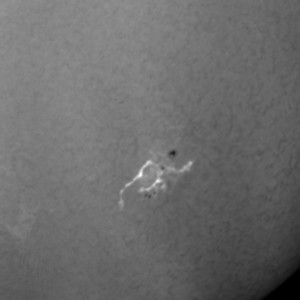 AR 12887 flare activity – 15:51:38 UT. AR 12887 flare activity – 15:51:38 UT. |
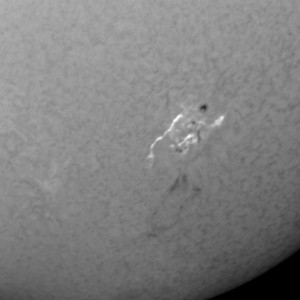 Flare activity – 16:01:51 UT. Flare activity – 16:01:51 UT. |
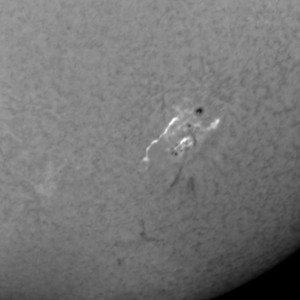 Flare activity – 16:17:11 UT Flare activity – 16:17:11 UT |
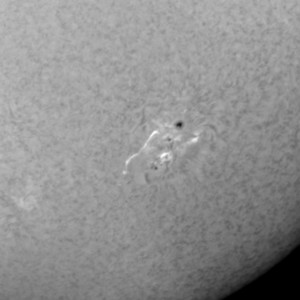 AR 12887 flare activity-16:45:20 UT AR 12887 flare activity-16:45:20 UT |
Solar activity is expected to return to low levels, with an eventual return to very low levels as most of the active regions continue to decay. C-class flares are likely with the slight chance of an M-class flare through at least October 30.
October 27, 2021
More new groups have appeared on the Sun since last observing session. AR 12886 continues to quietly trek across the Sun. AR 12887 is starting to become more active. AR 12891, the source of the limb activity from two days ago, has become visible and appears as a rather simple spot group. It has produced some minor B- and C-class flares. The top row of images below are red continuum images, each a 0.5 second exposure taken at the listed time. The bottom row of images are the same regions, but in the light of H-alpha emission line center. Each of these is a 1.0 second exposure.
Solar activity is expected to remain low through at least October 27.
October 25, 2021
New groups have appeared on the Sun since last observing session. AR 12886 continues to quietly trek across the Sun. AR 12887 has rotated into better view. Although the magnetic signature of this region indicates two spots, the NOAA Space Weather Prediction Center has only granted one designation and is recognizing it as only one spot group, AR 12887. Behind this spot group, two more have appeared: 12888 (the top, more northern region near the Sun’s edge) and 12889 (the brighter one in H-alpha, below, south). In addition to this a new region emerged east of 12886, and is AR 12890.
The top images are of AR’s 12890 (center) and 12886 (toward upper right). The first image captures part of AR 12887 in the lower left corner. The left image is made in red continuum, the right in H-alpha. Both are 18.6’x13.3′ in dimension. The bottom row depicts AR’s 12887 (large complex near image center) and the two new, lesser regions on the left (12888, top; and 12889, bottom). These are also red continuum and H-alpha respectively. Each of these regions remained quiet during the afternoon observing session.
The Sun had been very quiet until, suddenly at 19:55 UT, the first in what would be a series of flares would erupt. This was a C8.6 event. More C-class events, and even two M1 flares would erupt with remarkable frequency until about 16:00 UT on 26 October. One of the first events of this series was a long-duration C2 event, culminating with a C5 spike at 22:05 UT. The below images show activity on the northeast limb of the Sun that may have been responsible for this particular event. This same region would later produce an M1 event at 2:47 UT on 26 October. This region is the source of most of the C-level and B-level flares. AR’s 12887 and 12889 have also contributed to these flares.
The below images were taken at the indicated times and are each cropped to 13.3’x13.3′. North is up, east left in each H-alpha image.
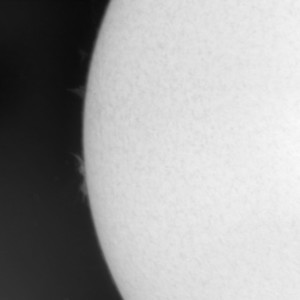 21:52:38 UT 21:52:38 UT |
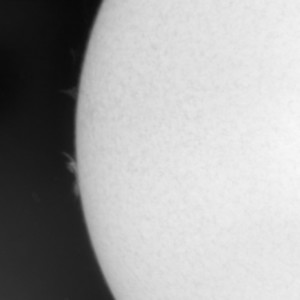 21:56:39 UT 21:56:39 UT |
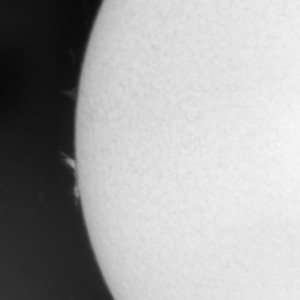 21:59:57 UT 21:59:57 UT |
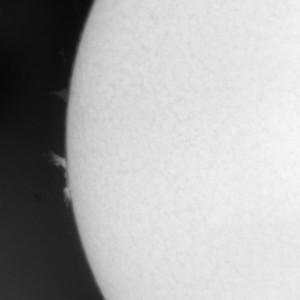 22:02:23 UT 22:02:23 UT |
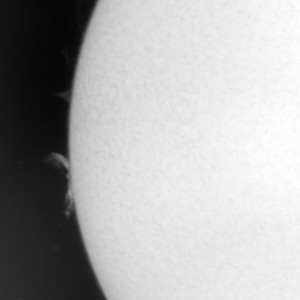 22:05:41 UT 22:05:41 UT |
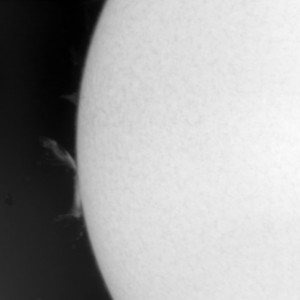 22:11:28 UT 22:11:28 UT |
Solar activity is likely to be at low levels through at least 28 October. There may be more M-class flares (or greater) when this region just out of view over the northeast limb rotates into view.
October 22, 2021
A new spot group is rotating into view over the southeastern limb of the Sun. This had been the source of some minor, B-class flares. Overall this region, now designated AR 12887, has been mainly quiet, only contributing to an elevated background X-ray level. The group looks like two active regions, based on the configurations of the spots as well as the configuration of the magnetic field patterns. This region (or regions) was (were) the main focus of today’s observations.
AR 12886 continues to shrink in size, and a light bridge was observed visually cutting across the umbra, dividing it into two parts. The un-named region near N33 E 60 is only a close pair of spots/pores along with a small, bright plage patch. The images below were obtained today at the times specified below. North is up, west is right in each 13.3’x13.3′ image.
Solar activity is expected to remain very low through at least October 24, with a minor chance of isolated C-class flares.
October 21, 2021
After a lengthy cloud delay, today’s observing session was carried out, fitting between the convective cumulus clouds at the start to increasing cirrus (with cumulus remaining) near the end of the session and beyond. Things are getting more interesting on the Sun with an unseen active region throwing up material and radiation from just beyond the southeast limb. This region should rotate into view in the next day or two. Another region in the northern solar hemisphere has developed three small spots visually but has yet to receive a designation. The dominant spot on the Sun, AR 12886, remains quiet and it is slowly shrinking in size. Several filaments were observed on the solar disk as well.
The top two images shown below are of AR 12886. The left one is a 1.0 second, red continuum image; the right is H-alpha line center. The “bump” on the edge of the Sun, just left and below center, marks the location of the surging activity from the above-mentioned unseen active region. It had erupted earlier this morning but was mainly quiet during the observing session. The bottom two images depict the new, unnumbered AR (lower left), and an assortment of filaments (lower right, arrowed). These images are 1.0 second, H-alpha line center images.
Solar activity is expected to remain at very low levels through at least October 23.
October 20, 2021
A near overcast of high clouds began clearing late this morning, and these clouds became thin enough to image through. By the end of the short session, these clouds had largely cleared out–only to be replaced by convective cumulus clouds that soon filled much of the sky for a time. The Sun continues to be very quiet so we are limiting our observing to daily single sessions of about an hour per day to capture what is going on with the Sun’s disk each day. The images below depict the full extent of the frame used to image the sun. Each image is 18.0’x13.3′, oriented with celestial north up, west right. The small form near the right edge is an image artefact. The faintish-fuzzy appearance of the first image (continuum) was due to a veil of cirrus. Usually the images are cropped to 13.3′ square to leave out artefacts that typically occur near the right and left edges of the image as well as to bring focus on the feature in question.
AR 12886 remains the only spotted region visible on the Sun today. Another region north of it, in the northern solar hemisphere, is a developing spotless region of emerging magnetic flux. This has not received a designation because no spots have formed yet. The background X-ray level, which was level and around the A4 range is starting to slope back up today, with some bumps barely breaking the B-level threshold. This is likely due to the afore-mentioned flux region.
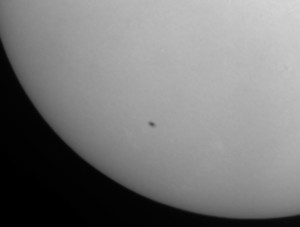
AR 12886 remains a simple, single spot in this red continuum image taken at 16:20:24 UT. |
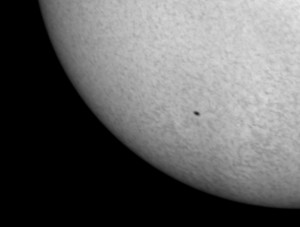
AR 12886 as imaged in H-alpha at 16:38:14 UT. |
Solar activity is expected to remain very low through at least October 22.
October 19, 2021
Skies were mostly clear during the morning observing session; otherwise the weather was expected to be partly to mostly cloudy with an abundance of mid-high level clouds. The Sun has become very quiet with no flaring activity over the last few days. AR 12882 has rotated out of view and a day after it left, another region, AR 12886, rotated into view. This new region is quiet and appears as only a single, simple spot.
The leftmost image is AR 12886 in red continuum light, a 0.1 second exposure. The center image depict these same regions in H-alpha light, a 1.0 second exposure. The right image is a prominence visible on the eastern limb; this image is a 1.0 second exposure cropped to 5.0’x13.3′ on the sky. The first two images are 13.3’x13.3′ and all three are oriented so that celestial north is up, west is right.
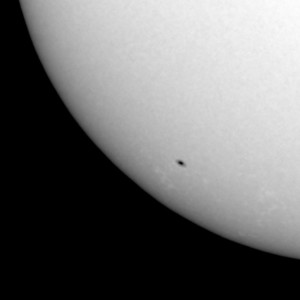
AR 12886 as imaged in red continuum at 14:32:40 UT. |
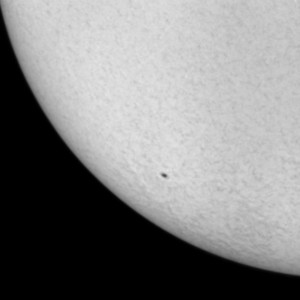
AR 12886 in H-alpha, as observed at 14:51:51 UT. |
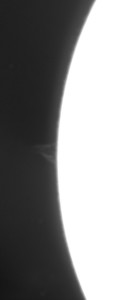
A prominence, one of several along the solar limb. This image was recorded at 15:18:22 UT. |
Solar activity is expected to remain at very low levels through at least October 21.
October 13, 2021
The weather was partly to mostly sunny for much of the day. Today was a follow-up session to check in on existing solar features. A new feature has appeared, Active Region 12885, which can be seen about 2-o’clock from the old AR 12882 in two of the below images. AR 12885 is starting to become active: producing several B-class flares starting around 14:00 UT along with some optical flares. A C1.0 occurred from this region at 18:33 UT. We did not observe any of these events. AR 12882 continues its slow decay with only a few tiny spots accompanying the large primary spot.
Some interesting prominences are seen on the western limb and they were documented as well. The image below shows these features, along with Plage Region 12884 (arrowed).
The leftmost image is AR 12882 and 12885 in red continuum light, a 0.1 second exposure. The center image depict these same regions in H-alpha light, a 1.0 second exposure. The right image is the prominence we have been watching; this image is a 1.0 second exposure cropped to 10.0’x13.3′ on the sky. The first two images are 13.3’x13.3′ and all three are oriented so that celestial north is up, west is right.
Solar activity is expected to remain at very low levels, with a chance for C-class flares and a slight chance for an M-class flares through at least October 15.
October 12, 2021
Cloudy weather delayed the start of today’s session until mid-afternoon when the clouds broke for a couple of hours to allow follow up images of AR 12882, and other areas of interest on the solar disk. The region AR 12882 continues to maintain itself even as the spots that formed north of the main large spot have begun to decay. Yesterday evening it produced a B9/sf flare at 1:46 UT (12 Oct), then remained quiet since.
The leftmost image is AR 12882 in red continuum light, a 0.1 second exposure. The center image is the same region in H-alpha light, a 1.0 second exposure. The right image is a prominence as viewed in the 10.1’x13.3′ image. The first two images are 13.3’x13.3′ and all three are oriented so that celestial north is up, west is right.
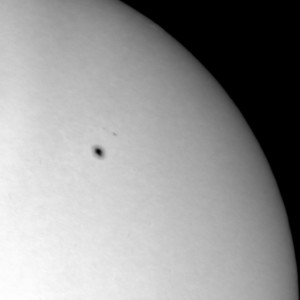
AR 12882, red continuum, as seen at 20:17:24 UT. |
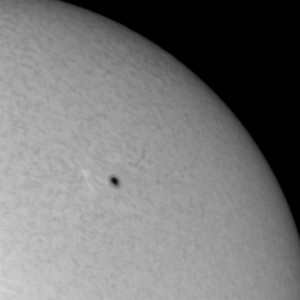
AR 12882 in H-alpha, as observed at 21:07:12 UT. |
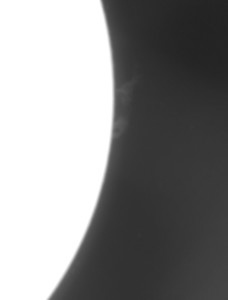
A well-developed prominence on the western limb of the Sun, as imaged at 20:50:47 UT. |
Solar activity is expected to remain at very low levels, with a slight chance of a C- class or M-class flare from AR 12882, through at least October 14.
October 11, 2021
Sun is quiet today after a brief flurry of activity mainly from AR 12882. At 6:35 UT on 9 October, it produced an M1.6 flare, the largest in recent days. Since then it has quieted down. Two other active regions formed and are already decaying: AR 12883 west/ahead of 12882; and AR 12884, arrowed in the first image below. The morning session was brief and through clouds, but the afternoon session featured clear skies. The images below were from the best parts of the morning session. We did not observe any flares or other interesting events on the sun during these sessions, but we did see some interesting features, including the prominence shown below.
Solar activity is expected to remain low, with a slight chance of M-class flare activity from AR 12882.
October 8, 2021
The only active region now present on the Sun’s disk is producing occasional C-class flares. It was the source of a C1 at 22:32 UT on 7 October, a double-peaked C1/c2 event with peaks at 10:42 and 11:08 UT on 8 October, and a C3 which peaked at 19:56 UT on 8 October. This was the region of focus which stayed quiet during this morning’s 3 hour session.
The leftmost image is AR 12882 in red continuum light, a 0.1 second exposure. The center image is the same region in H-alpha light, a 1.0 second exposure. The right image is a red-continuum image (0.1 second exposure) of what remains of AR 12880, getting ready to rotate out of view. The brighter spots are called “faculae” in the continuum, and “plage” in H-alpha light. Each image is 13.3’x13.3′ and is oriented so that celestial north is up, west is right.
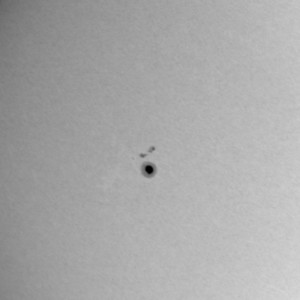
AR 12882, red continuum, as seen at 15:21:02 UT. |
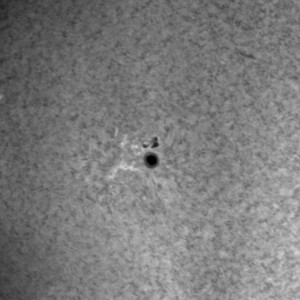 AR 12882 in H-alpha, as observed at 16:09:22 UT. AR 12882 in H-alpha, as observed at 16:09:22 UT. |
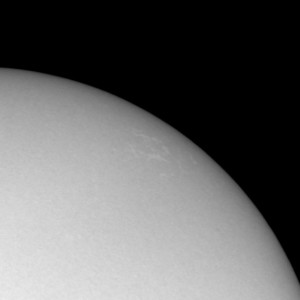
AR 12880 in red continuum, as recorded at 15:25:31 UT, |
Solar activity is expected to remain at very low levels, with a slight chance of a C-class flare, through at least 10 October.
October 7, 2021
Solar activity remains very low with the exception of a surprise C5.5/SF from AR 12882 at 2:46 UT on 7 October. Since then no significant flare-ups have occurred. AR 12882 had grown a few tiny spots behind the single, large primary spot and it was near this region of renewed activity that the flare occurred. AR 12280 has gone completely spotless as of this morning’s visual sunspot count observations; all that remains of this region is faculae (continuum) and plage (H-alpha) with a filament.
The leftmost image is AR 12882 in red continuum light, a 0.1 second exposure. The center image is the same region in H-alpha light, a 1.0 second exposure. The right image shows primarily the filament of AR 12880 (just above image center) and some plage. This H-alpha light image is also a 1.0 second exposure. Each image is 13.3’x13.3′ and is oriented so that celestial north is up, west is right.
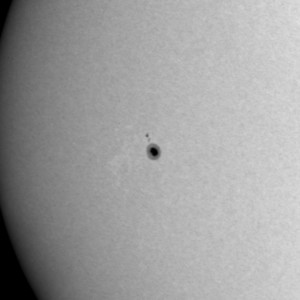
AR 12882 as seen at 15:38:56 UT. |
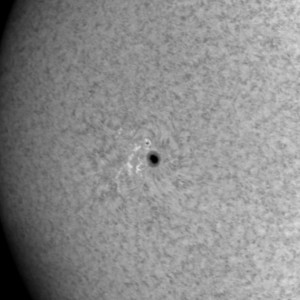
AR 12882 as observed at 16:09:22 UT. |
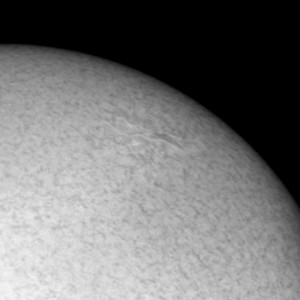
AR 12880 as recorded at 16:20:44 UT, |
Solar activity is expected to remain at very low levels, with a slight chance of a C-class flare, through at least 9 October.
October 6, 2021
The Sun continues to be a very low activity, with only a few B-level enhancements and mini-flares. AR 12882, which was a single, large spot, is now showing some magnetic flux/growth northeast of the main spot, and this area has been a source of such minor activity. A B7.6 flare peaked at 22:20 UT today after a nearly flat X-ray flux curve. This was most likely from AR 2882, which has, since yesterday, become the primary source of these enhancements. Through yesterday, AR 12880 was producing these B-class (and even an occasional C-class) enhancements (flares). Today this region is little more than a spot, some remnant plage and a filament.
The two active regions are shown below. The left column shows the regions in red continuum light at the times indicated, and the right columns display the regions as imaged in H-alpha emission line light. Celestial north is up, east is left in each 13.3’x13.3′ image.
Solar activity is expected to remain at very low levels through at least October 8. There is a chance of C-flares during this time.
October 5, 2021
Solar activity has dropped to very low levels as near-solar-minimum conditions now exist. Two active regions remain visible on the solar disc with AR 12880 in a state of decay (compare yesterday’s image to today’s); and AR 12882, an impressively large but very quiet single spot. Only a couple of filaments and prominences are visible on the sun’s disk and edges; overall the Sun appears similar to its minimum activity appearance.
The two active regions along with an isolated filament are shown below. The left and right most columns display the active regions: the left column are the regions in red continuum light at the times indicated, the top center image is an H-alpha view of the filament, and the right columns display the regions as imaged in H-alpha emission line light. Celestial north is up, east is left in each 13.3’x13.3′ image.
Solar activity is expected to remain very low through at least October 7, but with a chance of C-class flares.
October 4, 2021
We’ve just entered into an extended stretch of clear weather. The Sun is now very quiet with only two active regions visible. The region followed last week, AR 12877, has rotated out of view. AR 12780 is crossing the disk of the Sun, passing the solar central meridian. A new large single spot, AR 12882, has just rotated into view. Several interesting filaments and prominences appear on the sun’s disk. Despite all of these features, solar activity was very low today, with only small low-B-level enhancements.
Daily imaging sessions of one to two hours each this week, longer if activity warrants, will be the plan for the next five days. Solar activity is expected to remain very low until at least October 6.
September 30, 2021
Observations continued this morning for a short session before rainy weather returned. The main targets continued to be AR’s 12877 and 12880, with emphasis on 12877, which produced a C2.8/1N flare shortly after yesterday’s session concluded event peaked at 21:56UT. It had since been the source of several B-class and one more C-class flare events today. The region remained very quiet during this morning’s observing session. AR 12880 produced a C1 flare yesterday at 22:13 UT and was the source of a single B-class event at 10:23 UT today.
There will continue to be a chance of C-class flare activity through at least October 2nd.
September 29, 2021
Skies unexpectedly cleared this afternoon to allow brief observations of two new growing active regions. These are AR 12877 and 12880. AR 12871 is only one tiny spot and some plage and is about to exit due to solar rotation. 12877 has been rather active with C-class flares emanating from it occasionally.
Solar activity is expected to remain low through at least October 1, with a chance for C-class flares.
September 27, 2021
The Sun continues to become more and more quiet as the active regions from last week have either dissipated, rotated out of view or otherwise became dormant. AR 12871 remains visible on the Sun but it mostly quiet currently. It was joined by another small region, AR 12877. The latter is visible toward the left of the first two images below. Another small spotted region, AR 12878, has appeared near the eastern edge of the Sun. Meanwhile AR 12872 has become virtually spotless (the morning spot count revealed no visible spots). Weather today was not ideal for observation and it is only expected to get worse as the week progresses so this will be the last day of observation until early next week at least.
The first image was obtained in red continuum light and is a 0.1 second exposure; the other two are 1.0 minute exposure H-alpha images. Each has been cropped to cover 13.3’x13.3′ of sky and is oriented so that celestial north is up, west is right.
Solar activity is expected to remain at very low levels through at least September 29.
September 24, 2021
The Sun seems to be quieting down as only modest flare events occurred occasionally over the past day. The largest since yesterday’s M1 flare was a C2.9 that peaked at 7:01 UT this morning from AR 2871. We observed two B-class flares from AR 12871, peaking at 18:12 and 18:33 UT. We also observed some interesting changes in some filaments near the active region, which led to their disappearance and may have been related to a radio sweep event between 17:24 and 17:27 UT. The pair of B-class flares featured an optical component, a parallel-ribbon type sub-flare that peaked at 18:36 UT.
As it turns out, the small pair of spots left of the two large spots in AR 12872 is a separate active region (AR 12876) that formed then dissipated in less than a day. This “extra” region can be seen especially in the continuum image below. It was completely gone by 24 hours after the image was taken.
All of the spotted regions (currently there are four that are visible) are in a state of decline or stability. AR 12871 continues to be the most active and complex region visible currently on the Sun. Some of its spots decayed while others reformed. Two of the four active regions are depicted below. Red continuum images are 0.1 second exposures; H-alpha images are 1.0 second exposures.
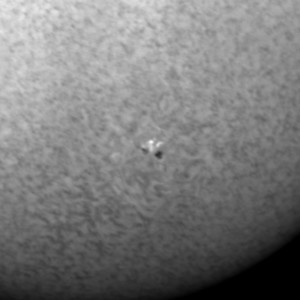 AR 12871 with sub-flare imaged about a minute prior to the flare’s 18:36 UT maximum.
AR 12871 with sub-flare imaged about a minute prior to the flare’s 18:36 UT maximum.
Solar activity is expected to remain at low levels until at least September 26.
September 23, 2021
Solar activity was elevated to moderate levels today due to two M-class flares from AR 12871. The first event was an M2.8 event that peaked at 4:42 UT, which was immediately preceded by a C5.3 flare at 4:32UT. An M1.8 flare peaked at 15:28 UT and was observed at the solar observatory today; this event was preceded by a B5.4 event at 15:14 UT. We continue to follow three spotted regions across the Sun; the two newest regions 12874 and 12875 have decayed and are nearly spotless. The left image of each region is a 0.1 second exposure in red continuum light (approximately 6561.8 Angstroms). The right image of each is a 1.0 second exposure in H-alpha line center light. All the images are cropped to 13.3′ square and recorded at the times indicated.
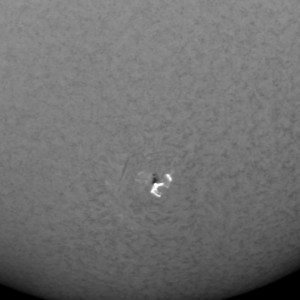 AR 12871 near the peak intensity of the M1.8/1N flare event, at 15:28 UT.
AR 12871 near the peak intensity of the M1.8/1N flare event, at 15:28 UT.
The flare image immediately above was a 0.5 second exposure to contain the intensity of the flare glow to prevent saturation of the image.
Solar activity is expected to remain at low levels through at least 25 September, but there could be another M-class flare from AR 12871.
September 22, 2021
Solar activity remains at low levels today with three small spot groups peppered across the solar disk. Two additional groups emerged in the southwest quadrant of the solar disk and were numbered AR 12874 and 12875. There was only a few C1 type flares over the past day or so. Three of the visible active regions are portrayed in image form below. The left image of each region is a 0.1 second exposure in red continuum light (approximately 6561.8 Angstroms). The right image of each is a 1.0 second exposure in H-alpha line center light. All the images are cropped to 13.3′ square and recorded at the times indicated.
Although we have begun to experience cooler, dryer, fall-like weather on this first day of astronomical fall in the northern hemisphere, a persistent stream of cirrus clouds, especially for the first part of the observation session, made for less than ideal images, especially with the red continuum images. Seeing (the atmospheric steadiness that determines how sharp or fuzzy a telescopic image is…) improved for the H-alpha images.
Solar activity is expected to remain at low levels due to possible C-class flare activity (and a slight chance for an M-class) from AR 12871 through at least September 24.
September 21, 2021
Solar activity continued at low levels today with three small spot groups peppered across the solar disk. There were a pair of C1 flare that happened today (in UT) at 9:03 and 11:53 UT that came from newly formed region AR 12873. Yet another occurred at 18:28 UT, but no information is given on the source region. Although 12871 is the largest active region currently on the Sun, AR 12873 is growing and producing flares as a result. The three active regions are portrayed in image form below. The left image of each region is a 0.1 second exposure in red continuum light (approximately 6561.8 Angstroms). The right image of each is a 1.0 second exposure in H-alpha line center light. All the images are cropped to 13.3′ square and recorded at the times indicated.
Note with the AR 12872 images (center row) that another patchwork of bright spots is visible close to the solar edge. This could be the next solar active region rotating into view. A similar feature was noted near the west southwest limb (near S27W29).
Solar activity is expected to remain at low levels due to possible C-class flare activity from either/both regions AR 12871 and 12873 through at least September 23.
September 20, 2021
Observations resumed today after a week of clouds and spotless solar disks. A new active region started to come into view on 18 September, which was actually the reappearance of old AR 12860. This old region survived its two-week passage on the far side of the solar disk and returned to our view two days ago. By convention, NOAA gives the old region a new number, AR 12871. Then yesterday another region emerged into view, AR 12872; today saw another new region near the central meridian of the solar disk, (yet to be numbered) AR 12873. AR 12871 is the largest, most complex of these three regions, and was the source for a few B-class flares.
Except for the labeled image showing two active regions, below right, each image is cropped to 13.3′ squared. The red continuum images are displayed in the top row; the H-alpha is shown in the second row. Celestial north is up, west is right in each image.
SWPC Forecast: “Solar activity is expected to be very low, with a chance for C-class activity on 20-22 Sep, due to potential flare activity from Region 2871.”
September 11, 2021
On this day I ran a short observing session to catch some last follow-up images of the active regions we’ve been following all week. The sun has been and continues to be very quiet, with very little activity coming from these regions as they get ready to depart our view, carried away by the Sun’s own rotation. The last event of note was a C1 that peaked at 15:00 UT on 11 September. From this point through the mid day of 13 September, the Sun’s X-ray output remained at B levels.
Of note was a long prominence that was observed during the session that appeared to be in the process of lifting off (third image). Not long after the image was taken, it did just that- by 11:00 UT on the 12th it had launched completely away and produced a coronal mas ejection. The story about this prominence can be obtained from www.spaceweather.com (set the date for September 13, 2021 if viewing after September 13). A time laps from the Solar Dynamics Observatory of the prominence launching can be viewed here, and the CME can be seen here.
The first image is a 0.1-second exposure continuum image. The second and third is an H-alpha line images with celestial north up and west right. The first two images are 13.3’x13.3′ and the third is 7.8’x13.3′.
We will be shut down for observations for several days due to Tropical Storm Nicholas and other duties. Solar activity is expected to remain low through at least September 15.
September 10, 2021
The Sun is quieting down further with only an occasional B-class flare here and there. The active regions are mostly stable or in decline but some parts of AR’s 12866 and 12868 are increasing in complexity, leaving a chance for an M-class flare from one of these regions. The images selected below display each of the regions currently visible on the Sun, with the exception of newly numbered AR 12870, which did not show a single spot during this morning’s spot count at 13:45 UT. The first two images are 0.1-second exposure continuum images. The third is an H-alpha line image of the active regions 12868, 12866, and 12869. Each image is cropped to cover 13.3′ squared on the Sun, with celestial north up and west right.
Solar activity is expected to remain low through at least September 12.
September 9, 2021
Solar activity continues at low levels with three of the regions sporting occasional C-class flares. Today, things seemed more quiet, with only a C3.5/SF coming from AR 12868, peaking at 8:31 UT. AR 12868 produced a B6.6 event that peaked at 10:07 UT and a B8.3 event that peaked at 17:16 UT. Otherwise things have been very quiet. Four of the below images are in H-alpha light, 1.0 second exposures. The first, in red continuum, is a 0.1 second exposure. Except where indicated, each frame measures 13.3′ squared on the sky.
Solar activity is expected to remain at low levels, with C class flares and a slight chance of an M-class flare until at least 11 September.
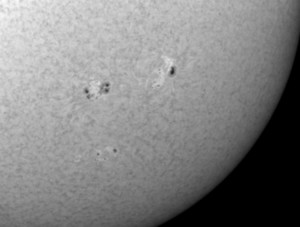 Three active regions as imaged at 22:17:59UT.
Three active regions as imaged at 22:17:59UT.
September 8, 2021
The Sun is displaying more spots and more activity. Some of the spots are in decay and are soon to depart as rotation carries them away from view, but others are developing. AR 12864 produced a C1/sf at 0:09 UT 8 September. AR 12866 generated a C1/SF at 10:26 UT today and AR 12868 released a C1/SF flare that beaked at 3:14 UT. Shortly after observations began this morning, AR 12868 generated a 29 minute long B7.6 flare that peaked at 15:11 UT. Observing in continuum we did not see this one, except for the last 5 minutes. Then, starting at 17:11UT, peaking at 17:30 and lasting through 17:49 UT was the day’s most energetic event: a C8.3/1N ribbon-shaped flare that came from the southern half of 12866, missed due to other obligations (the dome closed at 16:55 UT). Things have been quiet since.
The images in the top row are continuum images, taken in red continuum light, each 1.0 second exposure. The two images in the second row are H-alpha line center, 0.1 second exposure.
Solar activity is expected to remain at low levels, with C class flares and a slight chance of an M-class flare until at least 10 September.
September 7, 2021
The number and size of the sunspot groups visible on the Sun have increased dramatically over the last five days. AR 12863 continued to rotate across the sun, while remaining quiet, and it was soon joined by a pair of spot groups in the northern hemisphere: AR 12864 and 12865. AR 12867 formed near the west-southwest limb of the sun on September 4 and rotated out of view a day later. AR’s 12866 and 12868 emerged and rotated into view, becoming the dominant spot groups on the Sun.. AR 12865 has since decayed, losing all of its spots, leaving four groups visible on the solar disk at present. Despite the impressive appearances of AR 12866 and 12868, they have not produced much in the way of flaring activity, except for a C1 flare from 12866. Each of these major spot groups, and the leftover faculty/plage from 12865, are depicted in images below.
The first column of images depict the regions as imaged in red continuum, each a 0.1 second exposure. The second column is in the light of H-alpha line center, 1.0 second exposure. The images are cropped to 13.3′ square and have celestial north up, west right.
Solar activity is expected to remain at low levels through at least September 9. There is a slight chance of an M-class flare event from 12866 or 12868.
September 2, 2021
Since yesterday, a new active region has appeared on the disk of the Sun. AR 12863 is a rapidly growing southern hemisphere sunspot group and has produced multiple B-type events (mostly B2 to B4 level), Active region AR 12860 is in the process of rotating out of view on the west limb. A rather long-duration C1 flare occurred this afternoon and I do not yet have information as to its source, but it may be the new region. The event peaked at 21:02 UT.
Each image below is cropped to 13.3′ x 13.3′ on the sky and set so that celestial north is up, west is right. Note the H-alpha image of 12860 (right) and the prominences above the region. The H-alpha image was a 1.0 second exposure; the red continuum image is a 0.1 second exposure.
Solar activity is expected to be low to very low through at least September 4.
September 1, 2021
Active region AR 12860 is stabilizing and beginning to decay. Only two C1-type flares from this region earlier today. I could not find the spot that goes with AR 12859 during this morning’s sunspot count, which means this is continuing to decay. AR 12860 is preparing to leave the visible solar disk as rotation carries it out of view. Each image below is cropped to 13.3′ x 13.3′ on the sky and set so that celestial north is up, west is right. Note the H-alpha image of 12860 (right) and the detached prominences above the region. The H-alpha image was a 1.0 second exposure; the red continuum image is a 0.1 second exposure.
I did note and image a possible new active region (AR 12863) forming near S25 E45, which could be the next numbered region. It is looking rather impressive on GONG H-alpha images made at 23:34 UT. Will investigate this some tomorrow.
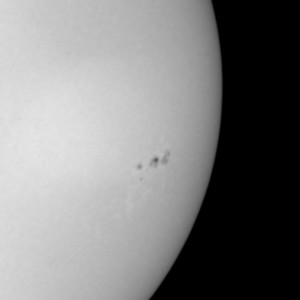
AR 12860 in red continuum light. Image was recorded at 15:56:58 UT. |
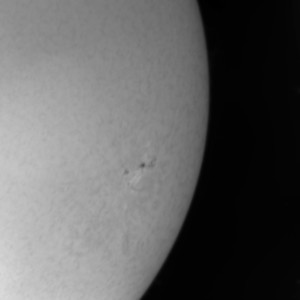
AR 12860 and some limb prominences, as recorded at 16:49:52 UT |
Solar activity is expected to return to very low values over the next few days, at least through 3 September.
August 31, 2021
Active region AR 12860 has become mostly quiet with only occasional B-type flares. It is also in the process of being carried toward the west limb by the Sun’s own rotation. The left most images shows the region in continuum red light; the center image is H-alpha line. Each of the first two images was cropped so that each forms a 13.3′ square patch on the sky. The right most image, also taken in H-alpha, shows some prominences on the northwest limb. This image is cropped to 8.4’x8.9′ in dimension. Each image is oriented so that north is up, west is right.
Solar activity is expected to remain low through at least September 2.
August 30, 2021
Active region AR 12860 has been rather active since the last observing session. Since them some 14 discrete C-class events came from this region, along with an M4 flare on 28 August at 6:10 UTC. The region was then expected to produce an X-class or additional M-class flare events. However, none have materialized through at least 23:15 UT, 30 August. Due to the frequency of flaring events, we were able to capture three such events, each pictured below near their peaks, during two short sessions this day. The active region has shown some decay in the trailing end, so it may be quieting down at this point as it prepares to rotate out of view.
The next three images capture the B-class and two C-class flares observed today. They are enlarged, showing more flare detail, and are cropped to 10.7′ squared.
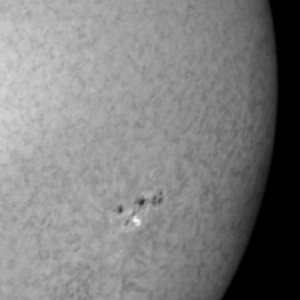
A B9 flare near peak intensity at 16:16:13 UT. |
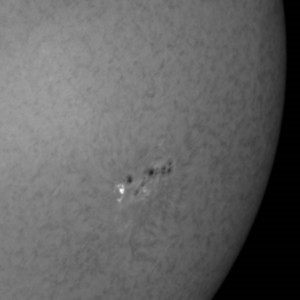
A C2 flare near its peak, as imaged at 16:24:28 UT. |
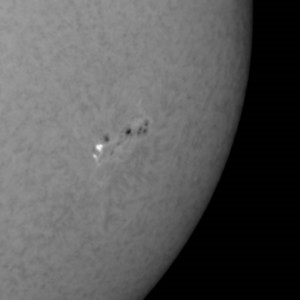
A C3 flare as seen near peak intensity at 21:34:25 UT. |
Solar activity is expected to remain at low levels through at least September 1.
August 27, 2021
There are now four sunspot groups on the solar disk, one large and complex one in the southern hemisphere (AR 12860), one not-so-large on in the solar northern hemisphere (AR 12859), a small one that formed yesterday near the eastern limb (AR 12861) and another that just formed near the western limb (AR 12862). AR 12862 may have been in flare mode (a C1 that peaked at 15:15 UT) when it was imaged during a mosaic sequence, as there was an elongated, pronounced brightening in the region. AR 12859 continued to decay, but it produced a C3/1F flare at 18:18 UT on 26 August. The C3 event sent ripples across the sun-literally (see spaceweather.com and select August 27 in the archives field in the upper right of the page if you visit after August 27th). It also was the source of a C1/SF event peaking at 19:01 UT; and a C3/sn flare peaking at 23:22 UT, both on the 26th. Today it produced an impressive-looking C7 flare event, which peaked at 21:09 UT (it was seen in the GONG imagery, unfortunately we weren’t observing at the time). So activity seems to be ramping up a bit, as AR 12860 displays some active growth and mixed polarities in its leading half.
The red continuum images in the first column were 0.5 second exposures at the times indicated. Each of the images immediately below cover 13.3’x13.3′ on the sky. The H-alpha images (right column) are 1.0 second exposures. Celestial north is up and west is right in each image.
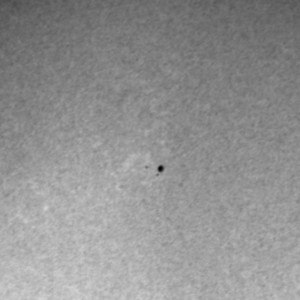
AR 12859 as imaged at 14:52:26 UT. |
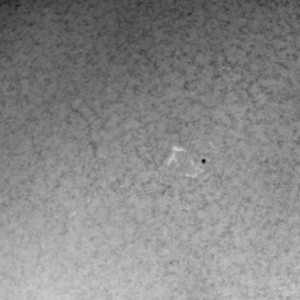
AR 12859 as observed at 16:18:11 UT. |
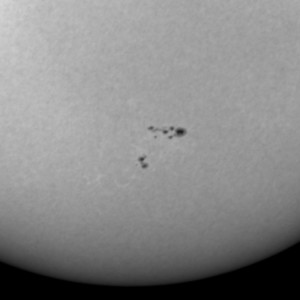
AR 12860 in continuum red light, as observed at 14:53:40. |
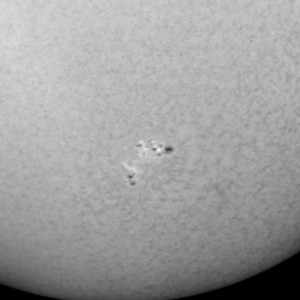
AR 12860 as seen in H-alpha light, as imaged at 15:20:58 UT. |
Solar activity continues to be very low and is expected to be thus through at least 29 August. There is a chance for more C-class flare activity.
August 26, 2021
Despite an increasing number of sunspots, some growth in AR 12859 and lengthening in 12860, solar activity remained low today. After the conclusion of the observing session, and while the skies were mostly cloudy anyway, AR 12859 released a C3 flare that peaked at 18:18 UT and lasted over two hours. The filament seen in the below image of AR 12859 is gone as of 18:44 UT (using one of the GONG full-disk images as reference). Due to the rapid spreading of the spots of AR 12860, magnetic loops are not able to interact as much, preventing large flares. This may continue to be the case indefinitely but things may change. The red continuum images in the first column were 0.5 second exposures at the times indicated. The first, of AR 12859 and (soon to be numbered) 12861 is 14.6’x13.3′; the rest are 13.3’x13.3′. The H-alpha images (right column) are 1.0 second exposures. Celestial north is up and west is right in each image.
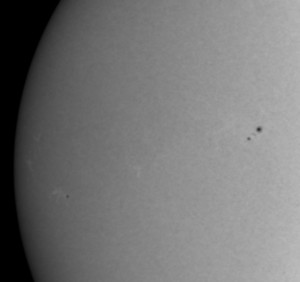
AR 12859 (right) and a new spotted region (lower left) as imaged at 14:42:08 UT. |
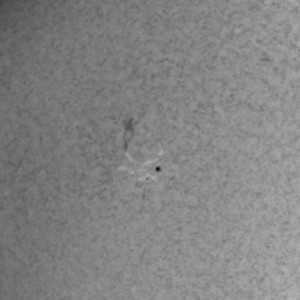
AR 12859 and filament as imaged at 14:49:08 UT. |
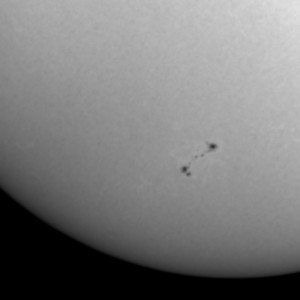
AR 12860 as imaged at 14:26:06 UT. |
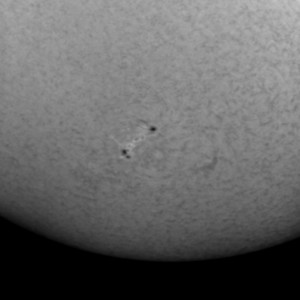
AR 12860 as imaged at 15:13:24 UT. |
Solar activity continues to be very low and is expected to be thus through at least 28 August. There is a chance for more C-class flare activity.
August 25, 2021
AR 12859 produced a C1 flare at 1:24 UT, 25 August. Since then the Sun has been very quiet with only a couple of B-class events. Each image is 13.3’x13.3′ in size, is oriented so that celestial north is up, west is right.
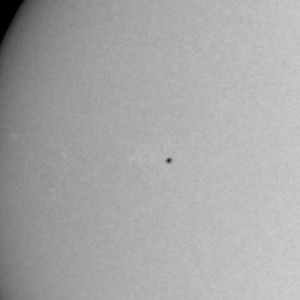
AR 12859 continuum as imaged at 16:29:50 UT. |
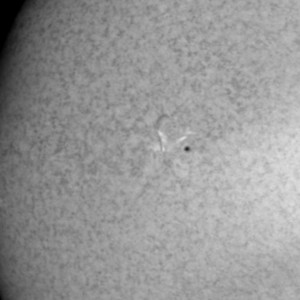
AR 12859 in H-alpha light as imaged at 20:09:45UT |
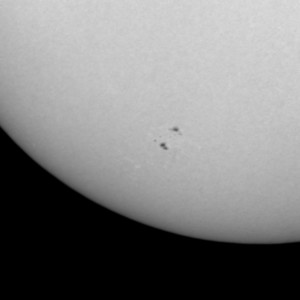
AR 12860 continuum as imaged at 16:34:41 UT. |
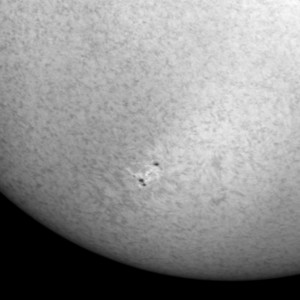
AR 12860 in H-alpha light as imaged at 20:02:22UT |
Solar activity is expected to remain low through at least August 27.
August 24, 2021
AR 12859 rotated into view on the 21st of August and has steadily decayed since. A second active region, 12860, emerged since this morning’s visual sunspot count (around 12:40 UT), when no spots were visible. Solar activity remains very low. Each image is 13.3’x13.3′ in size, is oriented so that celestial north is up, west is right.
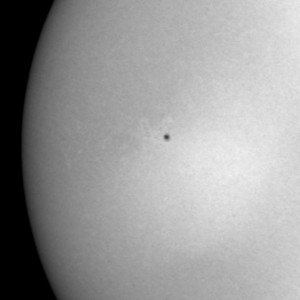
AR 12859 continuum as imaged at 20:22:02 UT. |
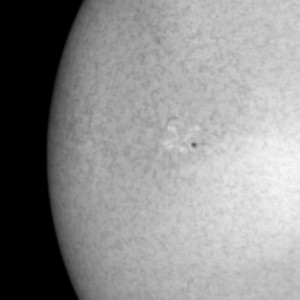
AR 12859 in H-alpha light as imaged at 20:59:06UT |
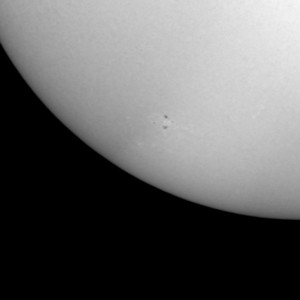
AR 12860 continuum as imaged at 21:045:40 UT. |
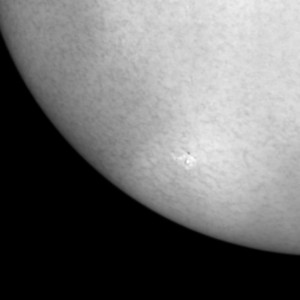
AR 12859 in H-alpha light as imaged at 21:16:36UT |
Solar activity is expected to remain low through at least August 26.
August 20, 2021
Solar activity went from very low to low thanks to three C-class flares (largest was a C3 at 15:57 UT) coming from an unseen source over the eastern limb. That source became visible after observations concluded: Active Region 12859. A large filament continues on the northeast limb and it has the potential to erupt in the form of a Hyder flare. Other than these everything remains quiet on the Sun. Each image is 13.3’x13.3′ in size, is oriented so that celestial north is up, west is right, and is a 1.0 second exposure.
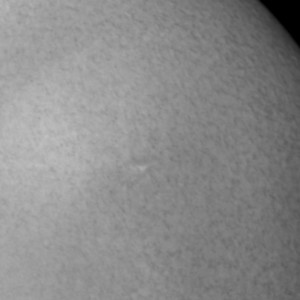
AR 12858 as seen in the light of H-alpha. Image recorded at 17:17:59 UT. |
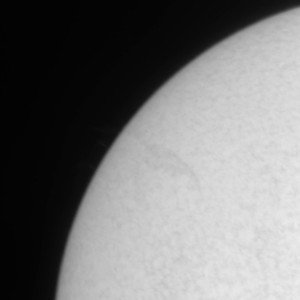
The large filament remains quiet at the time of this image, which was recorded at at 17:38:29 UT. |
Solar activity is expected to remain low through at least August 23.
August 19, 2021
Solar activity continues to be very low with only a few occasional B-class flares. AR 12853 decayed to plage and a new region, AR 12858 formed and remains rather small. The latter is highlighted in the first image; all four are indicated in the second image. Each image is 18.0’x13.3′ in size, is oriented so that celestial north is up, west is right, and is a 1.0 second exposure.
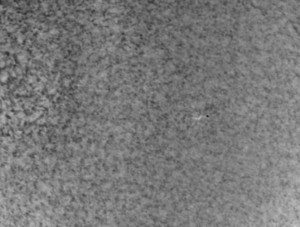
AR 12858 as seen in the light of H-alpha. Image recorded at 22:12:00 UT. |
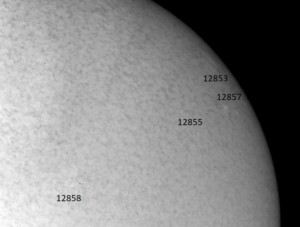
AR 12858 and plage regions 12855, 12857, and 12853 as imaged at 22:57:54 UT. |
Solar activity is expected to remain low through at least August 21.
August 16, 2021
Solar activity continues at very low levels. The most recent event was a B7 X-ray flare at 7:11 UT today; spotless AR 12856 was the source of a C1 around 21:00 UT on 13 August 2021. Only one spotted active region is visible on the solar disk (there were three two days ago during the morning sunspot count) currently with several plage regions and a couple of interesting prominences. A huge filament erupted from the farside of the Sun yesterday, August 15, at 5:08 UT. This could also have come from a significant active region which could come into view later this week. A giant solar prominence had been visible on the northeastern limb of the Sun the last three days. It is about 10 times taller than Earth and about 15 times wider than Earth. This one is rather active and unstable and could erupt soon.
The continuum image in the upper left was a 0.1 second exposure; the rest of the images are 1.0 second exposures. The top two images cover 13.3’x13.3′ of the sky; the bottom two are enlarged views of the prominences and each cover 10.9’x10.5′.
Solar activity is expected to remain at very low levels through at least 18 August.
August 11, 2021
Two small spots have appeared on the Sun this morning as seen during daily sunspot counts. One is on the eastern limb and the other is toward the southwestern limb. These did not receive numbers from NOAA because they lack development and already show signs of decay. Today was a rather short session as the Sun’s disk lack features of interest to image. The two images below show about the same region on the Sun’s disk: the leftovers of AR 12853 and one of the two single “no-name” spots. This spot was visible as a bright spot yesterday. The continuum image on the left was a 0.1 second exposure; the H-alpha image at right is a 1.0 second exposure. Both are cropped to 13.3′ square and are presented with celestial north up, west right.
Solar activity is expected to remain at very low levels through at least August 13.
August 10, 2021
Once again the Sun is spotless, with only the bright speckled remains of AR 12853 visible in the northeast part of the solar disk. Several well-formed prominences circle the limb, but the Sun is mainly devoid of spots and filaments these days.
AR 12853 is depicted in red continuum (left) and H-alpha line center (center). After producing many B-class flares and one C-class flare yesterday, the region has become totally quiet and the background X-ray level has “flatlined” at the A4 level, typical of solar minimum. The images are displaced with celestial north up, west right; the continuum is a 0.1 second exposure and the other two a 1.0 second exposure; and these are cropped to 13.3’x13.3′ size.
Solar activity is expected to remain at very low levels through at least August 12.
August 9, 2021
After a ten day hiatus, observations resumed this morning. The Sun was spotless until 2 August, when a small, high latitude active region appeared in the southern part of the solar disk. This became AR 12850 and remained visible for three days before decaying to plage and rotating out of view. Another region, 12851 followed suit, being a spot for a day (along with AR 12851 in the northern hemisphere) then decaying to plage, leaving the Sun spotless again by August 7. Then, early this morning, after rotating into view two days ago, a plage region acquired a spot and became AR 12853. This was the main subject of observation today.
AR 12853 sports a single tiny sunspot as seen in this morning’s visual sunspot counts, but there were lots of faculae. The view in red continuum is shown below left. In the H-alpha view (below right), a filament extends southward from the region. Celestial north is up, west is right in each image. Between 0:00 UT and 18:30 UT, the region released one C-1 flare and 8 B-class flares. Aside from the frequent small flares from this one region, the Sun was very quiet, with little in the way of spots and filaments.
Solar activity is expected to remain very low through at least August 11.
July 29, 2021
The Sun has become completely spotless and all the flaring activity has ceased. Therefore only a short session today. All that remains are several plage regions and a number of filaments, some of which are shown below. The filaments (dark channels) in the upper right-hand corner of the image are within the formerly active regions 12847 and 12849. The one just left and below image center is a quiescent filament that had collected itself from four short filament segments earlier this week. The image below is 18.0′ wide by 13.3′ high and is a 1.0 second exposure at H-alpha line center.
Solar activity is expected to remain at very low levels through at least July 31.
July 28, 2021
Another B-class flare occurred at 7:40 UT earlier today. The B6 level event came from AR 12846, which is now spotless. A long duration B1 event that peaked around 10:00 UT coincided with a filament launching itself off the Sun’s surface. We have been watching this filament all week, and now it’s gone.
Solar activity remains at very low levels, as the Sun continues to move toward spotlessness. Only one spot, in 12847, was seen optically with difficulty during this morning’s sunspot count. The spots of 12847 have vanished. Three more regions continue to be visible as plage only: 12844, 12848, and 12849. So today was yet another short observing session in quiet sun mode. Various small filaments continue to be visible across the solar disk.
Each of the images are cropped to 13.3′ squared. The continuum images are 0.1 second exposures; the H-alpha images are 1.0 second exposures. Celestial north is up, west is right in each image. The time taken (in Universal Time) is also recorded beneath each image. The bright spot in the H-alpha image of 12846 is an artifact introduced by the imaging system and the off-center Energy Rejection Filter.
Solar activity is expected to remain very low through July 30.
July 27, 2021
AR 12846 produced flare which peaked at 19:23 UT and another at 21:50 UT. Almost immediately after AR 12847 released a B9 flare, peaking at 22:26 UT, so apparently all is not so quiet at this point.
Solar activity remains at very low levels, as the Sun continues to move toward spotlessness. Only four spots, three in 12846 and one in 12847, were counted earlier this morning. Three more regions continue to be visible as plage only: 12844, 12848, and 12849. So today was yet another short observing session in quiet sun mode. Various small filaments continue to be visible across the solar disk. One such filament, in the eastern part of plage region 12849, launched itself off the Sun just before 4:00 UT on 27 July.
Each of the images are cropped to 13.3′ squared. The continuum images are 0.1 second exposures; the H-alpha images are 1.0 second exposures. Celestial north is up, west is right in each image. The time taken (in Universal Time) is also recorded beneath each image. The bright spot in the H-alpha image of 12846 is an artifact introduced by the imaging system and the off-center Energy Rejection Filter.
Solar activity is expected to remain very low through July 29.
July 26, 2021
Solar activity remains at very low levels, with the Sun’s disk trending toward spotlessness. Only six spots, five in 12846 and one in 12847, were counted earlier this morning. Three more regions are visible as plage only: 12844, 12848, and 12849. So today was another short observing session in quiet sun mode. A dark filament is seen east of AR 12846. Various small filaments are also visible across the solar disk.
The images of 12846 were cropped to 13.3′ square. The images of AR 12847 are full-sized, 13.3’x18.0′. The continuum images are 0.1 second exposures; the H-alpha images are 1.0 second exposures. Celestial north is up, west is right in each image. The time taken (in Universal Time) is also recorded beneath each image.
Solar activity is expected to be very low through July 28. There is a slight chance of C-class flares over the next few days.
July 23, 2021
Solar activity remains at very low levels. with all solar regions stable or in decay. So today was a short observing session in quiet sun mode. Two of the regions, AR 12842 and 12845 are essentially invisible as the rotate out of view. The remaining regions are small and unremarkable. A dark filament is seen just north of AR 12848. Various small filaments are visible across the solar disk.
The images of 12847 / 12849 were cropped to 13.3′ square. The images of AR 12846 / 12848 are full-sized, 13.3’x18.0′. The continuum images are 0.1 second exposures; the H-alpha images are 1.0 second exposures. Celestial north is up, west is right in each image. The time taken (in Universal Time) is also recorded beneath each image.
Solar activity is expected to be very low through July 24. There is a very low chance for C-class flares.
July 22, 2021
Solar activity remains at very low levels, with only a couple of C-class flares yesterday. The last such event was 20:05UT, 21 July; no further C-flares have happened since up through 18:11 UT today. Observations today were hindered by a persistent mid-level broken deck of cirrocumulus clouds, which finally evaporated early in the afternoon. The continuum (red-light) images (first row) were taken in the morning just before the expanding deck halted observations. The H-alpha images (second row) were taken during a spell of clear skies lasting almost 45 minutes. The Sun is sporting six numbered and spotted active regions, the most in recent memory. In addition, one high-latitude plage region (not shown below) continues to cross the bottom of the Sun’s disk. In spite of all these spotted regions, all the regions are small to very small and all were quiet. The most complex regions, magnetically speaking, continue to be AR 12842 and 12845, past sources of C-type flares, which are preparing to rotate over the western edge of the Sun.
The images of AR 12842 / 12845 and 12847 / 12849 were cropped to 13.3′ square. The images of AR 12846 / 12848 are full-sized, 13.3’x18.0′. The continuum images are 0.1 second exposures; the H-alpha images are 1.0 second exposures. Celestial north is up, west is right in each image. The time taken (in Universal Time) is also recorded beneath each image.
SWPC predicts that solar activity will remain at very low to low levels, with only a small chance of C-class flares (barring any sudden surprise eruptions) through at least July 24.
July 21, 2021
Solar activity remains at low levels. In addition to the two main sunspot groups that had been visible on the solar disk the past few days, two more have emerged or reemerged and one has rotated into view. South of AR 12842, AR 12845 has re-emerged as a spotted region and had been producing minor flares (along with 12842 earlier today). One such event was imaged and is shown below- a B6 class flare as seen three minutes before its peak. AR 12848 was seen as a bright plage spot yesterday; today it had grown two spots. Another region (not shown) is AR 12847 which just rotated into view. Also, high latitude region AR 12844, is currently a spotless plage region near the solar central meridian (also not shown). Finally some prominence activity was observed on the east southeast limb earlier today.
The images below depict each of the active regions, in continuum red light (left column) and H-alpha line center light (right column). Exposures were 0.09 seconds for the continuum images and 1.0 second for the line center images. Each image was cropped to a size that covers 13.3′ square on the sky, and is oriented with celestial north up, west right.
Solar activity is expected to remain low through July 23, with a chance of C-class flares.
July 20, 2021
Solar activity remains at low levels. Two main sunspot groups are now visible on the solar disk, and three more have decayed to plage / faculae. The two groups were the foci of observations today. The images below depict each of the active regions, in continuum red light (left column) and H-alpha line center light (right column). Exposures were 0.09 seconds for the continuum images and 1.0 second for the line center images. Each image was cropped to a size that covers 13.3′ square on the sky, and is oriented with celestial north up, west right. No flares were seen during the observing session but an interesting dark filament appeared and dispersed northwest of AR 12846, moving at nearly one earth diameter every two minutes or so.
Solar activity is expected to remain very low through July 22, with an increasing chance of C-class flares.
July 19, 2021
Observations resume today with a quiet Sun. There had been some sunspot groups visible over the last 12 days, but none have been particularly active. All of the activity had been on the Sun’s farside, with at least three Coronal Mass Ejections launched over the last two weeks. The region believed responsible for all this is expected to rotate into view over the next few days. Today, five such regions are visible on the Sun’s disk, three of which have spots. One region, on the eastern limb of the sun (soon to be named AR 12846) is that region, old AR 12838, which was the source of the first X-class flare of Solar Cycle 25 on July 3. Today, it appears quiet, but we will be watching it over the next several days for additional activity.
Each image below is presented with celestial north up, east left. Each is cropped to 13.3′ square to focus on the relatively small regions and to minimize fringe artefacts near the edges and corners. The first image was a 0.1 second exposure; the other two are 1.0 second exposures.
Solar activity is forecast (by the Space Weather Prediction Center) to be very low from today through the 21st of July. As of this writing, at 21:00 UT, there have been two “slow-motion” C1 events (peaked at 19:04 and 20:50 UT; preceded by a B7 event at 17:50 UT), possibly due to some prominence activity on the eastern limb as seen with the GONG H-alpha data viewer (gong2.nso.edu).
July 7, 2021
A relative break in the clouds this afternoon allowed for a short observing session. Active Region 12835 has rotated out of view, leaving a handful of tiny spotted regions in the northern solar hemisphere. These are depicted below. The top row of images, in continuum red light (left) and H-alpha emission line (right) show AR’s 12837 and 12840 (indicated). Each image is 13.3 square and were 0.1 second exposures, taken at the times indicated. Celestial north is up, west right in all four images below.
The bottom two are of AR 12839 (arrowed), which has become quite tiny and hard to see. The left is the region in continuum light at 0.1 second exposure; the right is the region in H-alpha light at 1.0 second exposure. The apparent undulations in the right image is due to persistent thin mid-level cloudiness that began to form in place as the skies began to cloud back up.
Solar activity remained low, with AR 12835 producing several C-class flares before rotating out of view. The other three regions were inactive and in a state of decay. Solar activity is expected to be very low through at least July 9.
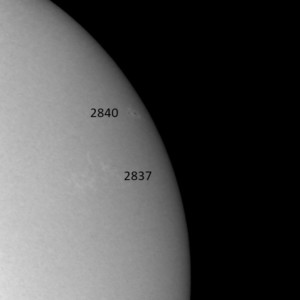
18:34:44 UT. |
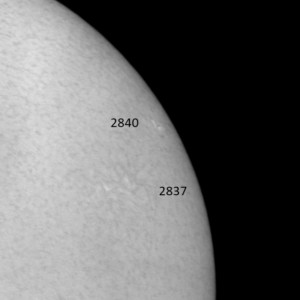
18:57:40 UT. |
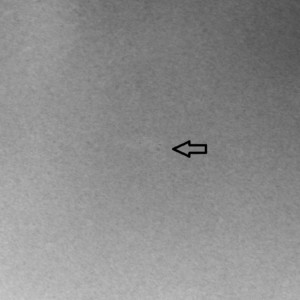
AR 12837 at 18:35:47 UT. |
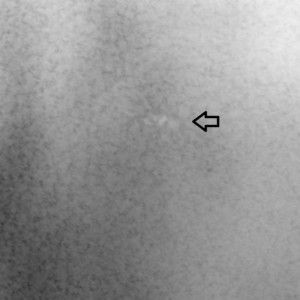
AR 12837 at 19:07:07 UT. |
This will be the last posting until July 19, due to a combination of unsettled weather expected over the next few days, and I will be on travel from late this week through the end of next week.
July 6, 2021
Since the last observing session, a few surprises from the Sun. On July 3, a series of significant flares occurred, mostly from a new active region that sprang up rather suddenly near the west limb before rotating out of view a day later. On July 3, at 14:30 UT, this new region, AR 12838, unleashed an X1.5 flare, the first such flare in 4 years. This region was also a source of 3 M-class flares from 7:30 UT, July 3 to 5:10 UT on July4. Since then the Sun has been mainly quiet, with only occasional C-class and B-class flares.
Today the Sun has been mainly quiet, but there had been occasional B-class flares, and two C1 flares later in the day. All of this activity, except for a C1 flare from AR 12836 (at 18:43 UT on 5 July; the region is now a spotless plage region on the limb) is from AR 12835, which is in the process of rotating out of earthly view. It leaves behind two small, stable regions, AR 12837 and AR 12839. Another region, AR 12840, appears to be emerging northwest of 12837, and is pictured below. Each of the images are cropped to 13.3′ square to remove edge artifacts from processing and are oriented so that celestial and solar north are up, west is right.
Solar activity is expected to remain very low through July 8.
July 1, 2021
Solar activity continues to be low or very low, even with a naked-eye spot near the center of the disk. AR 12835 continues to be the object to monitor for potential M-class flare activity; however as of this writing (21:15 UTC), the region has been quiet. The region 12836 also remains quiet as does 12837, even with the tripling of the number of spots since yesterday within this region.
The below images each cover 13.3’x13.3′ on the sky. The first column images are taken in red continuum and were each 0.1 second exposures at the times indicated. The second column were taken with H-alpha line center, 1.0 second exposures at the times indicated. The top row is AR 12835 (main group) and 12836 (small spot below and right of large spot); the bottom row is AR 12837. No other numbered active regions are visible on the disk at this time.
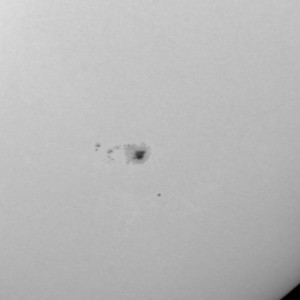
AR 12835/36, continuum, 15:03:43 UTC. |
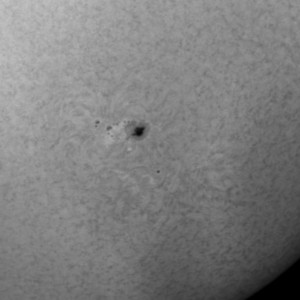
AR 12835/36, line center, 15:46:10 UTC. |
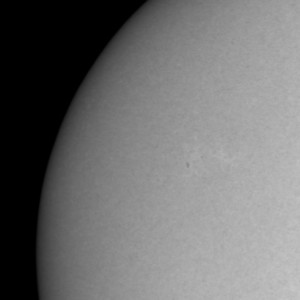
AR 12837, continuum, 15:19:09 UTC |
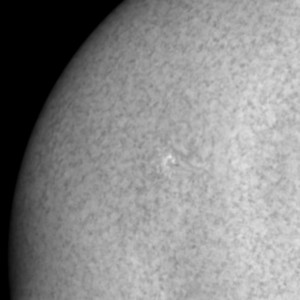
AR 12837, line center, 15:34:39 UTC. |
Solar activity is expected to remain low through at least July 3. There is still a slight chance of M-class flares from AR 12835.
June 30, 2021
Solar activity continues to be very low. None of the visible active regions have been very active, flare-wise. Active Region 12835 has a complex beta-gamma-delta magnetic configuration, making it a prime candidate for M-class flaring. So this was the region we monitored primarily today. It remained quiet during the entire session with the exception of a C-1 flare at 17:28 UT. We needed to close by 18:00 due to the chance of rain so we missed the second flare from the exact same location, which peaked at C-3 level at 18:15UT.
The active region 12835 has been displaying small bright spots that come and go during today’s session. These are “Ellerman bombs”, magnetic explosions that are about a millionth as powerful as a typical solar flare. But a single event releases the energy equivalent to about 100,000 World War II atomic bombs. Ellerman bombs arise from the magnetic complexity of this active region, as fields of opposite polarity come in contact with each other. Magnetic reconnection then takes place and this releases energy.
Active region 12827 is also shown below, but this region is small, quiet and simple.
Despite the growing complexity of AR 12835, Space Weather Prediction Center forecasts low solar activity with a slight chance for M-class flaring, through July 2.
June 29, 2021
A surprise clearing of the skies this day provided an opportunity to observe a growing sunspot complex. This is AR 12835, which was observed five days ago on the limb of the Sun. When it rotated into the view the next day it looked like a small pair of spots, which grew as the region rotated into better view. It still remained rather simple as of 27 June but this morning, during the visual sunspot counts, I’ve noticed it become considerably more complex, prompting today’s observing session to watch for flares and other activities. Since 20:00 UT on June 27, to the time of this writing (20:31 UT, 29 June) there has been two C-class flares (including a C1 event that peaked at 19:11 UT on 28 June, from AR 12835) and numerous B-class events; the Sun had been very quiet prior to this. Most of these came from the growing active region, which was monitored for two hours this morning (before the clouds and rain returned).
Two days ago, another active region, AR 12835, emerged south of the big region and is also shown in the below images. Another active region, AR 12837, rotated into view in the northern solar hemisphere a little over a day ago. These two regions are stable and have not exhibited significant flare activity.
During today’s watch, there was a B6 flare event that proceeded quickly, and can be seen in the fourth image below as a bright spot near image center. That image was taken near the peak of the flare. Notice the dark material just above the flare, still present after the flare itself fades. These are examples of some of the changes that we watch for during our flare patrols. The images below show how the region changed in appearance over the two hour observing session. Each image is cropped to 13.3’x13.3′. The first is a continuum image, a 0.1 second exposure, focusing on the spots themselves. The remaining images are in H-alpha at or near line center. Light and dark areas in the second image are due to processing and/or passing clouds.
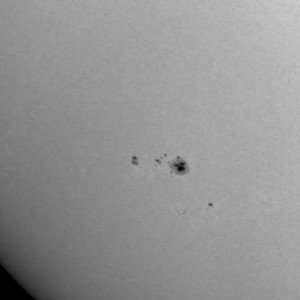
13:49:52 UTC |
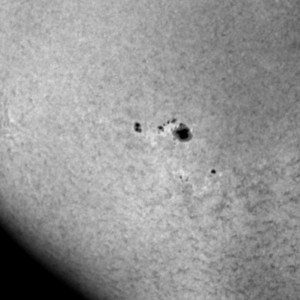
14:02:46 UTC |
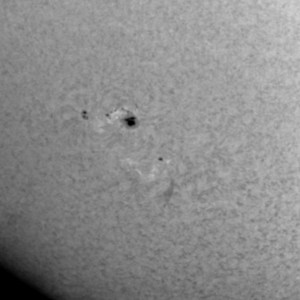
14:30:33 UTC |
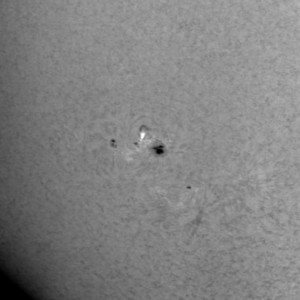
14:42:34 UTC |
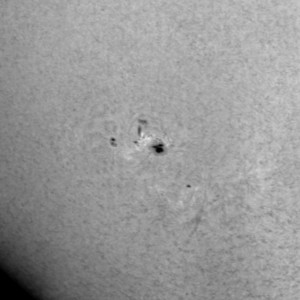
14:45:36 UTC |
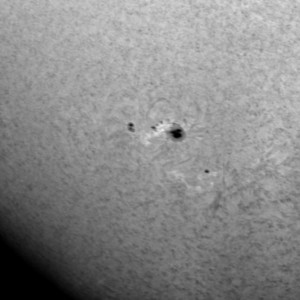
15:44:36 UTC |
Despite the growing active region, Space Weather Prediction Center forecasts very low solar activity with a chance for C-class flaring, through July 1.
June 24, 2021
The Sun remains at very low activity, with the exception of a few minor B-class flare events at 11:55, 17:16, and 19:14 UT. The were B1, B2, and B2 (X-ray class) events, respectively.
AR 12833, which has been crossing the Sun’s disk for the last two weeks, is about to cross over the solar horizon in a day or two. It remains rather large but quiet, a single, simple spot, the only spot visible on the Sun currently. Expected active regions have, so far, only showed up as faculae and plages. There was a region of interest right on the east limb (shown below), which included some surging activity and is possibly the cause of the flare events today. The image was taken just before the third flaring event, which lasted from 17:45 to 20:45 UT.
There remains a slight chance for a C-class flare event over the next three days. NOTE: The “possible active region” mentioned below became Active Region 12835 as it rotated into view the next day.
Solar activity is expected to remain very low through at least June 26.
June 23, 2021
The Sun remains at very low activity, with the exception of a long-duration C3.4 flare that peaked at 7:07 UT from behind the east-northeast limb. This is a region about to rotate into view within the next 24 hours or so. Meanwhile, 12833 is nearing the west-northwest limb. It is presented in two view: red continuum and h-alpha line center, below. In addition, some spotless plages are visible near the east-northeast limb (arrowed) but are not the source of the flare. The flare source is further east of these. Also, about 11-o’clock a prominence is visible on the limb of the Sun, one of three similar-sized featured observed today.
Solar activity is expected to remain very low through 25 June. There is a slight chance for another C-class flare during this time frame.
June 22, 2021
Observations resumed as the clouds clear out by mid afternoon. The Sun continues at a very low level of activity with only a single sunspot visible: AR 12833. This region remained unchanged during its journey across the face of the Sun, and is approaching the western limb. Aside from a filament and two prominences, the Sun is essentially featureless.
Things could change as satellite data indicate three active regions on the far side of the sun, one of which produced a significant flare and CME. There are signs that the first may be about to rotate into view, at least there are spots of faculae on the east limb as seen by imagery and during visual sunspot counts. We will monitor the Sun through June 24 to look for these features as they rotate into view. However the Space Weather Prediction Center predicts that the Sun is expected to remain very quiet through June 24.
Each image is cropped to 13.3′ square. Celestial north is up and west is right in each image.
June 17, 2021
PROGRAM NOTE: The cooling has been restored in the old solar observatory building, but not in the larger solar observatory addition building. The former provides a “cooling center”, if needed, so observations resumed today. We will take it day by day depending on conditions, inside and out.
Solar activity continues to be very low. The only spot that continues to be visible on the solar disk is AR 12833, which is AR 12824 on its second rotation. This single spot grew by 20% in surface area, otherwise it is unchanged as it marches across the Sun’s disk. Some faculae are seen trailing the single, round spot; there are filaments visible in H-alpha behind this spot. One filament was presenting itself as a prominence two days ago. Filaments and prominences are the same phenomenon: tubes of gas suspended high above the solar surface. They are filaments when they appear in absorption against the solar disk; on the limb of the Sun they appear bright against the dark background of space. The filament that was south of AR 12832 is now visible as a prominence on the western limb (below).
The first two images show AR 12833 and its solar quadrant in continuum and in the emission line. The first was a 0.1 second exposure and the second a 1.0 second exposure. Each is 13.3’x18.0′ in size on the sky. The prominence image is 13.3′ square; a 2.0 second exposure stretched to favor the prominences. The spots in the dark sky are artifacts of the image processing. Celestial north is up and west is right in each image.
Solar activity is expected to remain very low through 19 June 2021, at least.
June 15, 2021
PROGRAM NOTE: This will be the last observing session until repairs are completed on the Observatory’s A/C system.
Solar activity continues to be very low. The only spot visible on the solar disk presently is AR 12833, which is AR 12824 on its second rotation. Some faculae are seen trailing the single, round spot; this faculae are likely the remains of parts of 12824 and 12826. The prominences on the Northeast and Southwest limbs are still present and have changed a little since yesterday.
The Sun could be in for a “termination event”, which could boost sunspot number and solar activity in general. This is an interesting concept which has been advanced in an attempt to explain some aspects of the sun’s activity. The story can be found at https://spaceweatherarchive.com/2021/06/11/the-termination-event/.
Each of the below images (except where indicated) measures 13.3′ on a side, except for the AR 12833 images, which are 18.0’x13.3′. Each images is 0.09 sec exposure, except for the prominence image, which is a 2.0 second exposure, and the H-alpha active region images, which are 1.0 second exposures. Celestial north is up and west is right in each image.
Solar activity is expected to remain very low for the next three days, at least.
June 14, 2021
Solar activity was very low as the Sun has become almost spotless. Only a single prominent spot is visible; this rotated into view two days ago but is entirely quiet. This spot, now called AR 12833, is actually old AR 12824 which has remained intact during its two-week passage on the far side of the Sun, and has been brought back to our view by solar rotation. No flaring activity has taken place the last few days and this is expected to continue for the next few days.
Each of the below images measures 13.3′ on a side. Each images is 0.09 sec exposure, except for the prominence image, which is a 2.0 second exposure. Celestial north is up and west is right in each image.
Solar activity is expected to remain very low to low for the next three days, at least.
June 11, 2021
Solar activity was very low as the Sun has become almost spotless. The active region responsible for a flare and a CME has not appeared over the southeast solar limb yet but a string of weak plage regions, possibly the remnants of active regions on a prior rotation, are seen in the southeastern part of the Sun’s disk. AR 12829 continues to decay; in this morning’s spot count at 13:37 UT, no spots were seen, only faculae (the continuum and photospheric version of plage). Only a handful of tiny spots remains of AR 12832. Today’s short session focused on these and the prominence that has been on the southwestern limb much of the week. This feature is 205,000 km (123,000 miles) long and 88,000 km (53,000 miles) tall.
Two minor B-class events happened before the observing session: a B2 at 8:02 UT and a B1 at 12:45 UT. Otherwise the GOES X-Ray Flux remains rather steady at the A/B boundary. The prominence on the southwest limb remains, changing shape as solar rotation changes its orientation with respect to our line of site (compare today’s image with previous days’ images).
Each of the below images measures 13.3′ on a side, except for the prominence image, which is smaller (8.0’x5.9′). Each images is 0.09 sec exposure, except for the prominence image, which is a 2.0 second exposure. Celestial north is up and west is right in each image.
Solar activity is expected to remain very low to low for the next three days, at least.
June 10, 2021
Solar activity continues to be low, with two inactive spot groups visible on the solar disk. AR 12829, which we’ve been following since last week, continues its slow decay, displaying only two spots visually as it nears the limb of the Sun. AR 12832, which formed a couple days ago, remains small and inactive. I’ve seen 8 spots and pores associated with this active region, which has crossed the solar central meridian. A nearby filament is marked with tick marks in the H-alpha image of 12832.
A C1 flare happened at 6:42 UT today from an active region along or just behind the southeast limb (possibly the active region detected on the far side of the Sun a few days ago). This launched a Coronal Mass Ejection that was first observed by SOHO at 7:00 UT. The western limb flare activity has quieted down, as can be seen by the decline in background X-ray flux as measured by GOES satellites.
The prominence on the southwest limb remains, changing shape as solar rotation changes its orientation with respect to our line of site.
There may be renewed activity once the above-referenced region rotates into view. However, the visible active regions are in decay mode and may not display much activity over the next few days.
June 9, 2021
A quick glance at a real-time solar image revealed something interesting going on with the Sun, at 19:29 UT. So we re-opened for the afternoon session and followed this event from 19:44 until 20:03 UT. The event was largely over by 19:55 UT.
We continued to follow active regions, old and new, as they cross the disk of the Sun. Solar activity remained low (but not very low) due to several C-class flares that came from beyond the northwest limb/edge of the Sun. A C3 flare peaked at 9:07 UT and likely came from AR 12831. There was also a large eruption of a plume of plasma (below, as seen in extreme UV from Solar Dynamics Observatory) at 11:59 UT. A sharp peak at C2 level coincides with this event. This is superimposed upon a longer duration C1 event that peaked at 12:32 UT. The X-ray flux has been steadily declining ever since, up to the time of this writing (18:34UT).
The two images immediately below come courtesy of NASA and Solar Dynamics Observatory and are presented in false color.
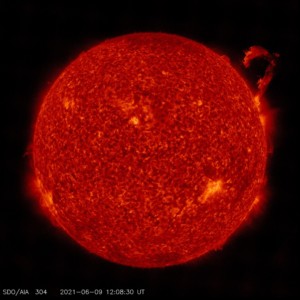 |
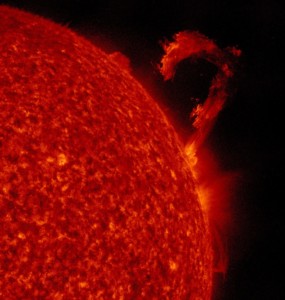 |
The active region 12829 continues to decay and remains inactive. AR 12830 has rotated over the limb and is no longer visible. An unnumbered active region has emerged near the center of the solar disk and was observed today; it remains quiet and may grow, or may decay immediately without receiving a numeric designation. Otherwise, few filaments and a handful of prominences are visible on an otherwise very quiet solar disk. The images below are cropped to 13.3’x13.3′ to focus on the feature of interest and to remove calibration artifacts.
The last image, the western limb, shows a much quieter environment than at this time yesterday. The region 12831 continues to move further over the solar “horizon”, with the Sun itself shielding us from the direct effects of its activity. Solar activity is expected to remain at very low levels over the next three days.
June 8, 2021
Since the last observing session five days ago, the Sun has rotated on and carried away the regions imaged last week across the disk. 12827 and 12829 continued to march across the disk, staying simple in appearance as they moved along. Early on the 5th of June, a new region started emerging east-northeast of 12827, and some new growth in spots was seen in 12829. The new region never received a number, as it was dissipated by the 6th of June. However, another new region began to form south of 12827, in the southern hemisphere. This was east of the plage that made up 12828 and became AR 12830. Yet another region emerges north of 12827, and this became AR 12831. AR 12830 grew some, as did 12831, but both were nearing the solar limb. In the meantime, AR 12829 crosses the solar meridian.
Early this morning, the regions 12831 and 12828 have rotated over the solar limb; 12827 is just visible on the edge, and 12830’s spot is still visible close to the edge. A C1 flare peaked at 10:53 UT on the 8th; a C2 peaked at 17:23 UT, and another C1 occurred, peaking at 19:08 UT, all likely from AR 12831, just over the limb. So this became the region of focus this morning, and the C2 flare was observed to peak a couple minutes before clouds halted observing for that moment.
Lots of lesser activities, possibly also from 12831, have occurred throughout the day. The other regions visible on the Sun remain quiet. Another active region is expected to rotate into view in the next day or two.
June 3, 2021
For the second day in a row, the day starts mostly sunny. So more observations were carried out until the sky became overcast by noon local time. We continued to follow the two visible active regions as well as a few faint filaments and prominences. Solar activity continues to run at very low levels, with the Space Weather office reporting no flares the previous day, although they attribute “a few B-level enhancements” to 2829. The GOES X-ray flux plot shows a spike towering above the rest, an impulsive event peaking at X-ray level B5 at 2:05 UT. Lesser B-class flares are coming from AR 2829, according to Spaceweather.com. However, AR 2827 was the target region for our monitoring today since it has a slightly more complex beta magnetic field configuration, versus alpha for AR 2829. Beta configurations are more prone to activity than alphas.
The images depict these regions in red continuum light and H-alpha line center light. I have noticed that the 2.0 second exposures, originally used for prominences, seems to bring out the H-alpha detail more. We have been using 0.1 second exposures to “freeze” the seeing, but the counts and contrasts are low with our existing neutral density filter in place. A lighter filter that we have on hand lets in too much light, as does no filter, even at 0.1 second. So we may be looking at longer exposures under certain conditions, as we continue to improve the way we do solar observations.
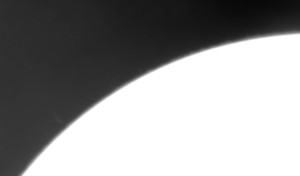 This image, oriented south up, shows a small “flame” coming off the edge of the Sun. This is a prominence, captured in this 2.0 second exposure at 16:04:23 UT.
This image, oriented south up, shows a small “flame” coming off the edge of the Sun. This is a prominence, captured in this 2.0 second exposure at 16:04:23 UT.
Unfortunately the weather forecast calls for lots of rain and clouds from this afternoon through at least Tuesday of next week, so today’s observations may actually be the last for a while. The solar activity is expected to remain very low through at least 5 June 2021, with a slight chance for C-class flares.
June 2, 2021
This day dawns unexpectedly clear and the clear skies lasted into mid morning, with variable cloudiness thereafter. The Sun has quieted down since last week’s bit of activity, which culminated with a long-duration C-9 flare event that started around 21:30 UT on May 28, peaked at 23:13 UT, and lasted until after 10:00 UT on 30 May 2021. This event was likely from the same active region that was observed exactly 24 hours earlier, which was carried out of view last weekend by the Sun’s rotation. This video shows a 2-1/2 hour sequence of the Sun’s activity as seen at 304 Angstroms (far UV) showing a “lightning bolt” stretch across the Sun from AR 12824. This covered the period that we observed the Sun from the ground on 27 May 2021.
Since then, the active regions responsible for all the activity rotated out of view, and as they were doing so, another region appeared over the eastern solar horizon. Active Region 12827 rotated into view on 29 May. Appearing the next day, in the opposite hemisphere was AR 12828, as a single, lone sunspot. AR 12827 grew somewhat in size and complexity as it was carried across the Sun by its rotation, while 12828 remained a simple dark core the size of the Moon. By June 1, AR 12828 became spotless as 12827 slowly grew. Another region begins to appear over the eastern solar horizon; this would become AR 12829, the second in the southern solar hemisphere in the last few days.
We were able to monitor these regions, and a few other features of interest, during today’s observing session. AR 12827 appears to be starting a decay as its trailing spots have shrunk or vanished. AR 12828 is spotless, but does display a bit of activity as a dark surge (streak) was observed at its location (shown in the image below). And AR 12929 appears to be growing a bit as it is carried into better view by the Sun’s rotation as seen from Earth. A C1 flare event peaking at 4:31 UT on 1 June 2021 is the most energetic event from the Sun since early May 29. Space Weather Prediction Center’s products do not give any information as to the source of this flare. They observe that solar activity is “very low” and will continue to be so today and over the next three days.
Each of the images below were cropped to cover a square 13.8′ on a side. Celestial north is up and west is right in each image. Exposure time was 0.1 second for each except for the one that emphasizes the prominences on the eastern solar limb- the exposure time here is 1.0 seconds. The first column of images below were taken in red continuum light; the rest were taken in H-alpha line center; the times of each are recorded with each image and region identity.
Unfortunately the weather forecast calls for lots of rain and clouds from this afternoon through at least June 9. However, if any more surprises happen with the weather, we will be observing. The solar activity forecast through June 4 indicates very low activity with a slight chance for C-class flares.
May 27, 2021
Under variably cloudy skies, some observations of an increasingly quiet Sun were made. The two active regions 12824 and 12826 are being carried away by the Sun’s rotation and will rotate out of view in a few days. The latter region has evolved from being a ring group to being a bipolar group. No significant events have occurred as of 1812 UT today. The image at left includes the two regions in continuum light; the one at right is line-centered H-alpha light of these regions. Each images is presented full-sized (13.8’x18′, celestial north up).
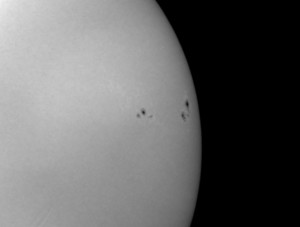
AR 12824 and 12826 in continuum; image was taken at 15:48:09 UT. |
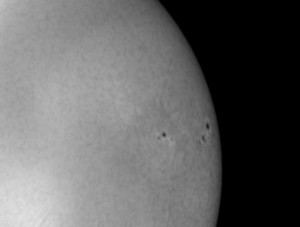
AR 12824 and 12826, in the light of H-alpha. Image was taken at 16:14:58 UT. |
May 26, 2021
After an extended period of poor weather, we are able to resume solar observations this day. A considerable amount of activity took place in batches over the last 12 days, to include a few M1-class flares and a large number of C-class flares. Many of these came from Active Region 12824, which rotated into view a little more than 10 days ago. Two days ago, a small cluster of pores became visible west of 12824, and a day ago, they developed significantly into a ring-shaped sunspot group. Today this group further developed and a large lead spot has emerged. Both are easily imaged in the same field of view and were followed today while the weather allowed. Skies started mostly cloudy, improving to partly cloudy by early- to mid-afternoon. Three highlight images are presented below, each cropped to a square 13.8’x13.8′. The first shows a continuum image of the active regions: 2824 is near center and 2826 is closer to the sun’s edge. The second and third are emission line images showing the regions in a relatively quiet state and near the peak of c1.o X-ray class. A second flare was imaged, in part, later in the session; this one peaked at C3 at 20:40 UT but clouds interfered with its observation. This one came from 2826, and is also the source of yet another C3 flare at 21:24UT.
May 14, 2021
Persistent cloudy weather prevented observations until this afternoon, and the weather is forecast to be unsettled for an extended period of time starting tomorrow. Active Region 12822, the source of much activity earlier, has quieted considerably; to its south 12823 remained quiet throughout its transit of the solar disk, carried along by the Sun’s own rotation. West of 12822, another spot group was in the process of forming during today’s observations, so we documented some interesting phenomena with it. The continuum images were made through a thin layer of cirrus, some of which shows in the image of 12823. The skies were clear for the H-alpha images. Finally the last image, bottom, shows one of the interesting “dark” events that were observed this afternoon with the new active region. Each of the first four images are shown at full size, 18’x13.8′.
The above is a close up of old and new: the old AR 12822 left of center and a new region right of center with a dark loop arching above it. This loop was observed to expand and fade over the span of a few minutes. Several additional dark surges were observed over the course of the observing session. This image covers 9.3’x6.5′ on the Sun and was taken at 19:51:15 UT. For all of the above images, celestial north is up, west is right.
May 10, 2021
Since the M3.3 event three days ago, the Sun has trended quieter with each passing day; with two C-class events on 8 May and three (possibly two, the second with two peaks) on 9 May. So today was flare watch day in the event a major flare were to occur, but the sun remained quiet all day, with only a B1 event as the strongest event of the day (which occurred well before the day’s observations). Two distinct regions are visible today, the active spot group 12822 and a second, smaller spot group, which has been unnumbered as of this writing but will likely be designated AR 12823 (which is what it will be called here). Both regions remained quiet during the observing session, which was plagued with convective cloudiness. The region monitored most of the time was the larger and (potentially) more active of the two.
Observations will be suspended until at least Thursday the 13th as more cloudy, rainy weather is expected to move in again. The trend in solar activity is back toward low levels as well.
May 7, 2021
The long-awaited active region 12822 rotated into view today and was the source of an M3.3 flare event at 19:00 UT. Unfortunately I was only able to get a fuzzy image through the clouds during the afternoon. This image was obtained at 21:44:34 UT.
The below image is a plot of the X-ray level at geostationary orbit by the GOES satellite, showing the X-ray intensity curve of the flare.
May 6, 2021
Very quiet conditions persist for the Sun, as it features a nearly featureless disk as seen through safely-filtered continuum telescopes. Sunspot number is again 0 this morning. The feature that we have been following continues to slowly “march” across the Sun, being faintly visible as a small cluster of white spots in white light imagery. This feature does have a magnetic signature as the comparison with the magnetogram from the Solar Monitor website shows. The black-white bi-polar pattern is typical of a simple sunspot group or the leftovers of a sunspot group.
We continue to obtain 10-image mosaics several times each day, with no significant active region to monitor.
A spot group may rotate into view before the end of the week. Weather conditions at our site are expected to deteriorate by then.
May 5, 2021
Very quiet conditions continue for the Sun, as it features a nearly featureless disk as seen through safely-filtered continuum telescopes. Sunspot number is 0 this morning. Nonetheless there is one feature of interest near the eastern edge of the Sun, a couple of bright spots that are termed faculae in white light, plage in H-alpha and Calcium-K. This may be what was left of the old AR 12809, which crossed the Sun’s disk as a small spot two months ago. One month ago it appeared as a plage/faculae region, as it does today. Oftentimes solar regions continue as “shadows”: old regions of bright spots that marked the location of a former spotted region.
One of the activities that we have historically done at PVSO is try to track active regions over multiple solar rotations. The Sun rotates once every 27 days or so, thus it takes nearly two weeks for the Sun’s own rotation to carry a region from one end of its disk to the other as seen from Earth. Then the region is hidden from view for two weeks. That is, unless we have “eyes” on the other side of the Solar System to see the “dark side” of the Sun. We do to an extent-in the form of the STEREO spacecraft. STEREO images from yesterday indicate a sizable active region may be working its way toward the east northeastern limb from the far side, and could become visible later this week.
In the meantime routine imaging continues, with the sample of today’s observations presented above. The images are full-sized (18.0’x13.8′) and presented with celestial north up, west to the right.
May 3, 2021
The Sun has returned to its very quiet, spotless self as the three active regions monitored last week were carried out of view early last weekend by the Sun’s own rotation. So today featured one set of 9 panels for a continuum image mosaic and two 10-panel mosaics for two H-alpha mosaics. Each of the H-alpha sets are separated by 45 minutes. Hence the quiet sun mode of observations.
Solar activity is expected to remain low unless this region develops, or another rotates into view or emerges.
April 28, 2021
Today was a poor day for solar observations but I wanted to get at least a few images of the active region complex that has graced the face of the Sun the last several days. Despite these regions being present, there has not been much activity over the last three days. The last C-class event peaked at 2:35 UT on 26 April 2021; since then only occasional B-class mini-flare events have occurred.
In spite of mostly cloudy skies from dome opening (lasting the rest of the day) I was able to get a few (just a few) images of the active region complex as it is moving toward the Sun’s southwestern limb, carried along by solar rotation. The continuum and emission line images are shown below. Each covers the full camera FOV of 18.0’x13.8′ and is oriented so that celestial north is up, west is right. As is normally the case, each image was bias and dark corrected and flat field corrected, and levels set for optimal viewing and display. The active region designations are provided in the April 26 entry, on the continuum image.
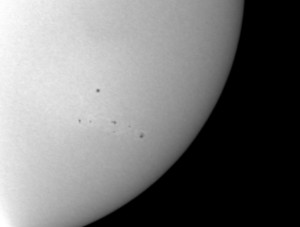
Red light continuum of three active regions, AR 12818/12820/12821, as observed at 16:48:23 UT. |
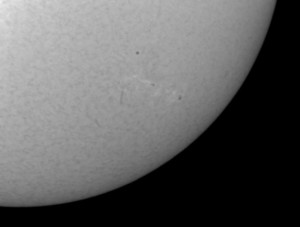
H-alpha image of same area of Sun, showing the three active regions, as observed at 18:21:47 UT. |
Solar activity is expected to remain low as these active regions continue to slowly decay and rotate out of view.
April 26, 2021
Since the last observing session, three new active regions emerged on the Sun. Two of these emerged just west of existing region 12818, the first on 24 April (AR 12820) and the second by 25 April (AR 12821). In the northern solar hemisphere, AR 12819 emerged briefly but decayed within a day or so. AR 12818 continued to decay as the Sun’s rotation carried it closer and closer to the western solar limb (celestial west) and is now little more than an area of plage. It did not go out quietly, as it continued to release C-class flares until recently.
The recent activity with the multiple solar regions reminded me of an earlier paper published on “sunspot nests” (Pojoga and Cudnik, 2002), whose abstract can be viewed at https://link.springer.com/article/10.1023/A:1019694620942. The main difference is that this clustering occurred on a much shorter timescale than what is described in the paper.
Despite less than favorable weather today, I conducted a brief observing session to obtain follow up images of these regions. The skies were mostly cloudy with cirrostratus covering 70 to 90 percent of the sky. Nonetheless, I was able to use thin spots and small breaks in the clouds to obtain the images below. The active regions are indicated in four-digit format. The first image covers 16.3’x12.0′ and the second covers the full 18’x13.8′ of the system’s aperture. Celestial north is up, west is right in each image.
Skies are expected to clear later this afternoon so I will resume observations (weather permitting) at that time.
April 22, 2021
There was a flurry of activity on the sun last night, with six C-class X-ray flare events from 4:40 to 14:45 UT today. The culprit seems to be the active region 12816. It was recorded as it released one of its flares, a C3.8 class solar flare, the video of which can be seen below. This is taken in the light of extreme ultraviolet light, a filter very different from the one we use, and one that needs to be used in space, since Earth’s atmosphere completely blocks this kind of light. The image was captured by the Solar Dynamics Observatory.
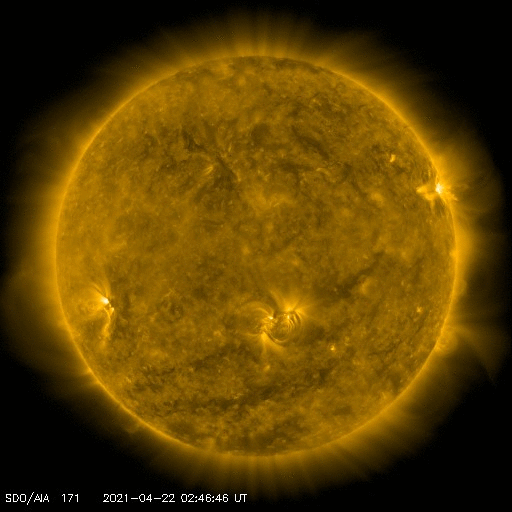
The solar regions had quieted down considerably by the time today’s observing session started. There was a small C1 class flare recorded on AR 12816 (below) but the observing session was cut short by overspreading cloud cover. Some technical issues with the calibration this morning also introduced some shading anomalies. The three visible active regions are portrayed, along with a nice prominence display on the southeast limb of the Sun. Each image covers 13.8′ square on the sky (to remove processing defects). Celestial north is up and east is left in each image.
April 21, 2021
The Sun is quieting down again. Since the M1.1 flare of two days ago, the sun has been relatively quiet with only two C-class flare events and many smaller events and fluctuations. Three active regions were followed this afternoon, two of which looked quiet and the third appearing rather active as it nears the edge of the Sun. This third active region will be carried out of view in two days but is likely the source of the x-ray fluctuations noted today.
The regions are shown in the images below. The top half of the table shows the continuum images; the bottom row shows each corresponding region in H-alpha. The images cover 18’x13.8′ of sky and are oriented so that celestial north is up, west is right. The times of each image’s acquisition are recorded below each image, along with the active region number of each spot group.
April 20, 2021
Solar activity has picked up significantly since yesterday. The active region 12816 unleased a strong M1.1 flare that peaked at 23:42 UT yesterday (it was cloudy here when it happened) and took over three hours to subside. This region was selected for flare watch today but it remained quiet during the period of observation from 16:05 to 19:24 UT. A second region which emerged less than 48 hours ago is AR 12817, looked more active and was watched as well. Two mini-flares of B5.5 X-ray class occurred during today’s observation period, one of which was observed.
The below images show the subtle changes in AR 12817. The first image was taken in red continuum, the next two in emission line light. Almost two and a half hours separate the two H-alpha images. Like the images above these were cropped to 13.5′ square and presented with celestial north up, west right.
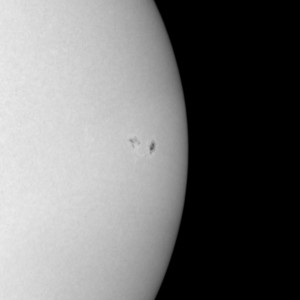
Image time 16:08:12 UT |
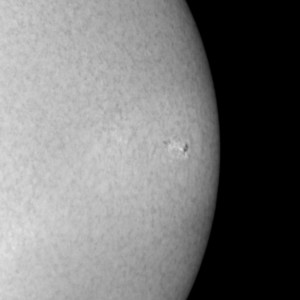
Image time 16:50:30 UT |
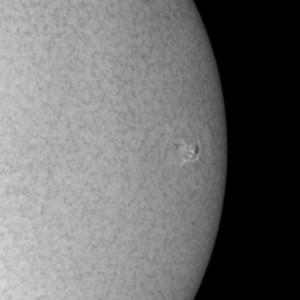
Image time 19:23:54 UT. |
Except for a C-class flare event peaking near 12:15 UT on 20 April 2021, no further M- or C-class flare events were noted in the GOES X-Ray Flux plot through 22:15 UT on 20 April 2021. The Sun may be quieting down again after a brief burst of activity. Stay tuned…
April 19, 2021
After a three week hiatus due to weather, absence of solar activity, and other factors, observations resumed today with solar activity ticking upward. Prior to this day, a series of small active regions have been visible in the Sun’s southern hemisphere. Each region lasted a few days before dissipating or rotating out of view. The latest is active region 12816, which is in the southeastern quadrant of the solar disk. This latest stretch of mild solar activity began a little over a week ago after four days of a spotless Sun. Today, yet another new region emerged in the northwest quadrant of the Sun, soon to be named AR 12817, which appears to be the most active of the two regions currently visible. Yet another region, an unnamed spot (seen in the images of AR 12816) is starting to rotate into view. The two regions currently readily visible, 12816 and 12817 are shown in images below.
Apparently Solar Cycle 25 is proceeding ahead of schedule, with solar maximum expected to arrive earlier than originally predicted. The latest update on the current solar cycle can be seen at https://spaceweatherarchive.com/2021/04/17/solar-cycle-update-2/.
March 29, 2021
Solar activity remains very low with only two spots (in one spot group) visible on the photosphere of the Sun today. This is Active Region 12812, now located west of the solar central meridian, in the northern hemisphere of the Sun. It is being led by what is left of AR 12811, only a patch of faculae/plage nearing the western limb of the Sun. This part of the Sun’s disk was imaged earlier, showing the two regions as they appeared in white light/off band (left) and H-alpha (right). The large bright area in the middle is an artifact of the processing. An SBIG STF 8300M camera was used. The field of view covered in each 0.09 sec image is 18.0′ wide by 13.8′ tall. Seeing was good and skies were clear at imaging time.
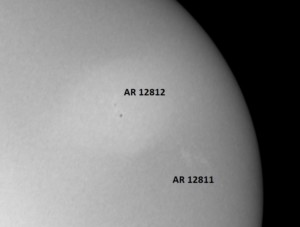
Two active regions are visible in this red continuum image, obtained at 15:49:33 UT. |
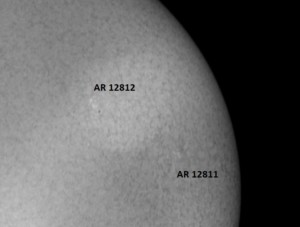
Same regions, in the light of H-alpha. Image recorded at 16:15:25 UT. |
March 23, 2021
After another storm system cleared the area in the early morning hours, we were able to resume observations. The weather was clear but rather dusty as dust kicked up by the winds is moving through the area. Since the last observations, the Sun had become very quiet again and spotless for several days. However, now some new spot groups have rotated into view, while the remnants of another group crosses towards the opposite side of the disk. Even with the addition of these latest spot groups, no significant flaring activity has occurred or is expected.
There may be more activity in the near future. The southeast limb is displaying some activity reminiscent of what occurs just before an active region rotates into view. We will be watching this region to see if anything new appears over the solar horizon in a day or two (as the weather permits). The image below was taken at 17:03:06 and is shown with celestial east up, north to the right. The image covers 9.5’x5.7′ on the sky. The activity can be seen along the limb, especially toward the right side of the frame.
I plan to install the new SBIG ST8300 camera and test it out for the afternoon session. The images produced by this camera each take up more space. We will be working with this camera over the coming weeks to integrate it into our observing program for both solar and celestial observations.
This image was captured with the SBIG STM 8300 camera and covers nearly a quarter of the solar disk. The two active regions of interest are visible in the image at top center (12812) and right of center (12811). The image was calibrated in the standard manner after being captured at 22:05:36UT. Throughout the day, the solar activity remained very low with no events noted.
March 17, 2021
After the storm system cleared the area in the early afternoon we were able to get an observing session in. There is a new active region, AR 12810, that has, in the last couple of days, rotated into view. It is the latest in a parade of low-activity, small active regions that last only a few days. Regions 12808 (also pictured) and 12809 (very indistinct plage remnant region) have decayed so they are not visible visually during the daily sunspot count. Several small prominences (one pictured below) and two small filaments were also imaged during today’s afternoon session.
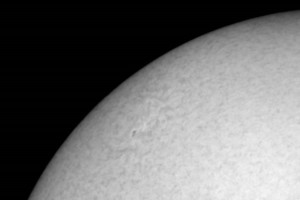
AR 12810, as imaged at 20:31:45 UT. |
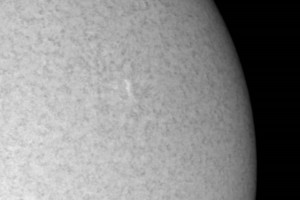
AR 12808 (white spot) as seen at 20:58:47 UT |
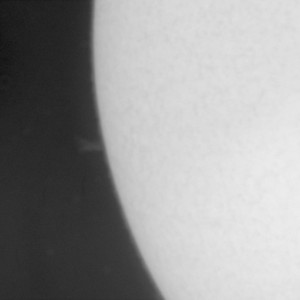
A filament sticks up over the eastern (celestial) edge of the Sun in this image taken at 20:42:10. |
Celestial north is up, east left in each of the above images. The two active region images cover 14.5’x9.6′ on the Sun, while the prominence image is cropped to 9.6’x9.6′. Each image is shown to the same scale as the others.
March 15, 2021
Over the past weekend, on March 13 to be exact, the 32-year anniversary of a significant solar event occurred. It was the day the Sun brought darkness to millions in Quebec, Canada. The resulting solar storm also produced northern lights, Aurora borealis, that were visible as far south as New Orleans and Houston. More about this historic event can be read here.
The Sun today is much quieter than it was at this time in 1989. Two decaying active regions are the only notable features on the Sun, and these are difficult to see. They were imaged during today’s short session (below). The first, AR 12808, is so subdued that I’ve included an arrow to point the way to the region. The second, AR 12809, is a little easier to find, appearing as two segments of brighter plage amidst an otherwise monotonous background. Each image is displayed with celestial north up and celestial west toward the right, and spans the full field of view, 9.6’x14.5′.
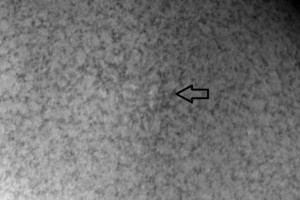
AR 12808, as imaged at 18:30:55 UT. |
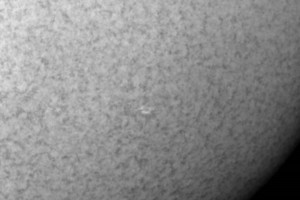
AR 12809, as it appears at 18:25:11 UT. |
March 8, 2021
The Sun continues in a very low activity state. An interesting event happened: AR 12806 re-emerged as a spot group two days ago, growing 10 times larger at one point than it’s earlier appearance. Now it, and the remains of AR 12807, are about to be carried out of our view by the Sun’s rotation. We conducted a brief session today to capture these regions as well as other regions of interest, as the high clouds started moving in. Aside from the occasional B-class and A-class flare event, not much is happening event-wise on the Sun.
March 3, 2021
The two active regions were monitored for a short time again today. There were several C- and B-class flares between 0:00 and 3:30 UT (the largest being a C1 at 00:03, from developing region AR 12807). Since then, the Sun has returned back to a quiescent state. Each region has a beta magnetic type and covers between 10 and 20 millionths of a solar hemisphere and each has a Z-type (classification) of bxo. With these factors, it seems, presently, that these groups pose little threat for significant activity.
AR 12806
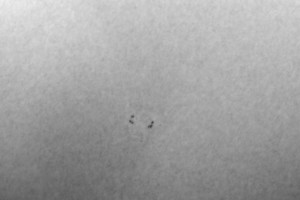
This off-band/continuum image was recorded at 17:07:53 UT. |
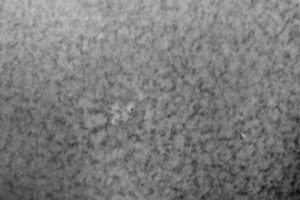
The H-alpha emission line image was obtained at 17:30:21 UT. |
AR 12807
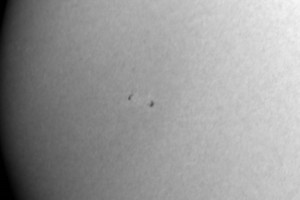
The off-band/continuum image was collected at 17:10:49 UT |
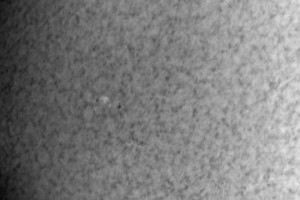
The H-alpha emission line image was captured at 17:33:54 UT |
Eastern Limb Prominence, as observed at 18:34:20 UT
The active region images each span 14.5′ wide by 9.6′ tall, and are oriented with north up, celestial west right. The prominence image was cropped to 9.5’x9.5′ and is oriented the same way. No unusual events or changes were observed in these features during the nearly two-hour observing session.
March 2, 2021
After a delayed start due to some strange technical glitch, this short observing session recorded the whole-sun mosaic as well as two emerging active regions. These have not been numbered yet but I had given them provisional designations of 2806 (the region near disk center, or 2 degrees E, 30 degrees S in solar coordinates) and 2807 (the region closer to the edge, 48E, 19S). The designations will likely differ from what I defined them. The latter region appears to be fast growing, the site of at least one B-class flare event. The former region is growing more slowly. The regions observed last week have rotated out of view, leaving the Sun’s disk briefly blank before these two small clusters of flux emerged on the visible solar disk.
Each of the above images is displayed so that celestial north is up, west is right, and are cropped to 9.5 arcminutes square (to remove a prominent artifact from the processing). Each was made in the light of H-alpha with the Meade 16-inch and SBIG camera in the east dome of the Prairie View Observatory.
February 23, 2021
We continue to monitor the two new active regions (NOAA 12804 and 12805) as well as other features of interest on the Sun. Currently, the remnants of AR 12803, which trail 12804 (see yesterday’s image) are being monitored as well as a filament near 28W, 32S and a large prominence on the southwestern (celestial) limb. These regions emerged between 8h and 18h on 22 February 2021 and are slowly growing. They, especially AR 12804, have been the sources of small B-class flares, one of which was observed yesterday. However, today, the soft X-ray background has become quiet again, with mostly ripples and mini-flares.
The images below show each region in offband (white light or continuum-similar to what is seen through a typical solar telescope setup) and onband (H-alpha centerline). The tones, shades, bright spots and sharp edges are image processing artifacts. Each image was cropped to cover 9’x9′ of the Sun to focus more on the region of interest and to remove even more artifacts near the edge of the image. The last image, at bottom, is the hedgerow-type prominence, which has been stable the last couple of days. Images were obtained at the times indicated.
Prominence as seen at 17:23 UT.
February 22, 2021
After an extended time of very low solar activity, coupled with a major IT outage and a major unseasonable winter storm and their associated impacts, everything has stabilized to enable a return to solar observations. Another catalyst to re-start observations today was the appearing of two new active regions along the solar central meridian. There is one in each solar hemisphere with the northern region already displaying activity in the form of B-class flares (one was captured during the afternoon observing session). The remnants of another region, AR 12803, were also imaged.
Each of the below images were taken at the designated time. The first is completely offband, the second about 0.6 Angstrom blue-ward, and the remainder on-band (all H-alpha). Each is 9.6′ tall by 14.5′ wide, with celestial north up, east left. The annotated image was obtained two minutes after the peak of the B6 flare that was imaged.
February 3, 2021
Observations were cut short this morning by incoming clouds, which covered most of the sky before the mosaic images were captured. The sun is back to being spotless except for a tiny remnant spot from AR 12801, which has become all but invisible in the image. The flat field from the previous day had to be used in the calibration process. The image shows the same region of the sun as yesterday’s image, but is cropped 11.3 arcminutes by 9.6 arcminutes. The prominence (arrowed in yesterday’s image) is still faintly visible in today’s image, which was recorded at 16:20:31 UT.
February 2, 2021
The above image represents the extent of the current solar activity: few prominences and tiny active regions (arrowed). Elsewhere on the Sun only a few filament fragments are seen. Today’s program essentially involved resuming the routine and re-familiarizing to the process. The initial off-band/”white-light” images were of poor quality, due to a combination of seeing and focus problems, so are not shown here. The active region/spot group, provisionally named AR 12801, was the main focus of the short session. Once the H-alpha filter was fully on-band, images for a mosaic were collected, before checking on the spot and a broken crown filament within the Sun’s north polar region. Solar X-ray activity is very low, in the lower A-range of X-ray class. No flares have occurred in recent days. The image was obtained at 17:56:13 UT on 2 February 2021. The image covers a rectangular region 14.5 arcminutes wide by 9.6 arcminutes tall, with celestial north up, west right.
Images posted in 2020 can be accessed here.

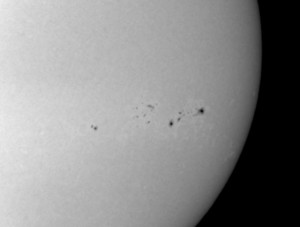
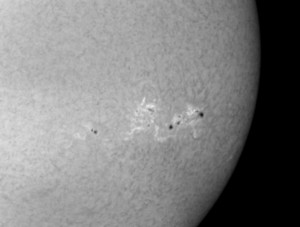
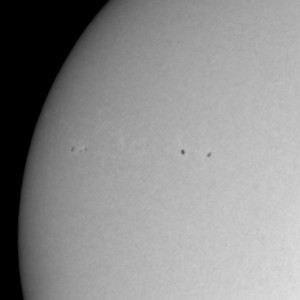
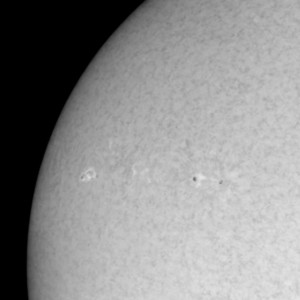
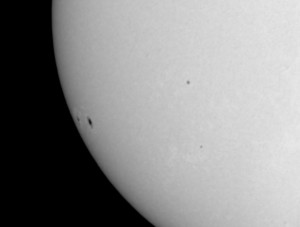
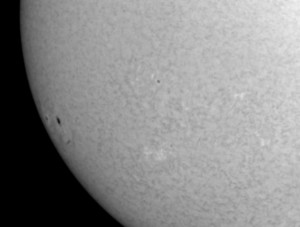
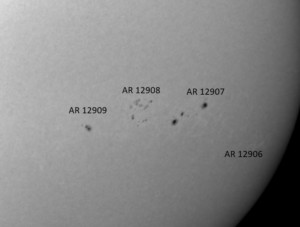
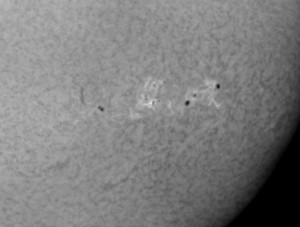
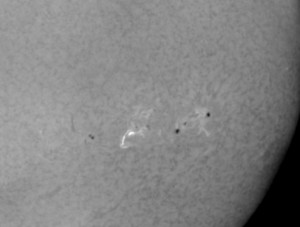
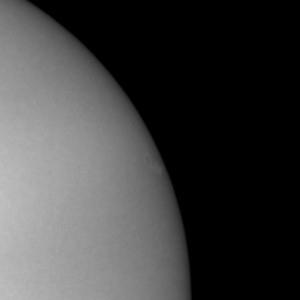
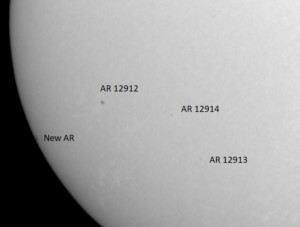
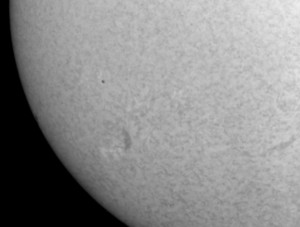
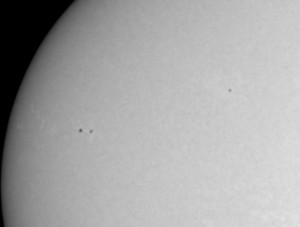
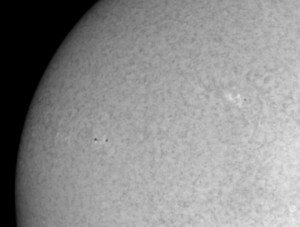
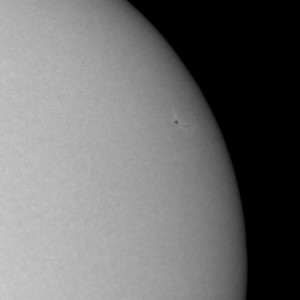
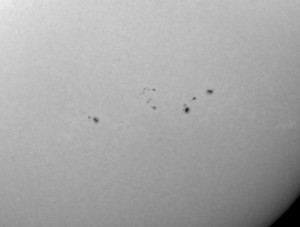
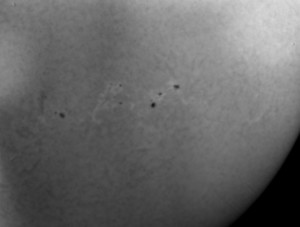
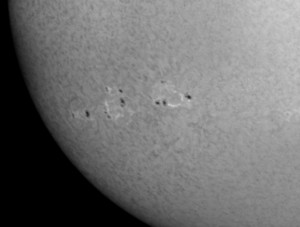
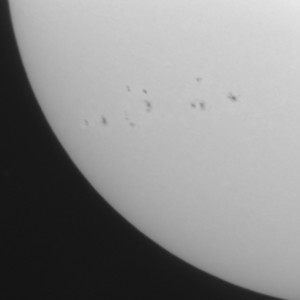
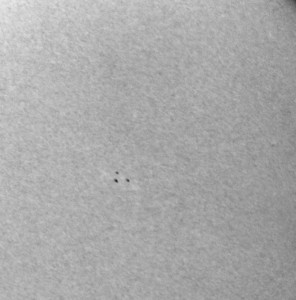
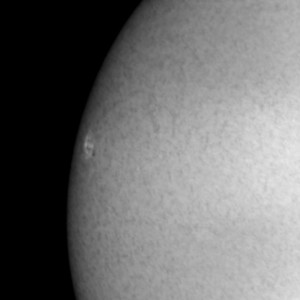
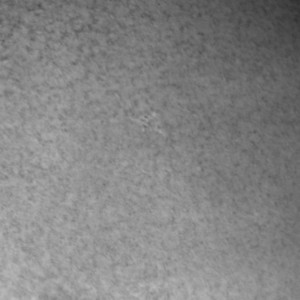
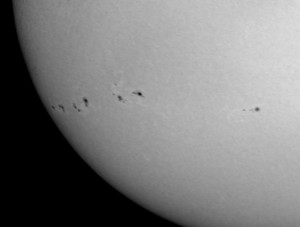
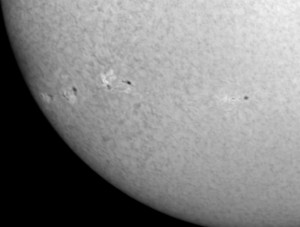
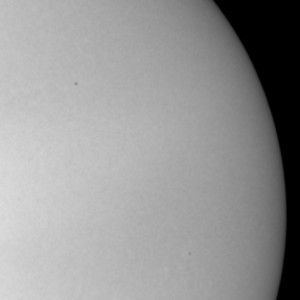
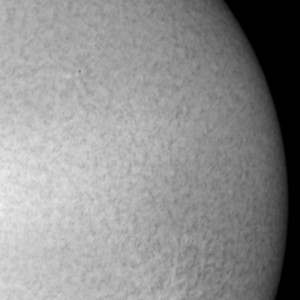
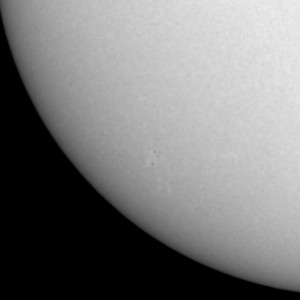
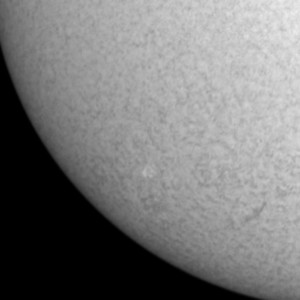
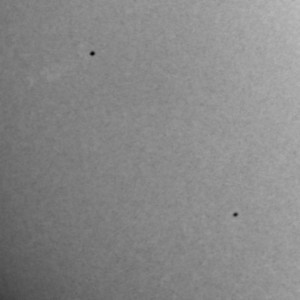
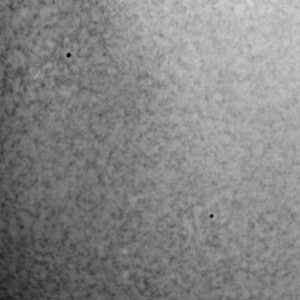
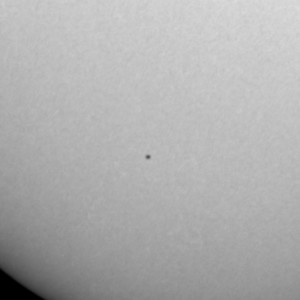
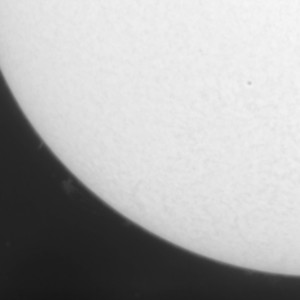
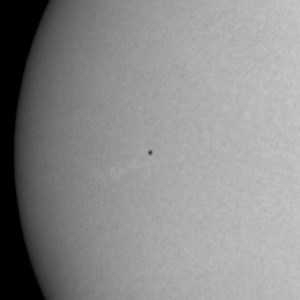
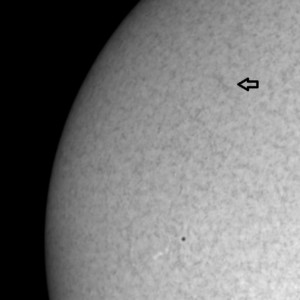
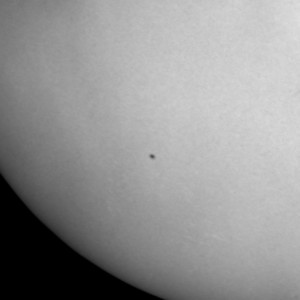
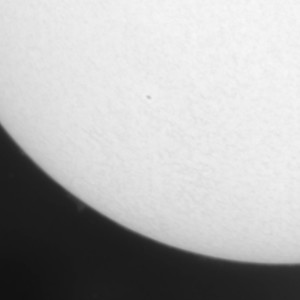
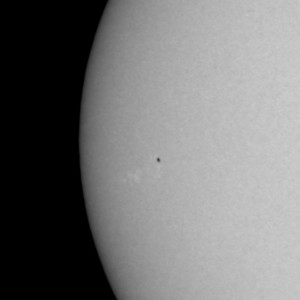
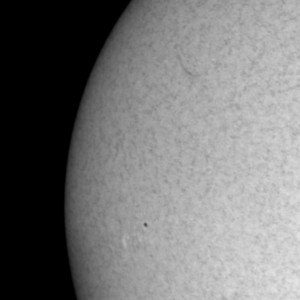
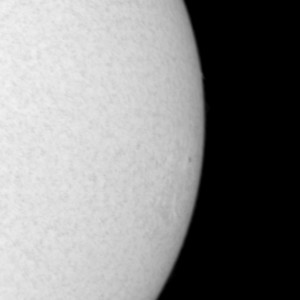
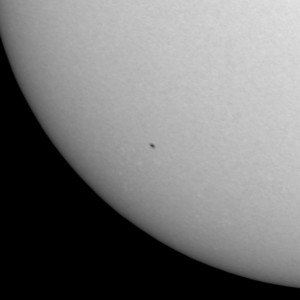
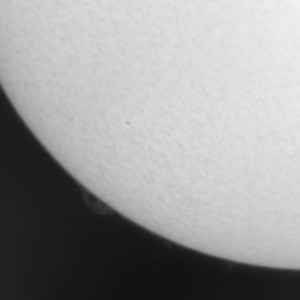
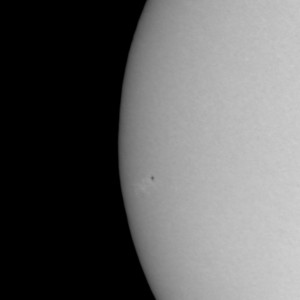
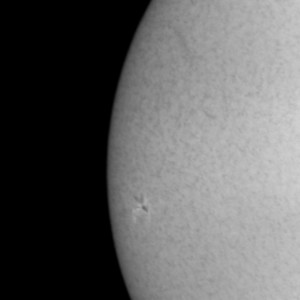
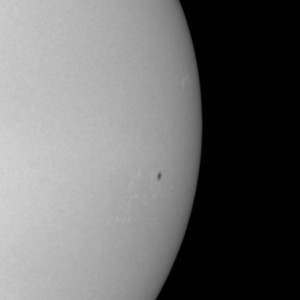
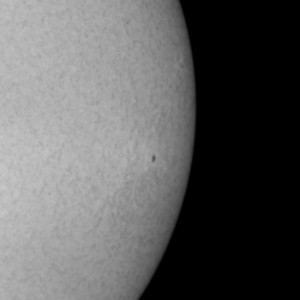
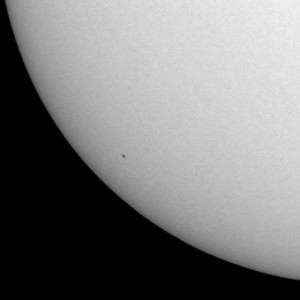
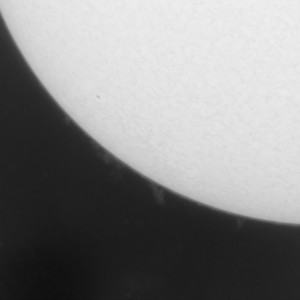
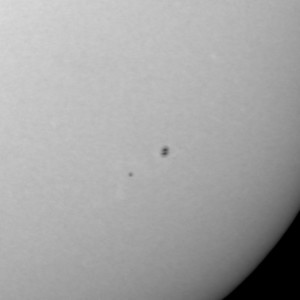
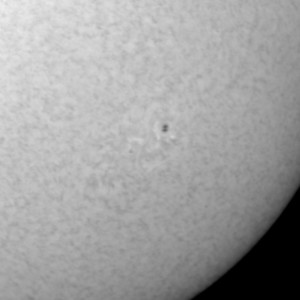
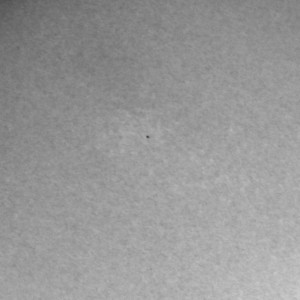
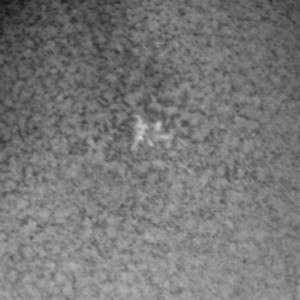
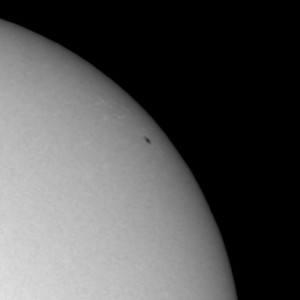
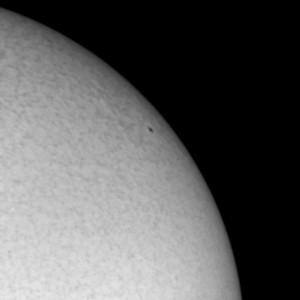
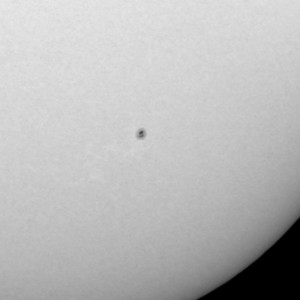
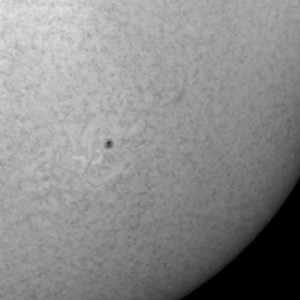
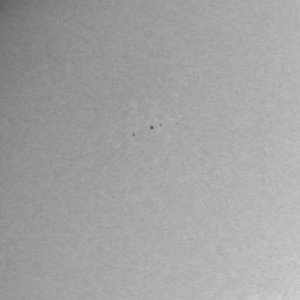
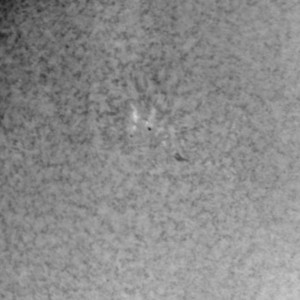
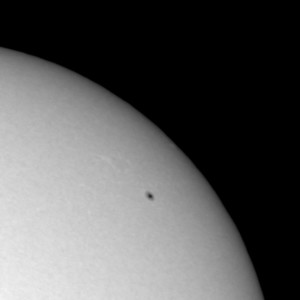
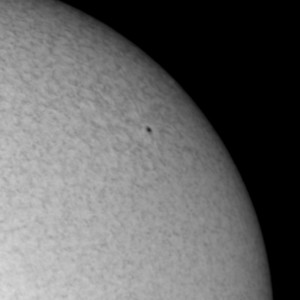
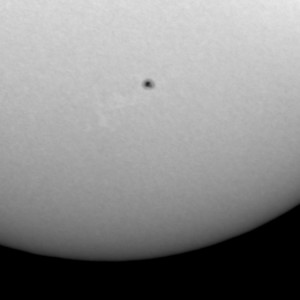
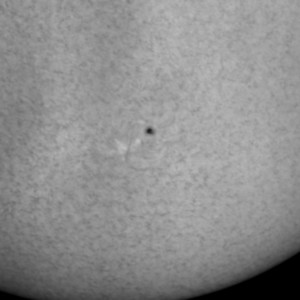 AR 12894 in H-alpha light, displays some interesting features, such as a filament. This image was recorded at 18:36:10 UT.
AR 12894 in H-alpha light, displays some interesting features, such as a filament. This image was recorded at 18:36:10 UT.